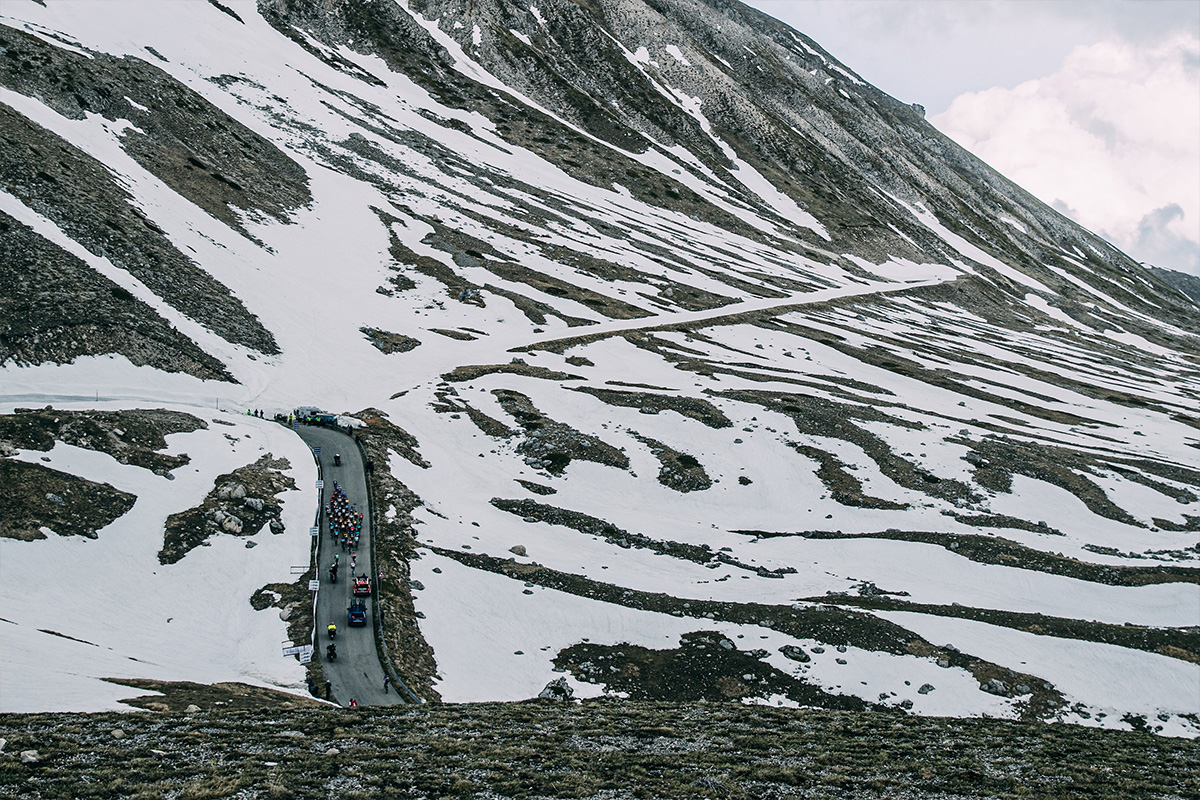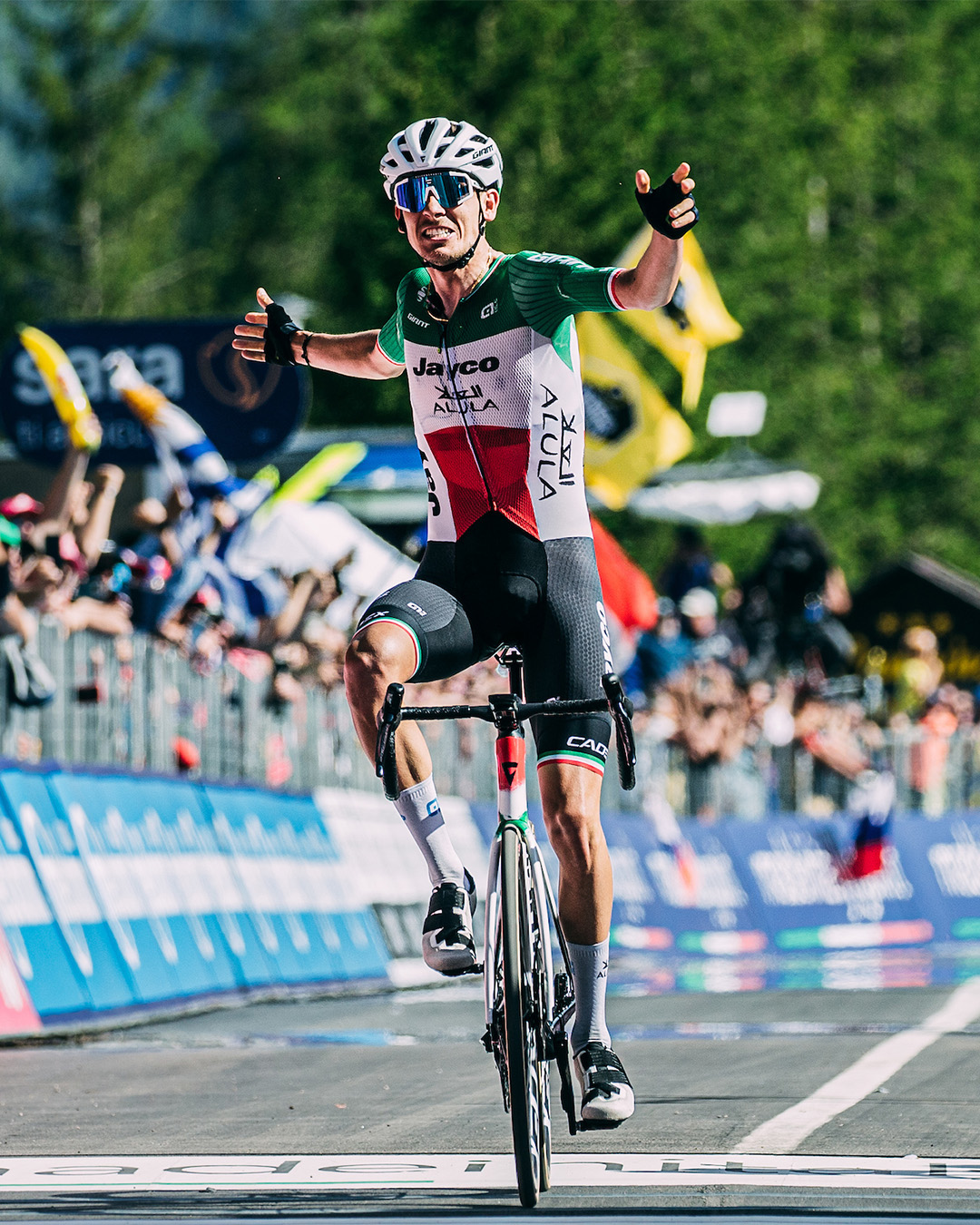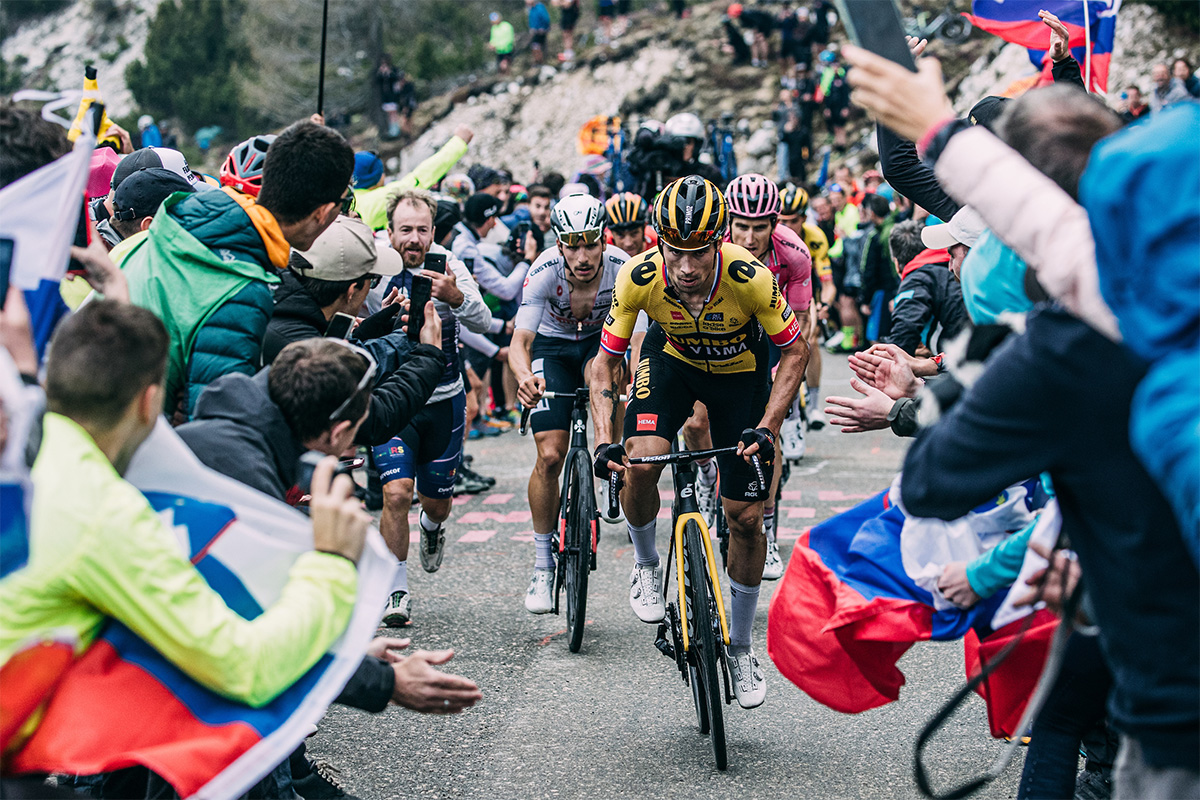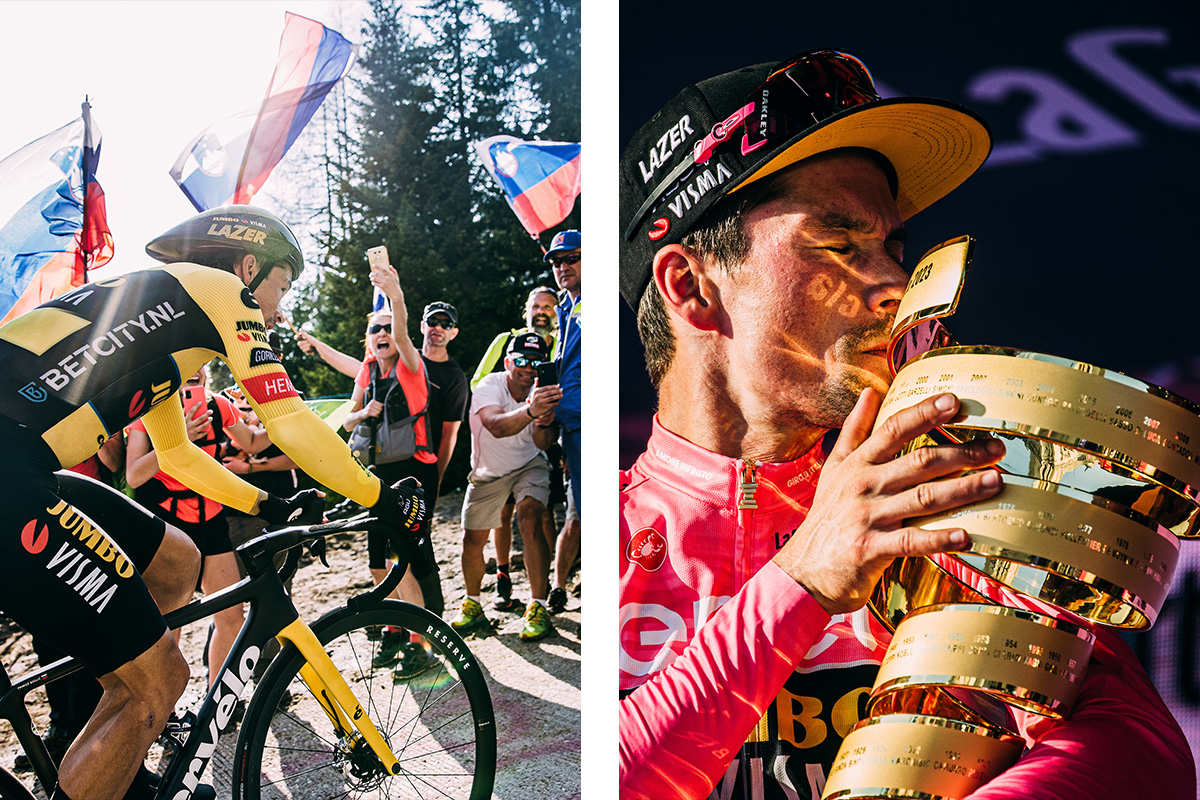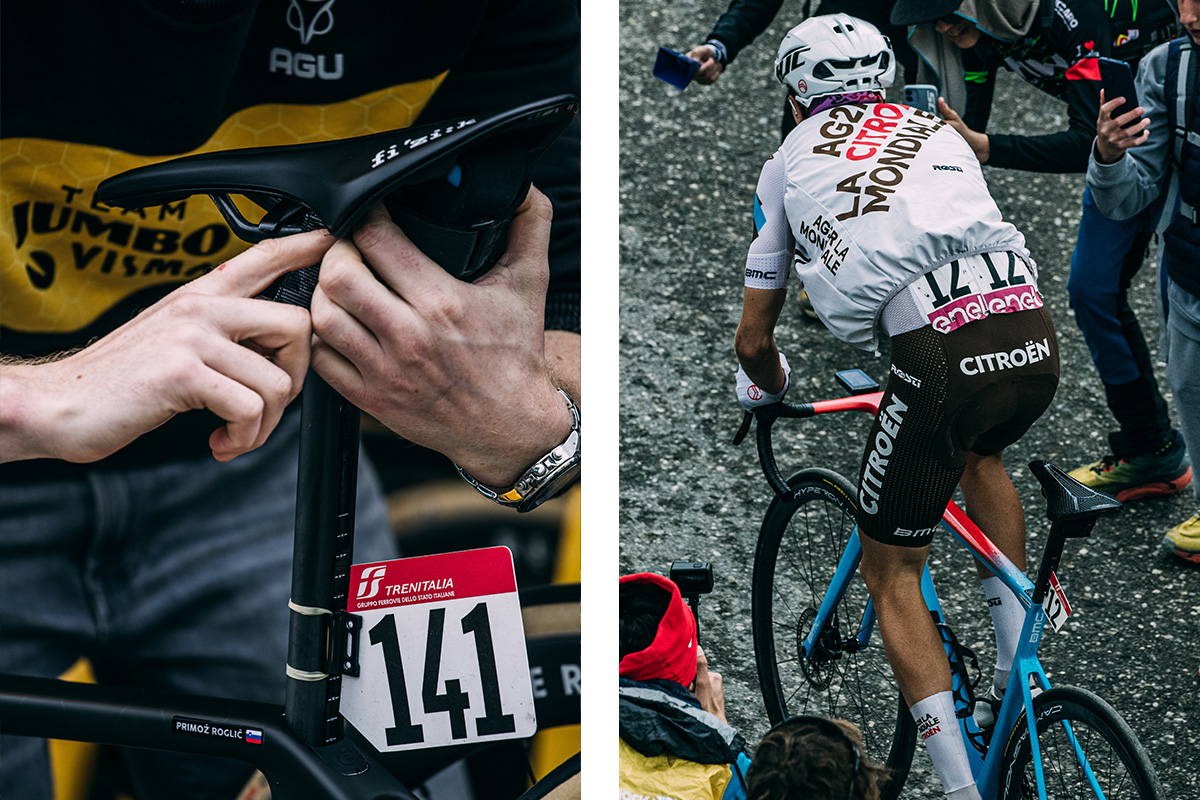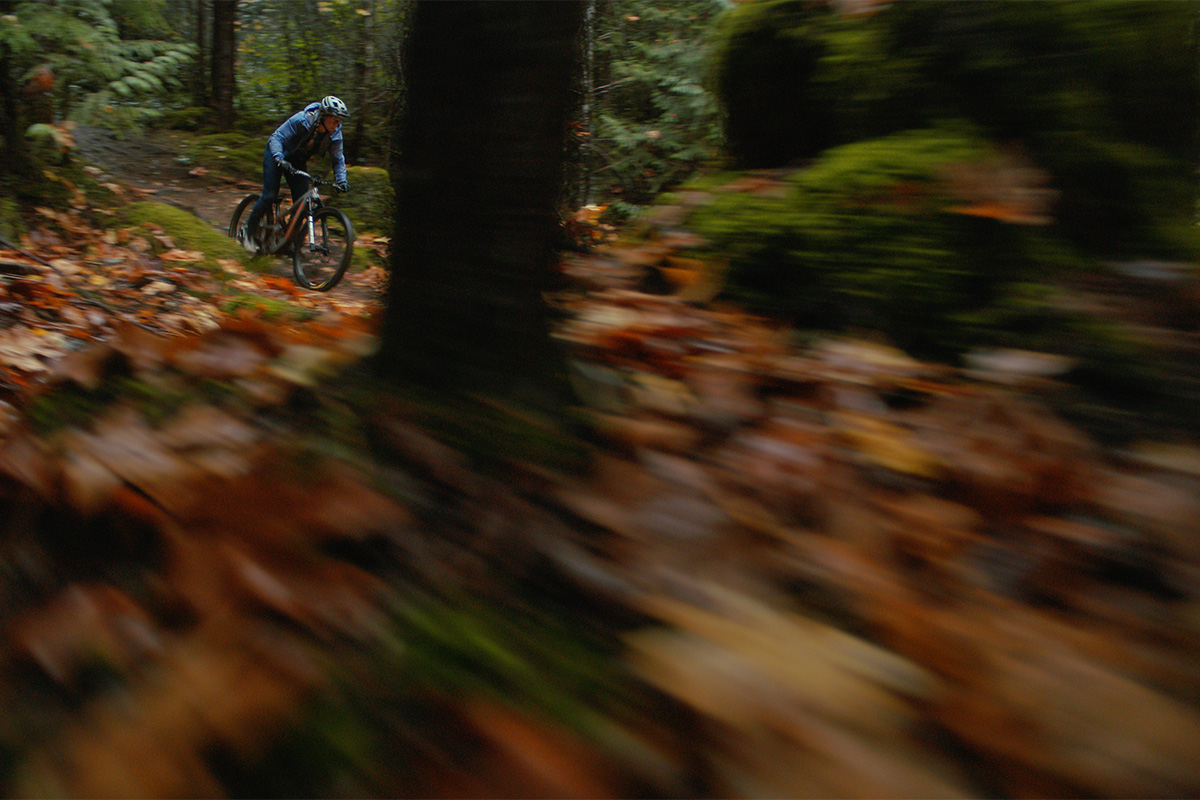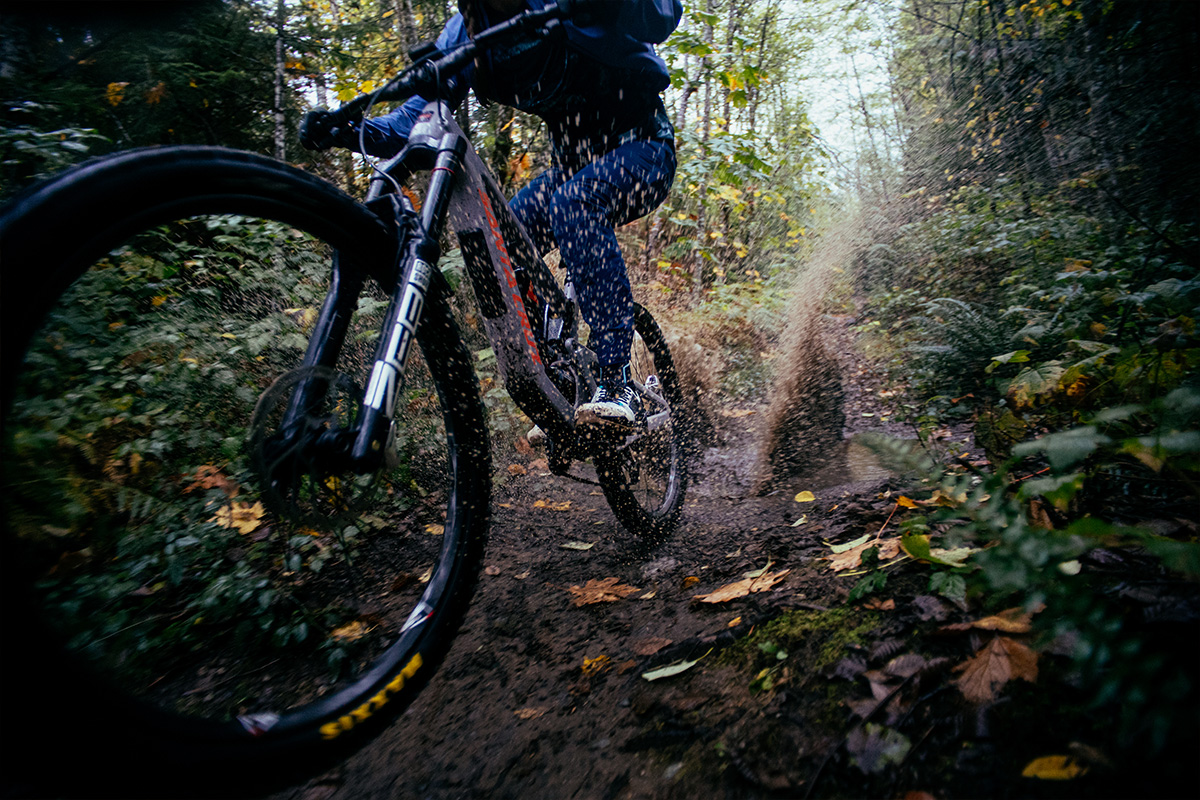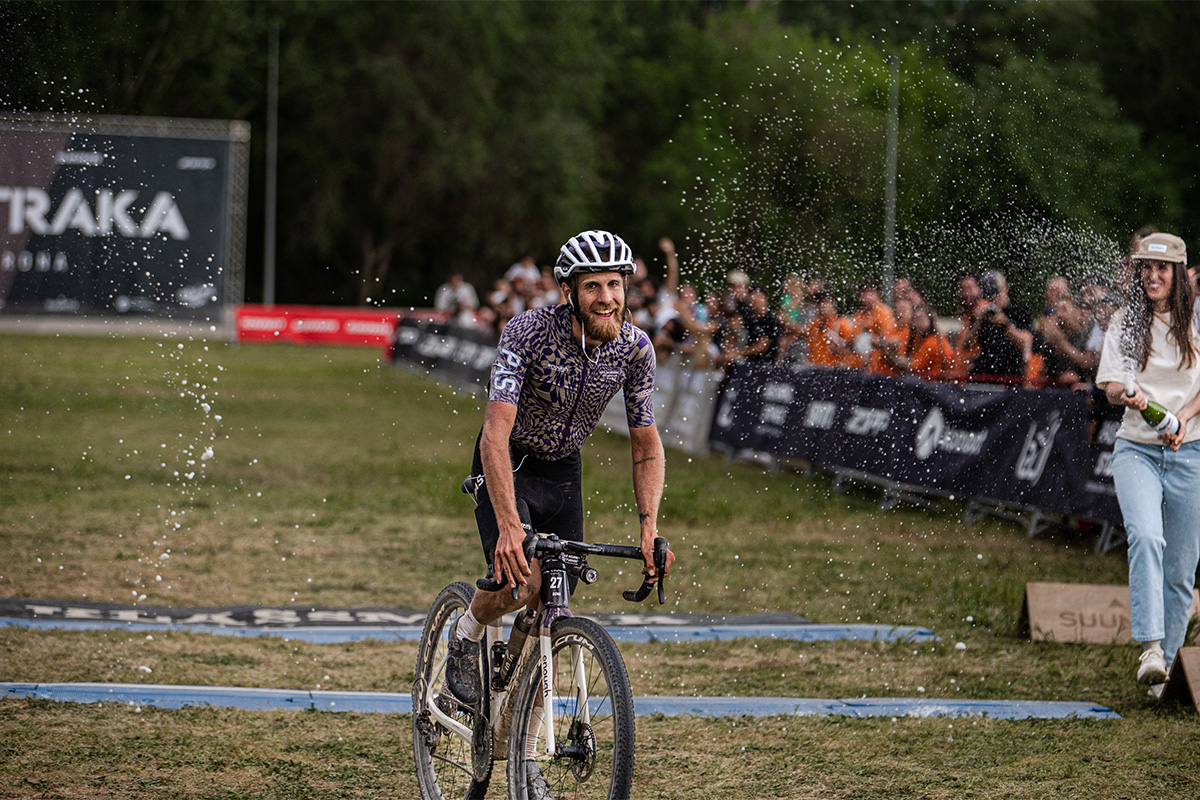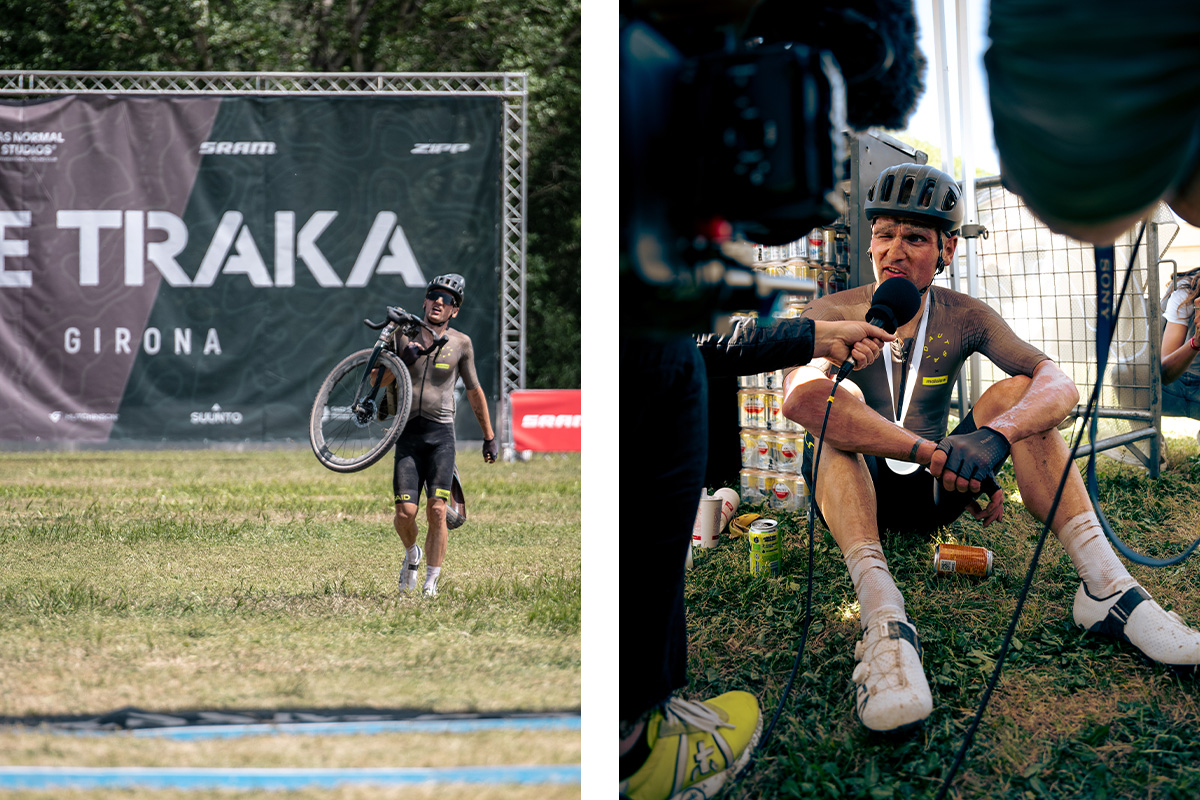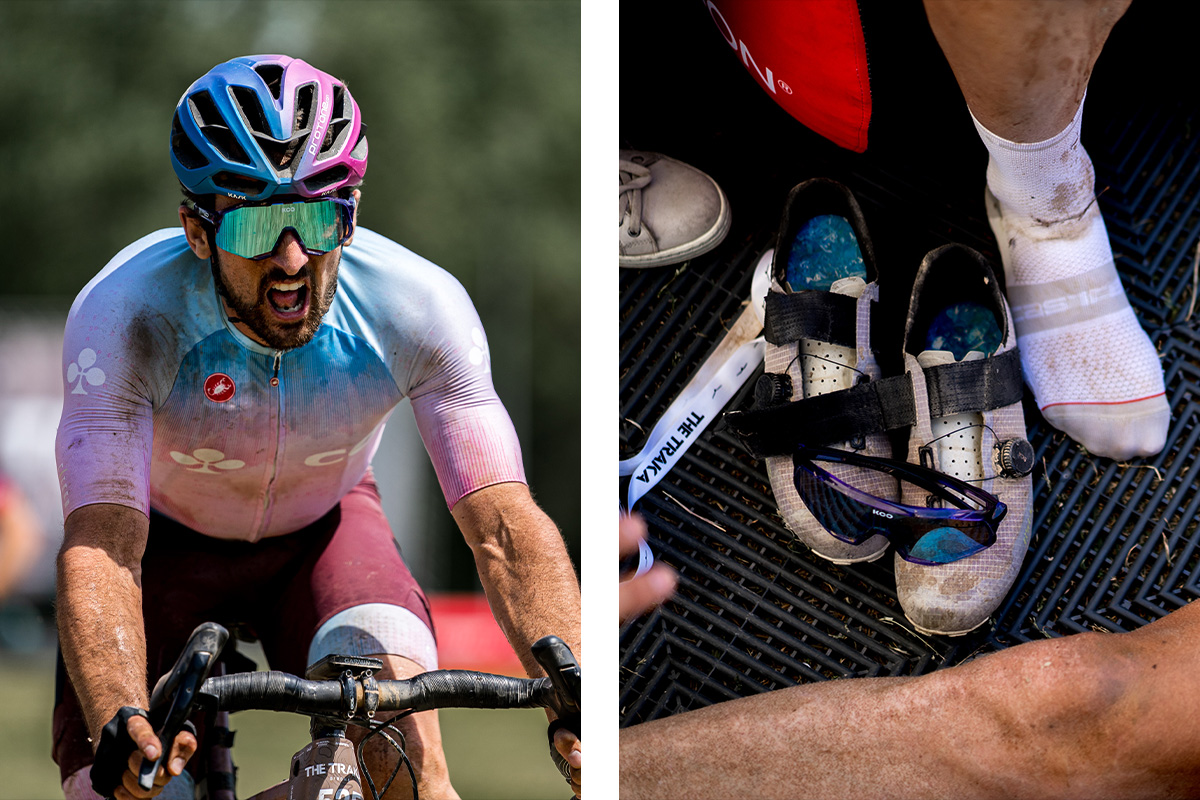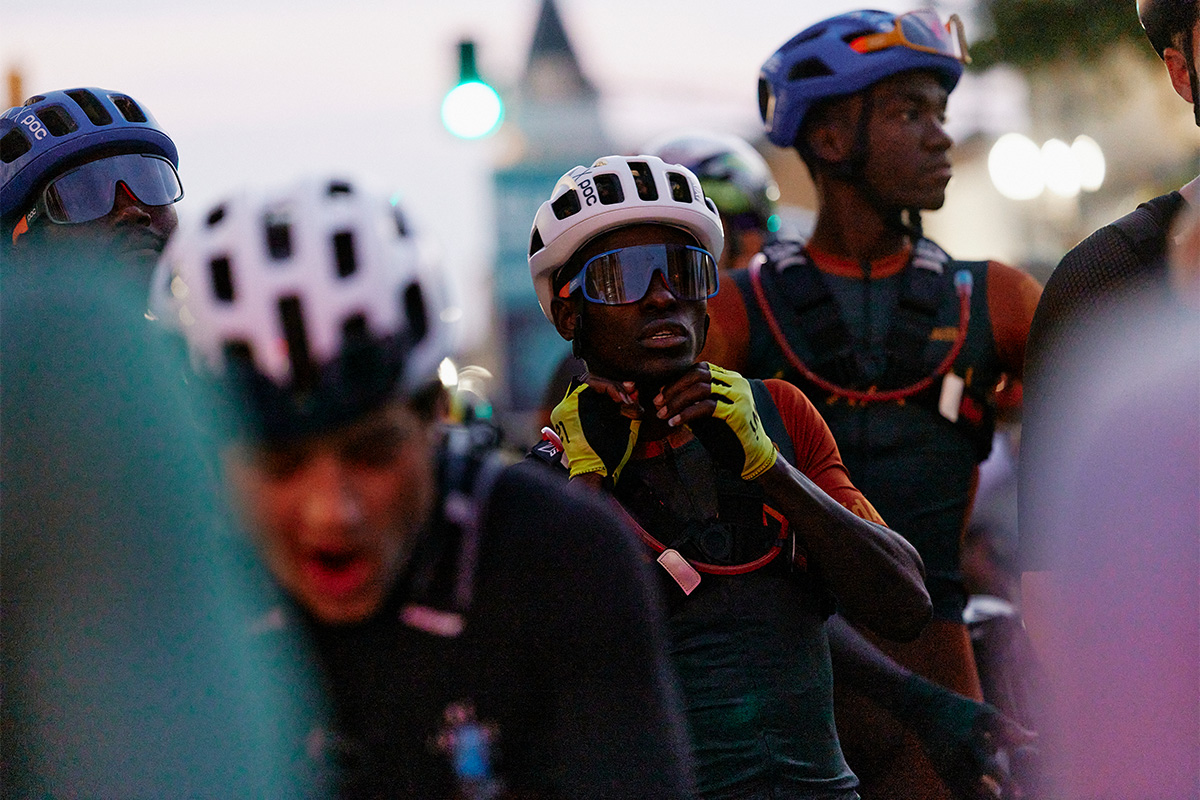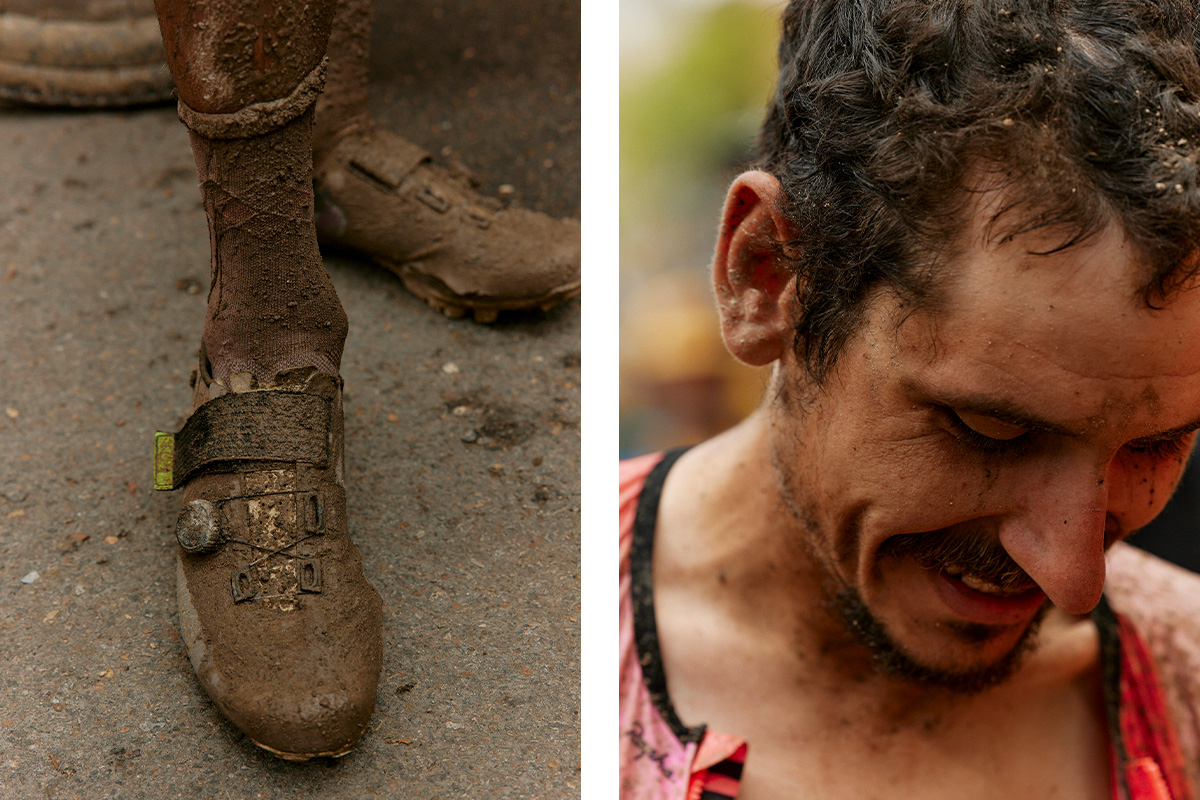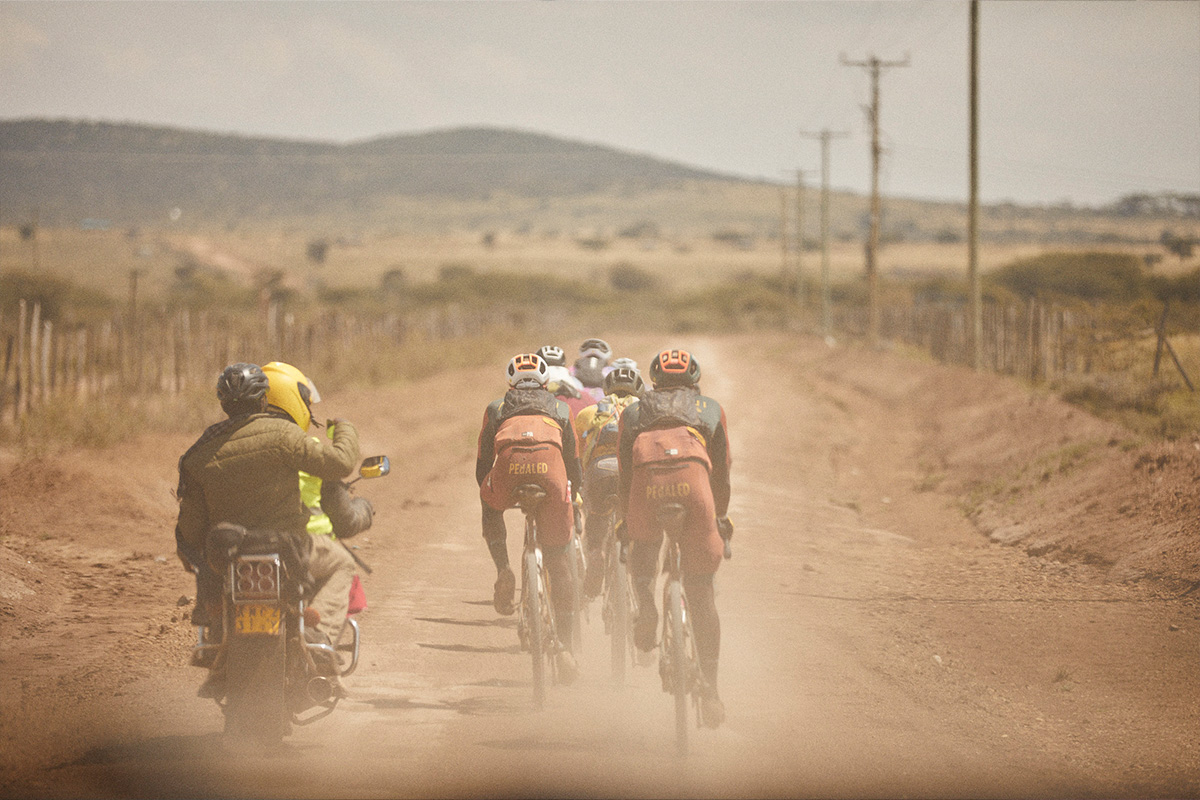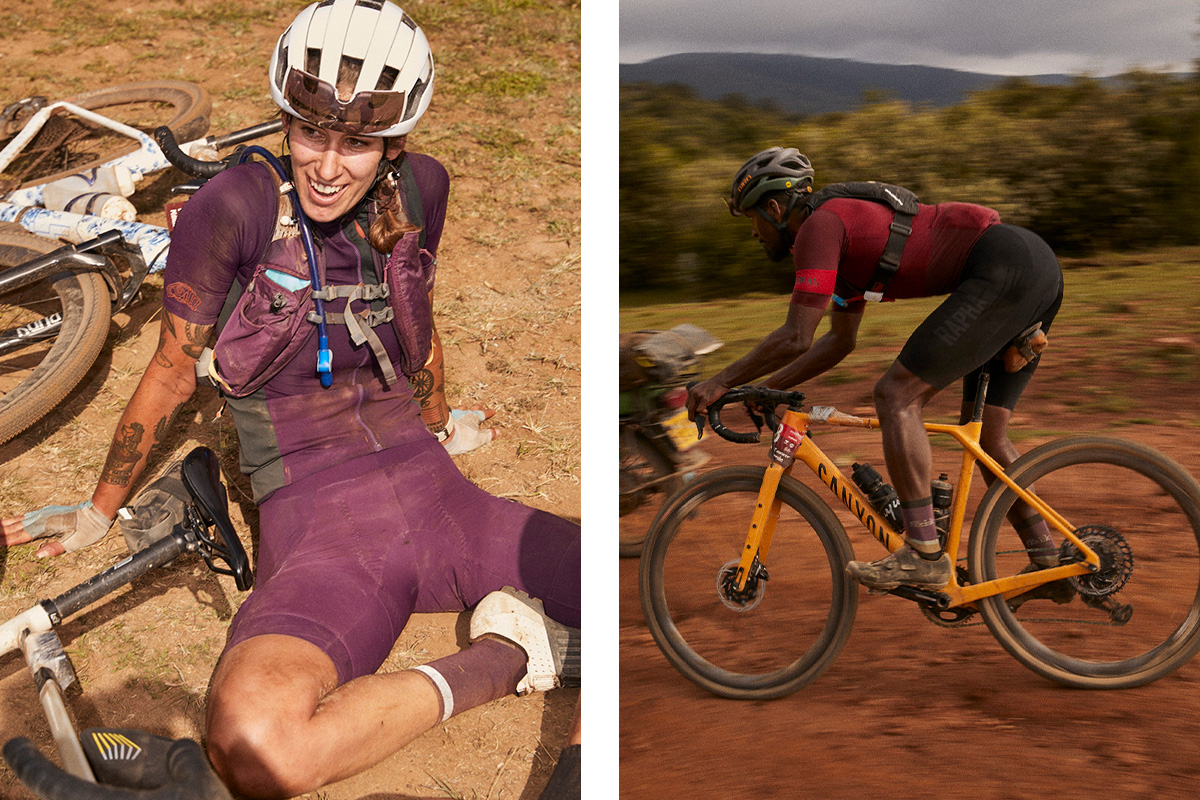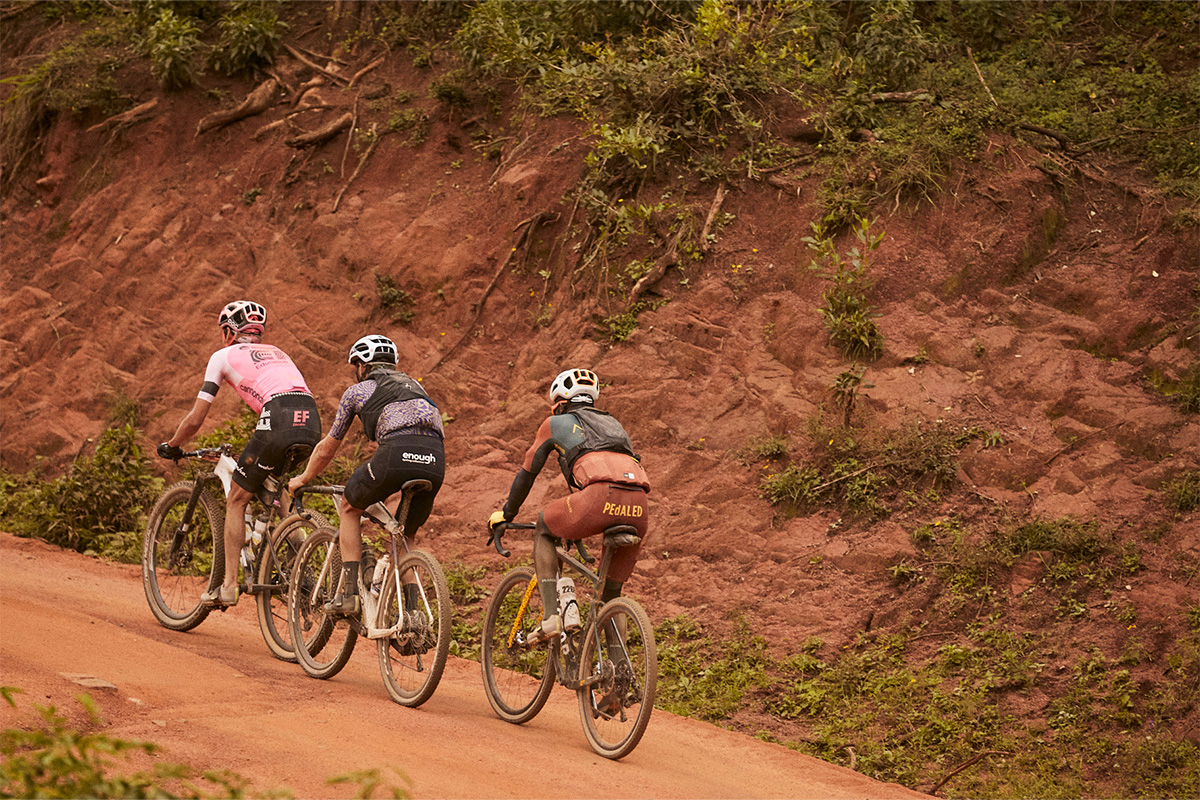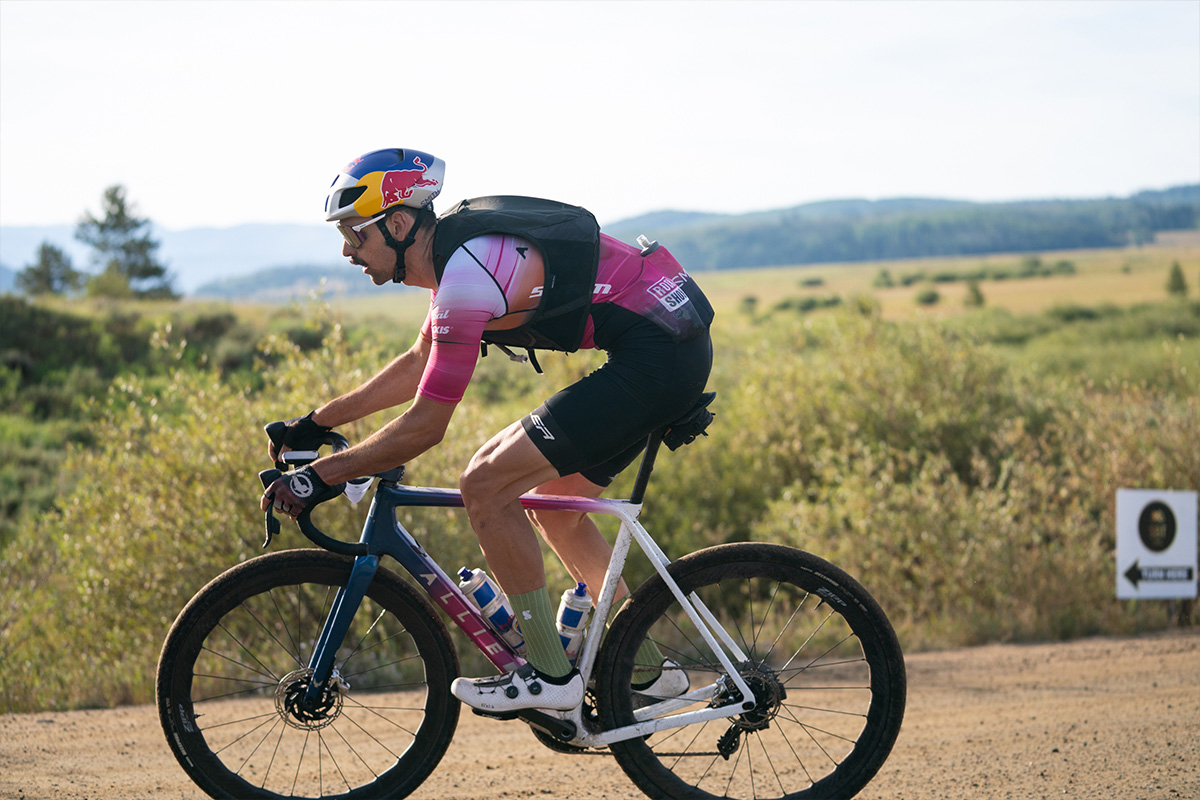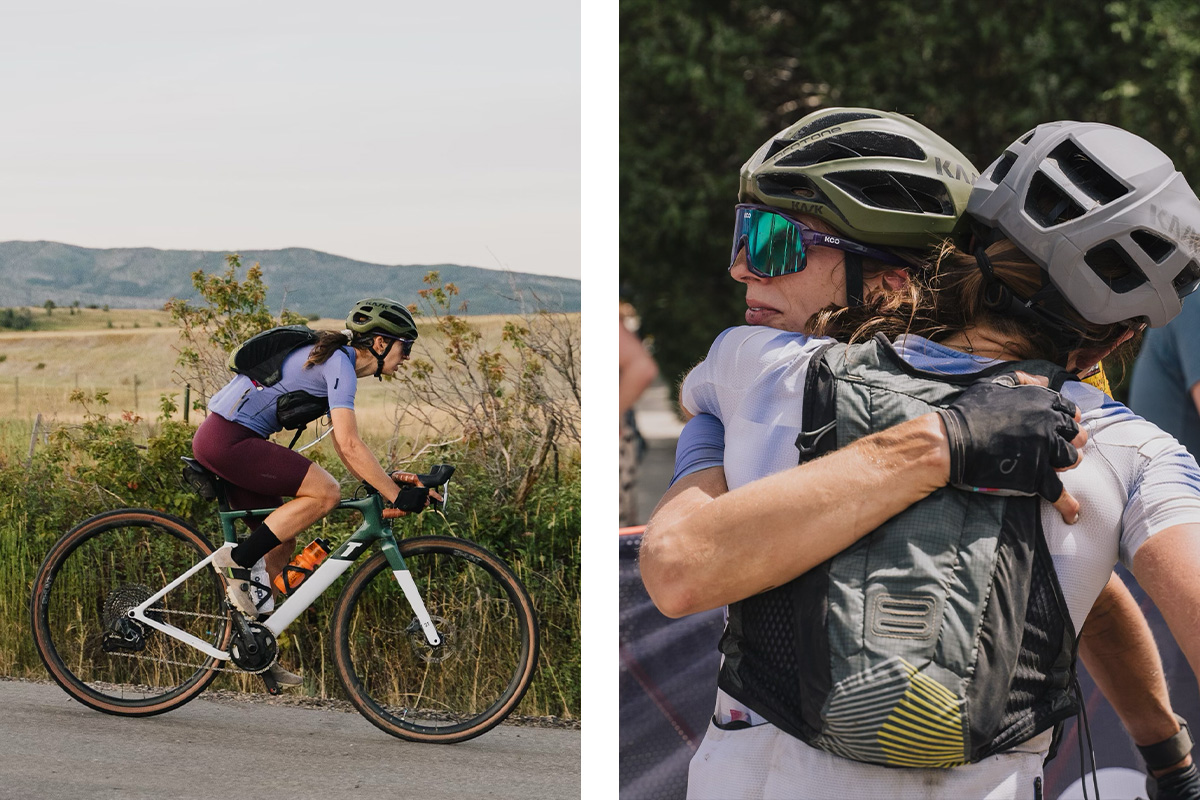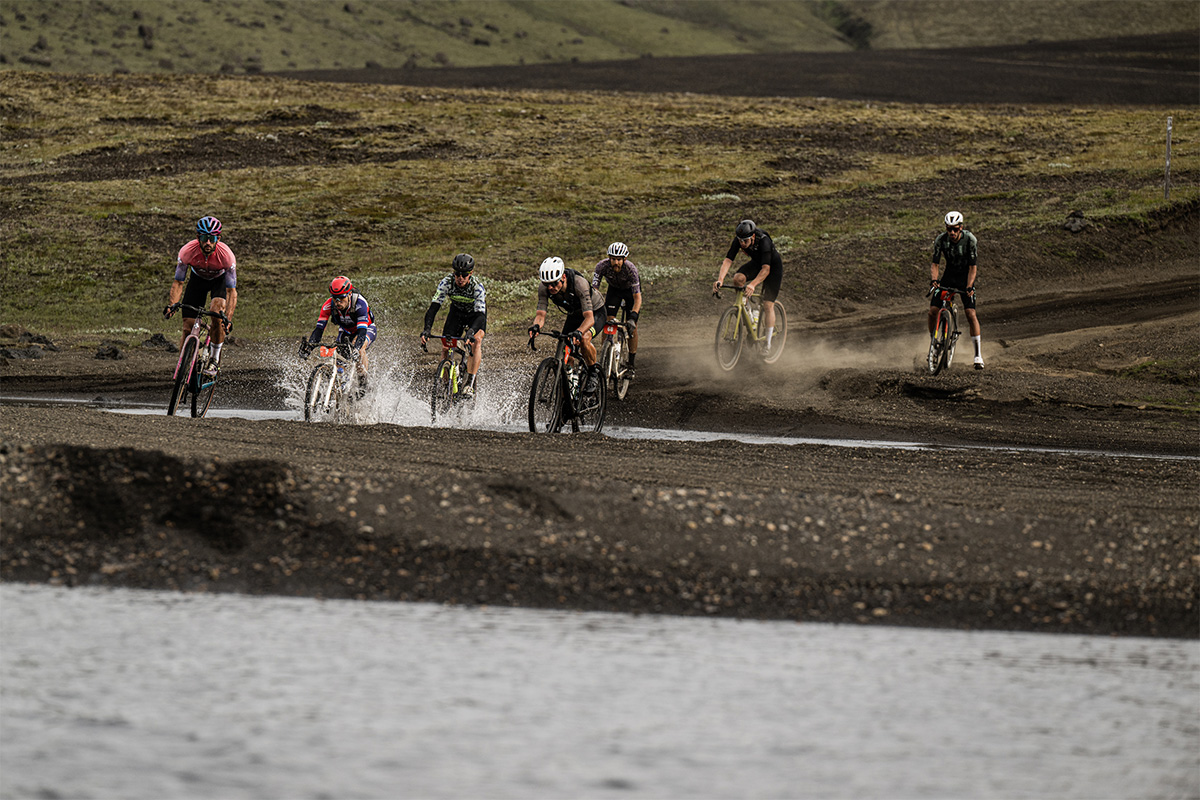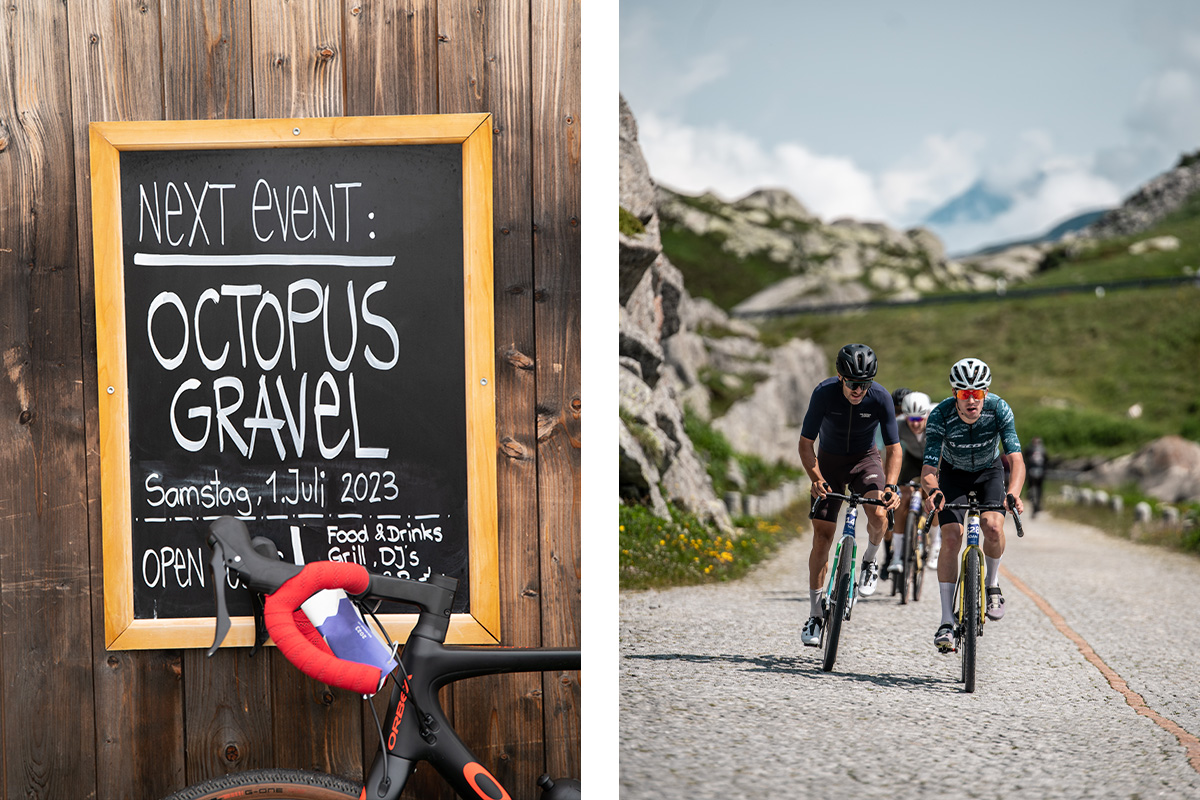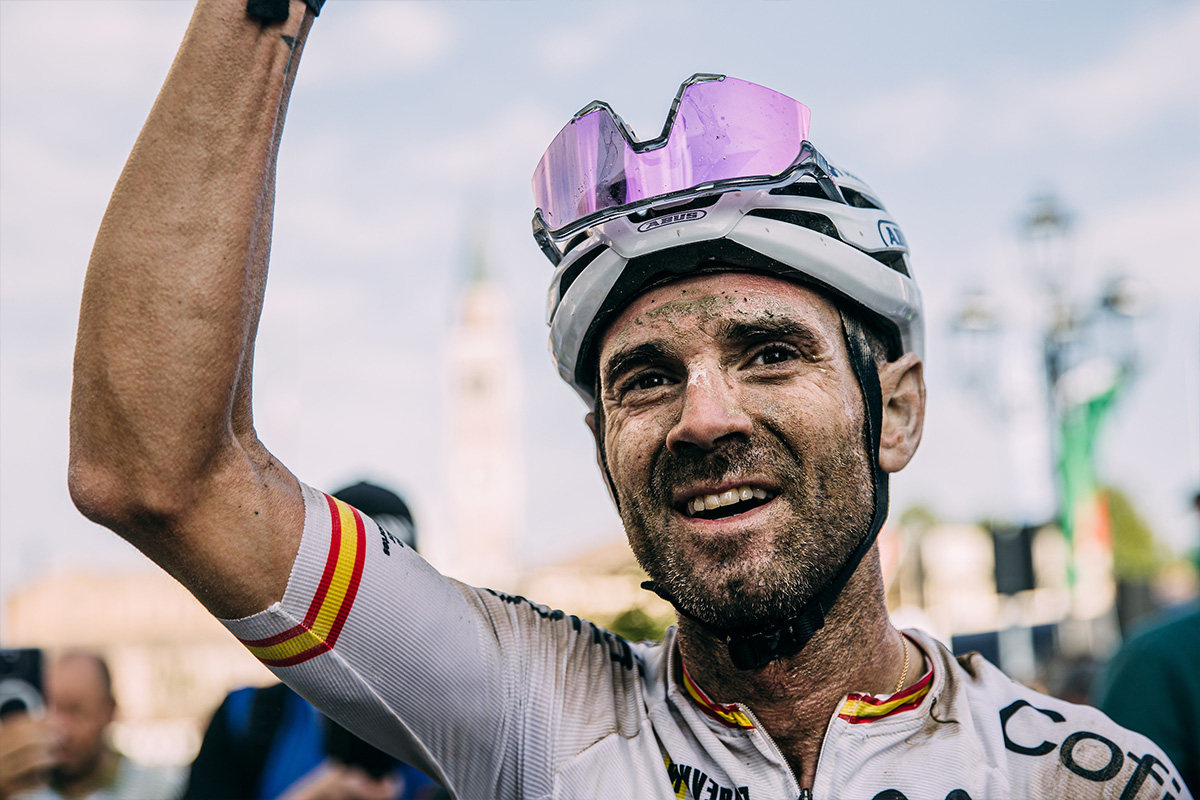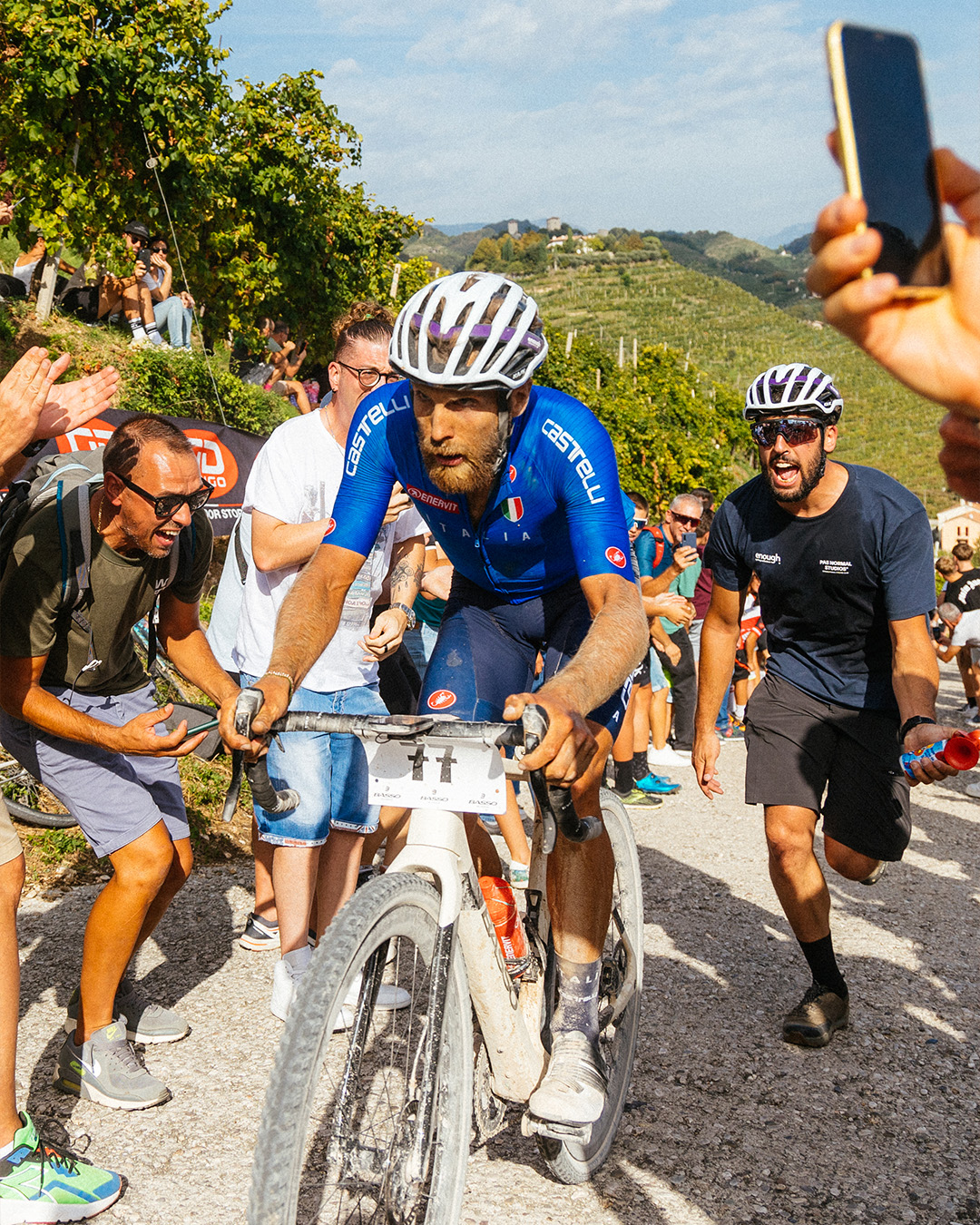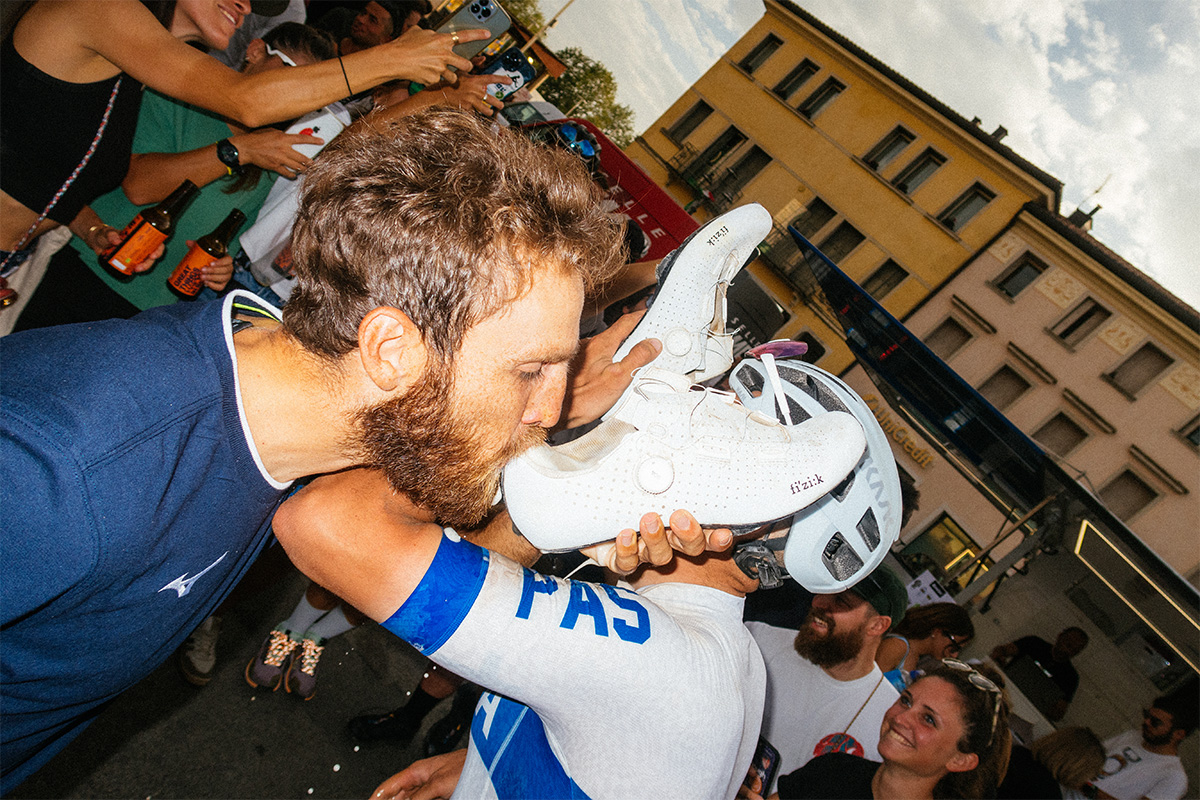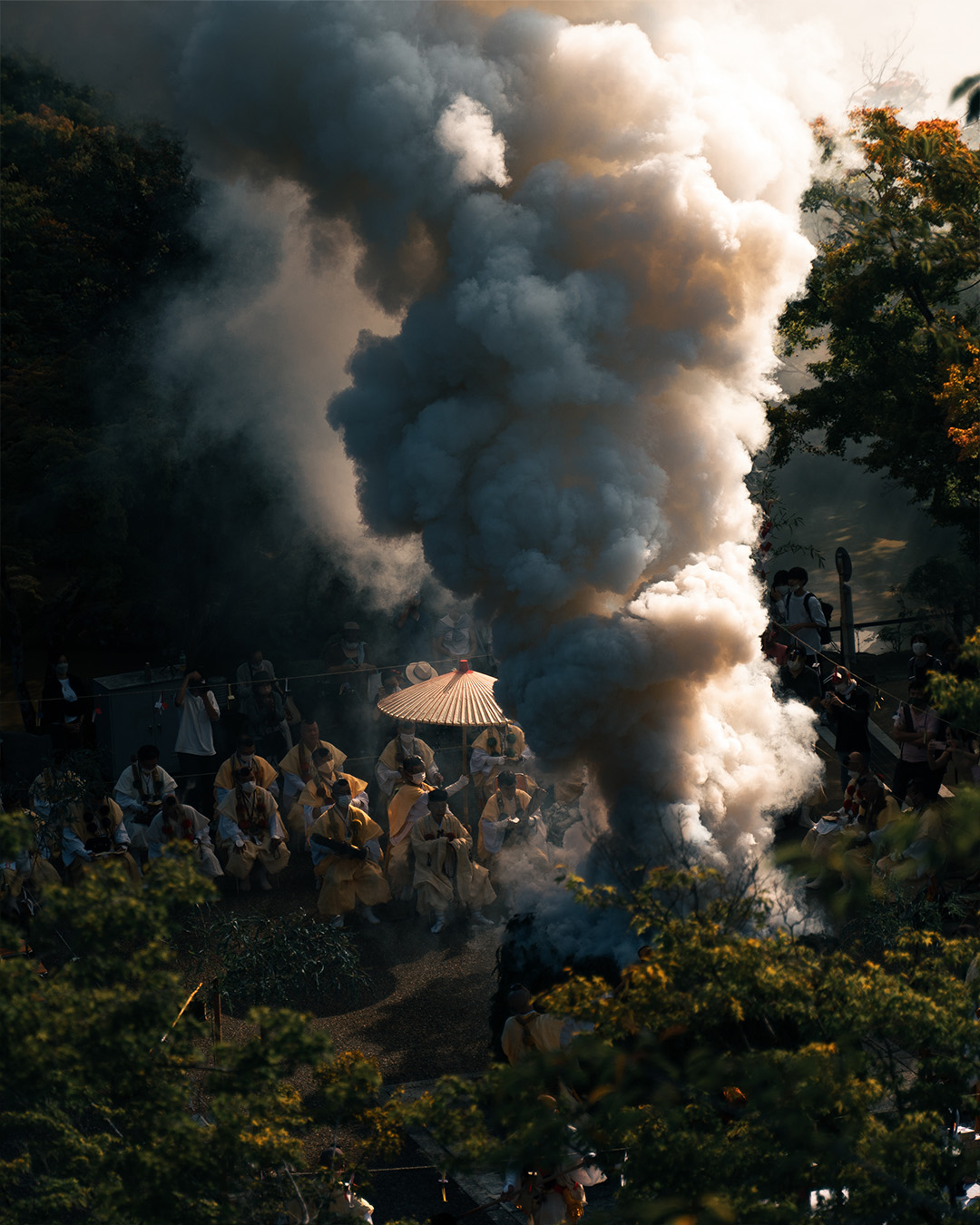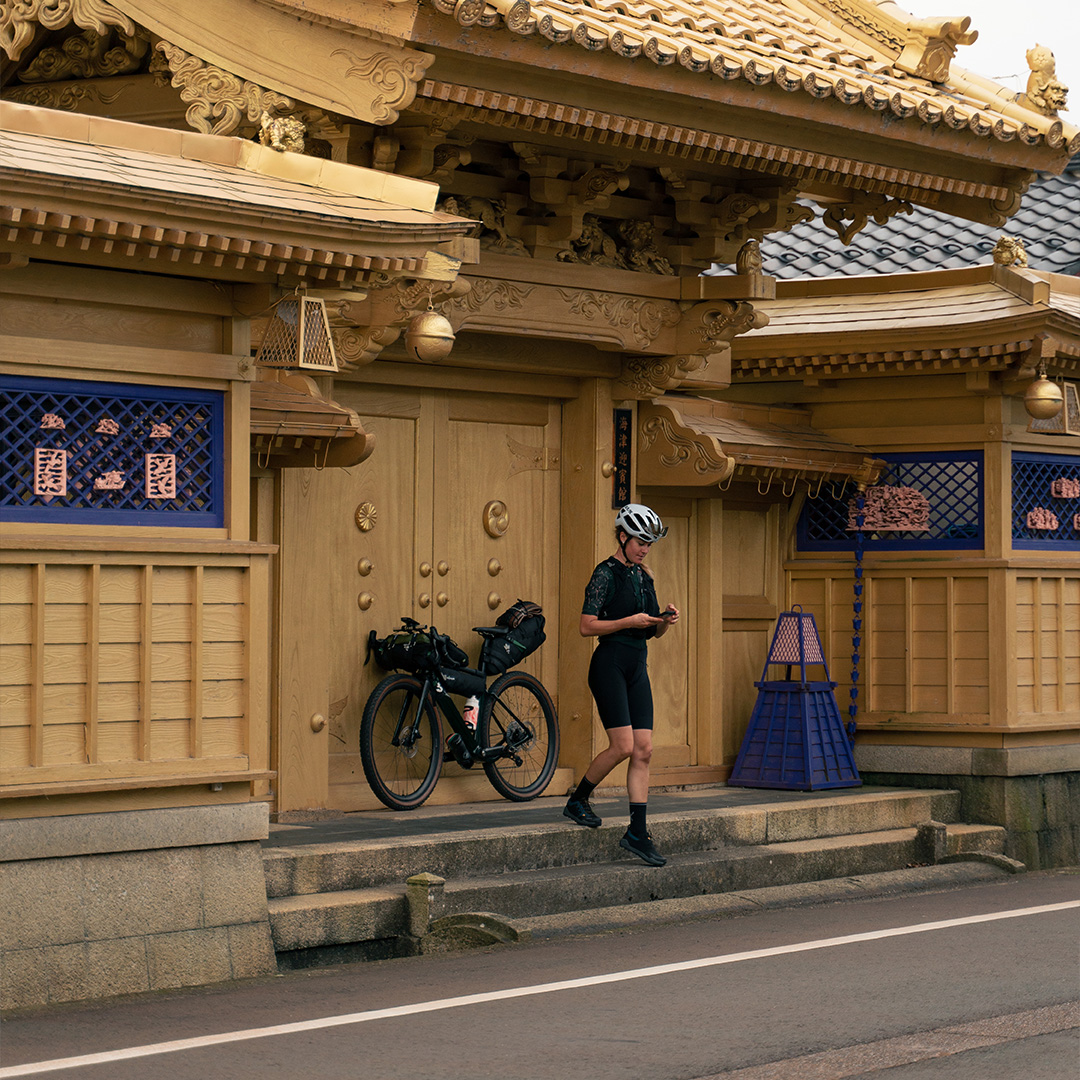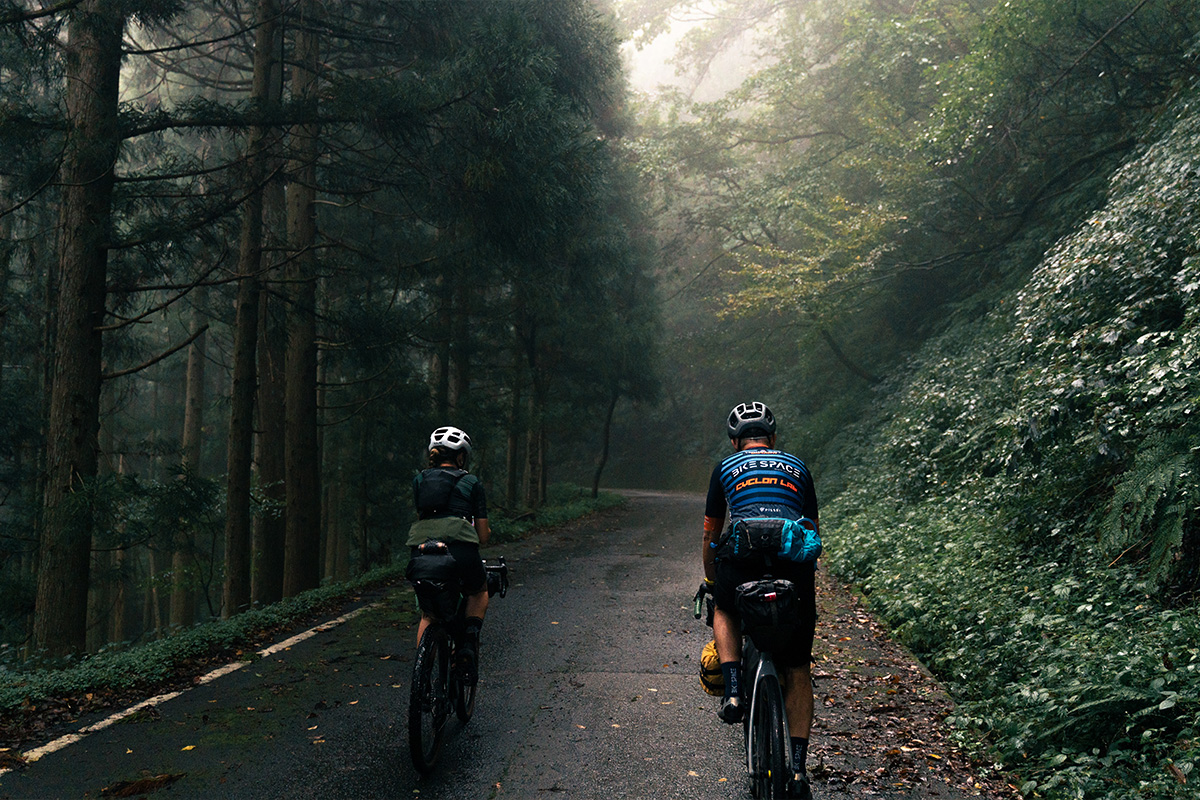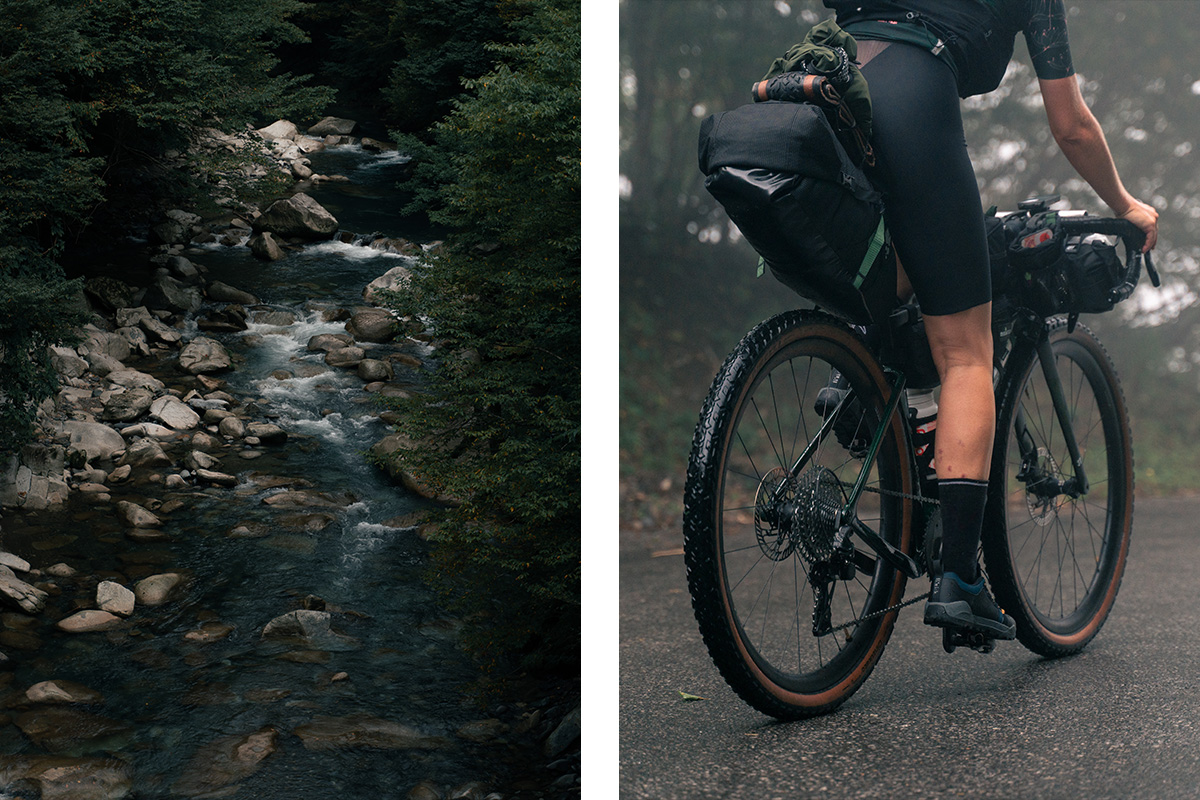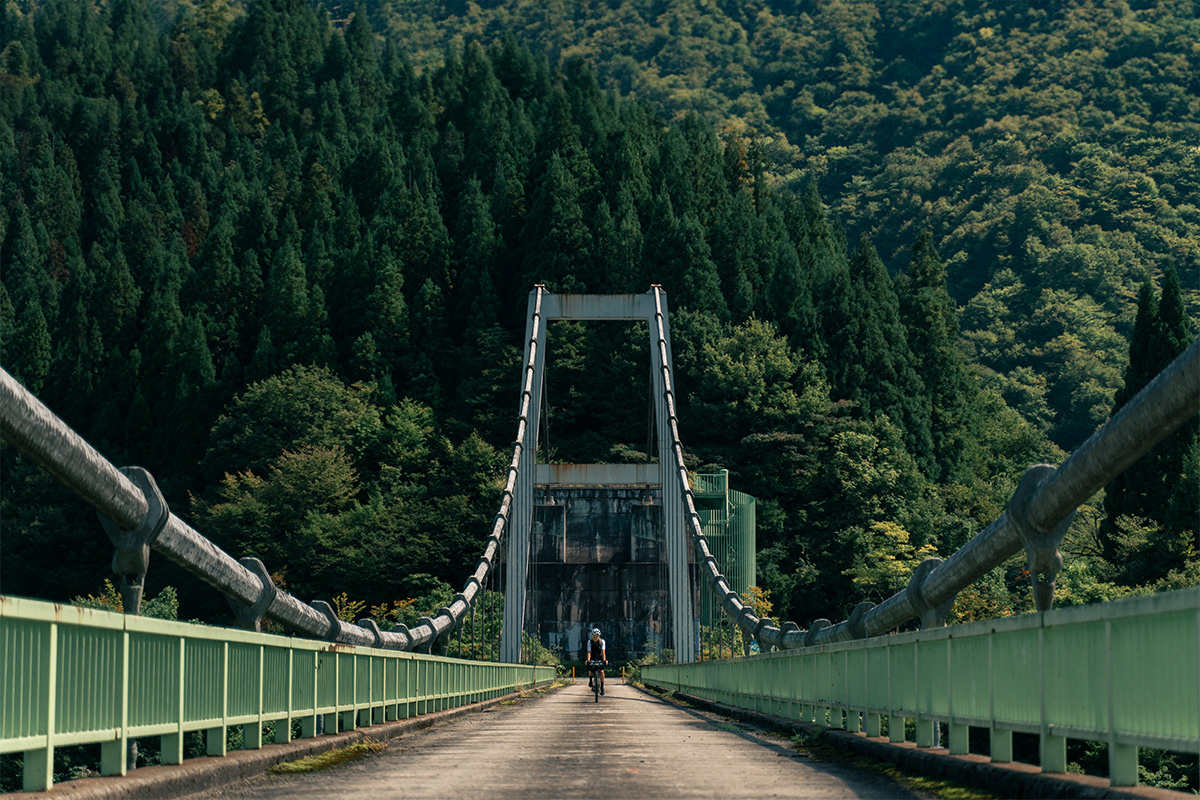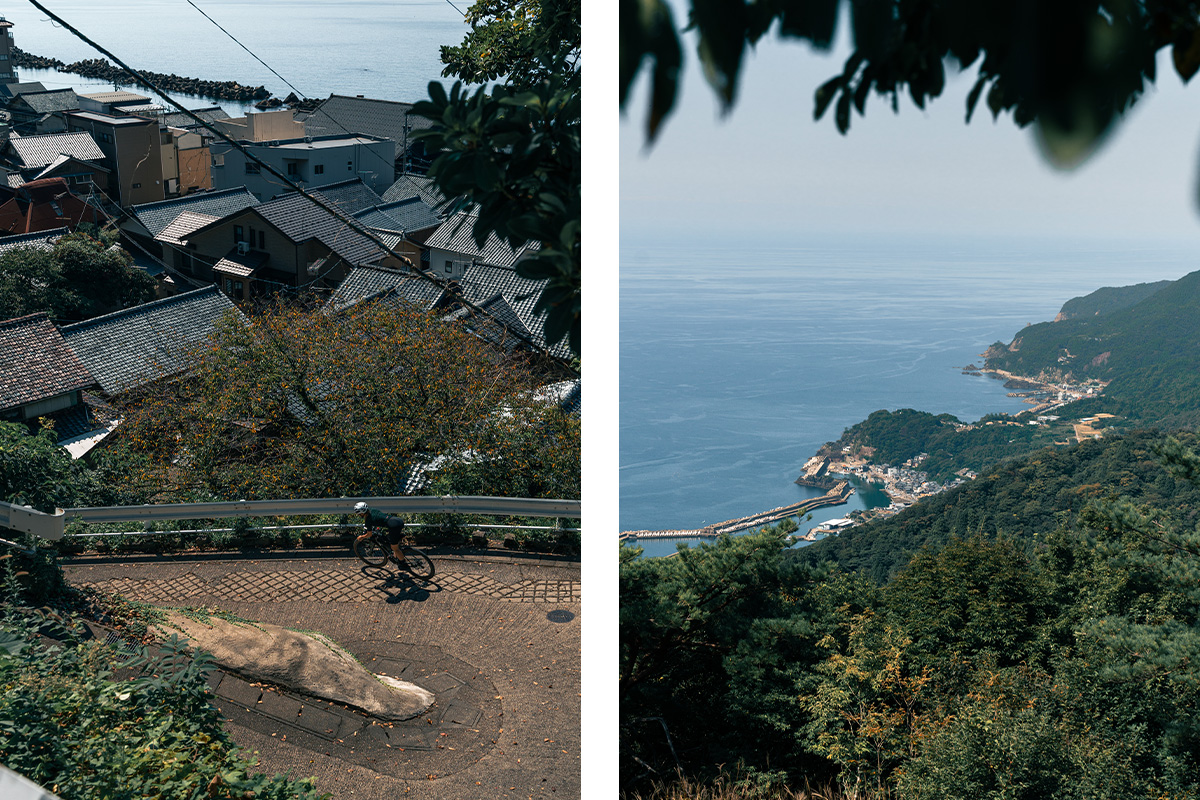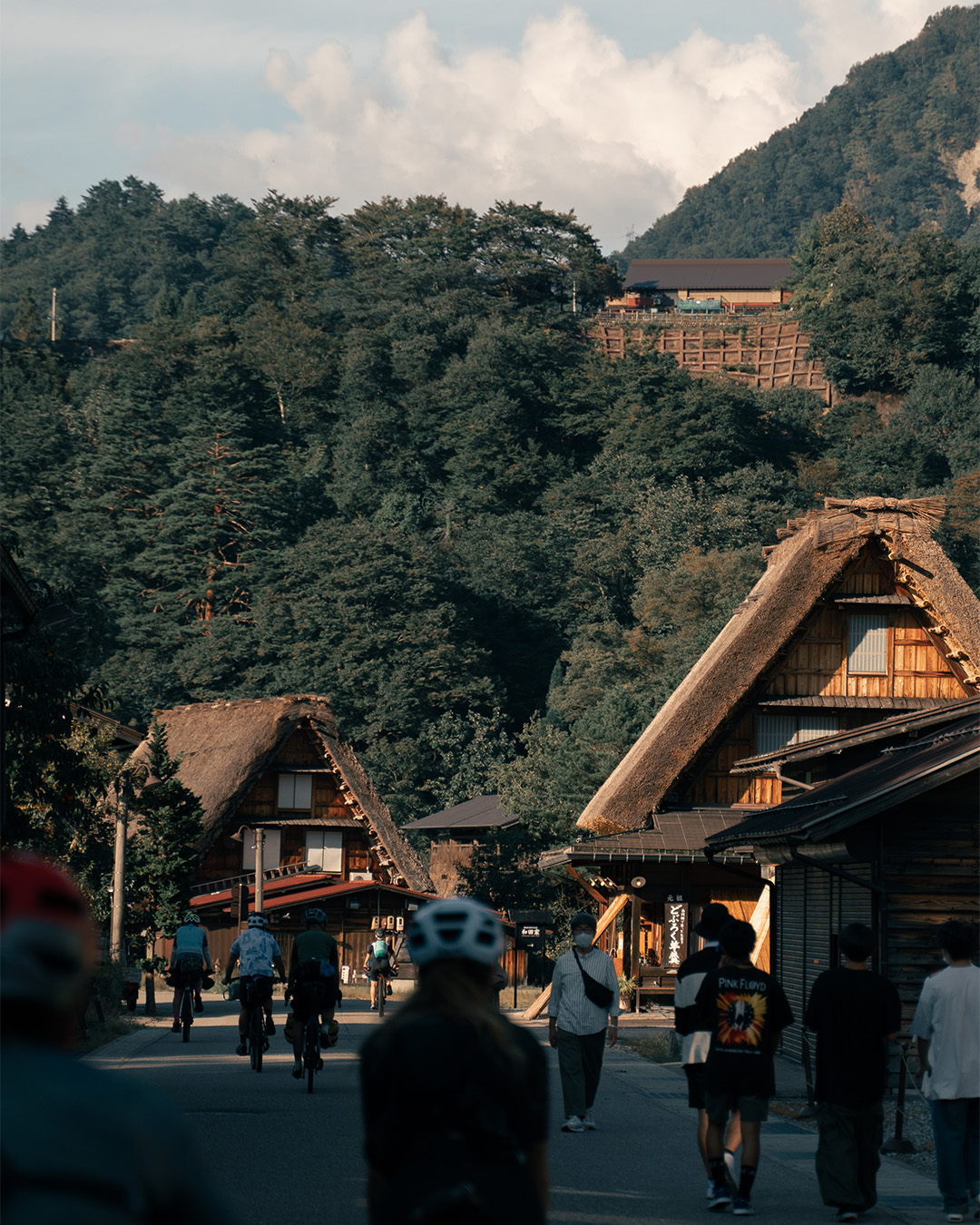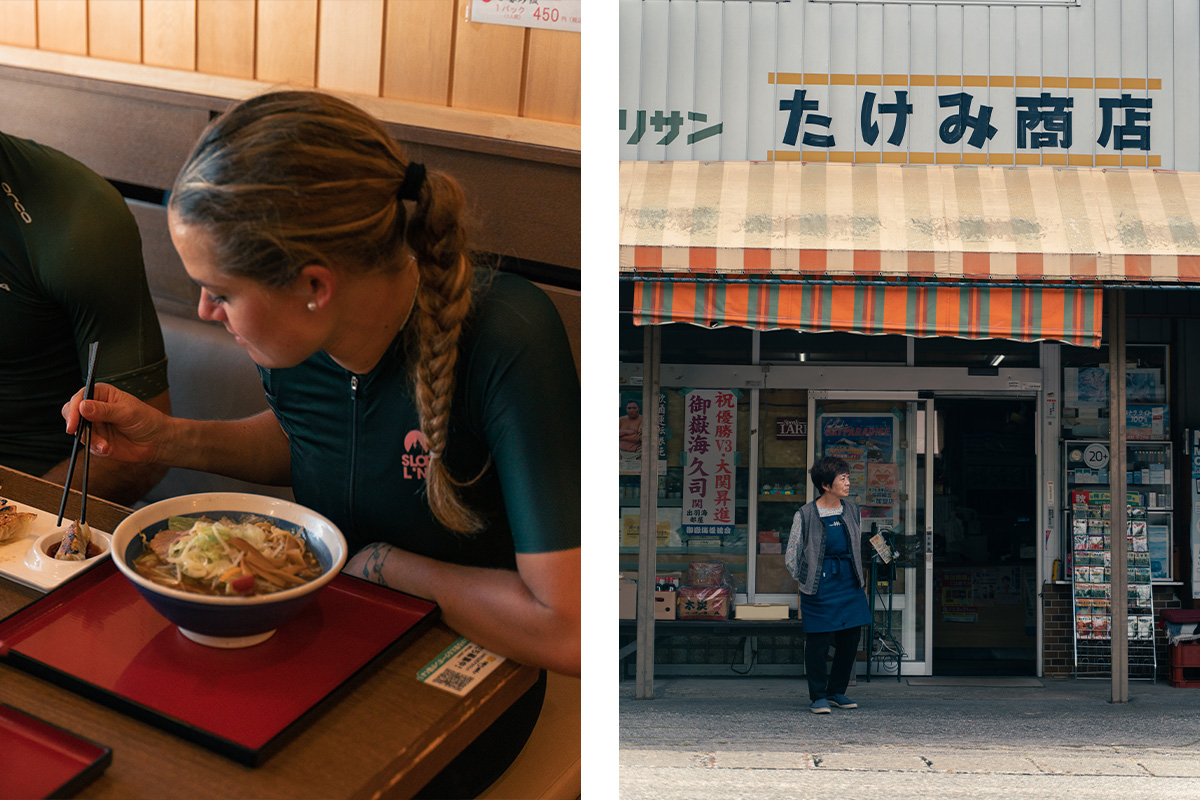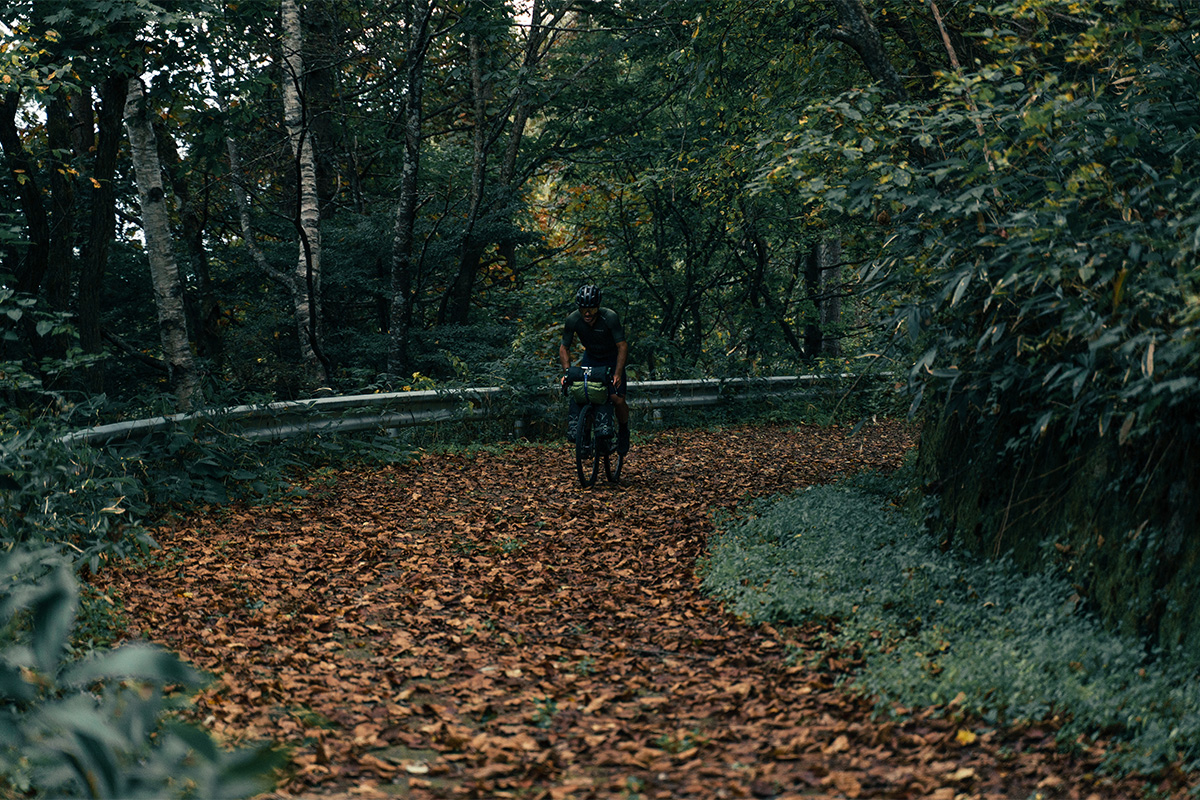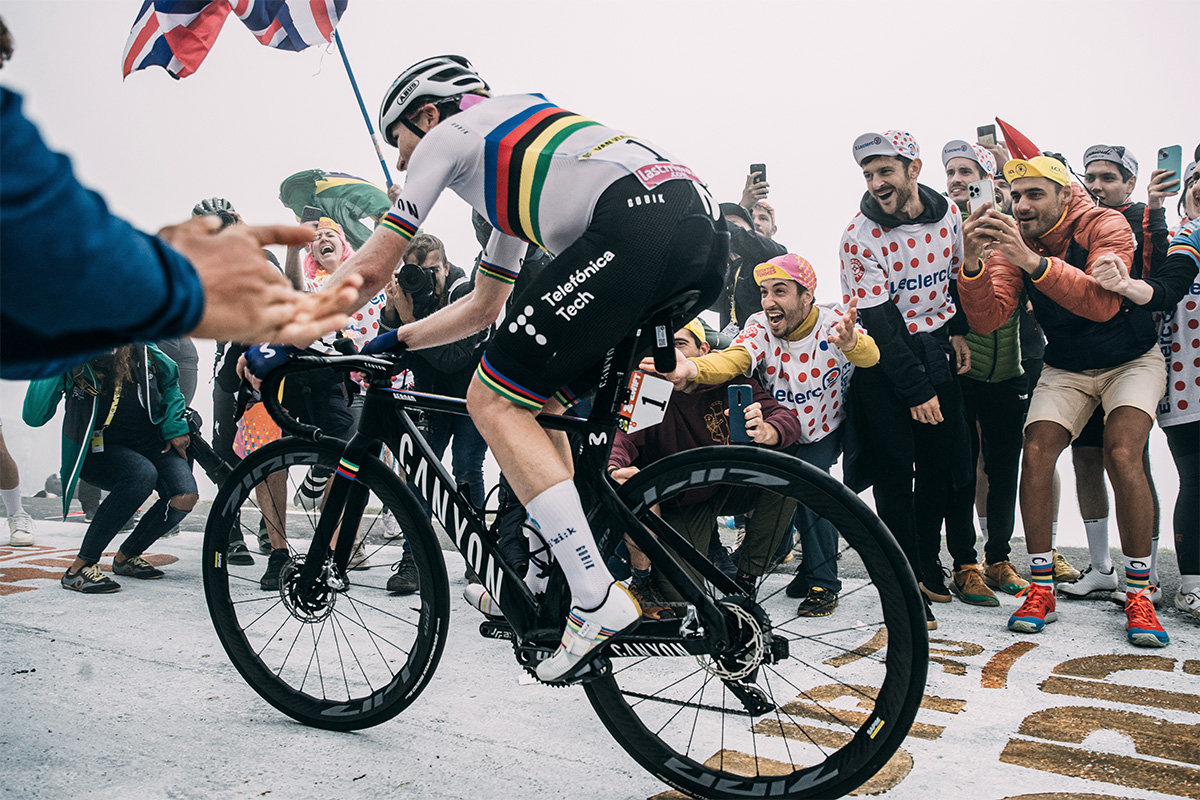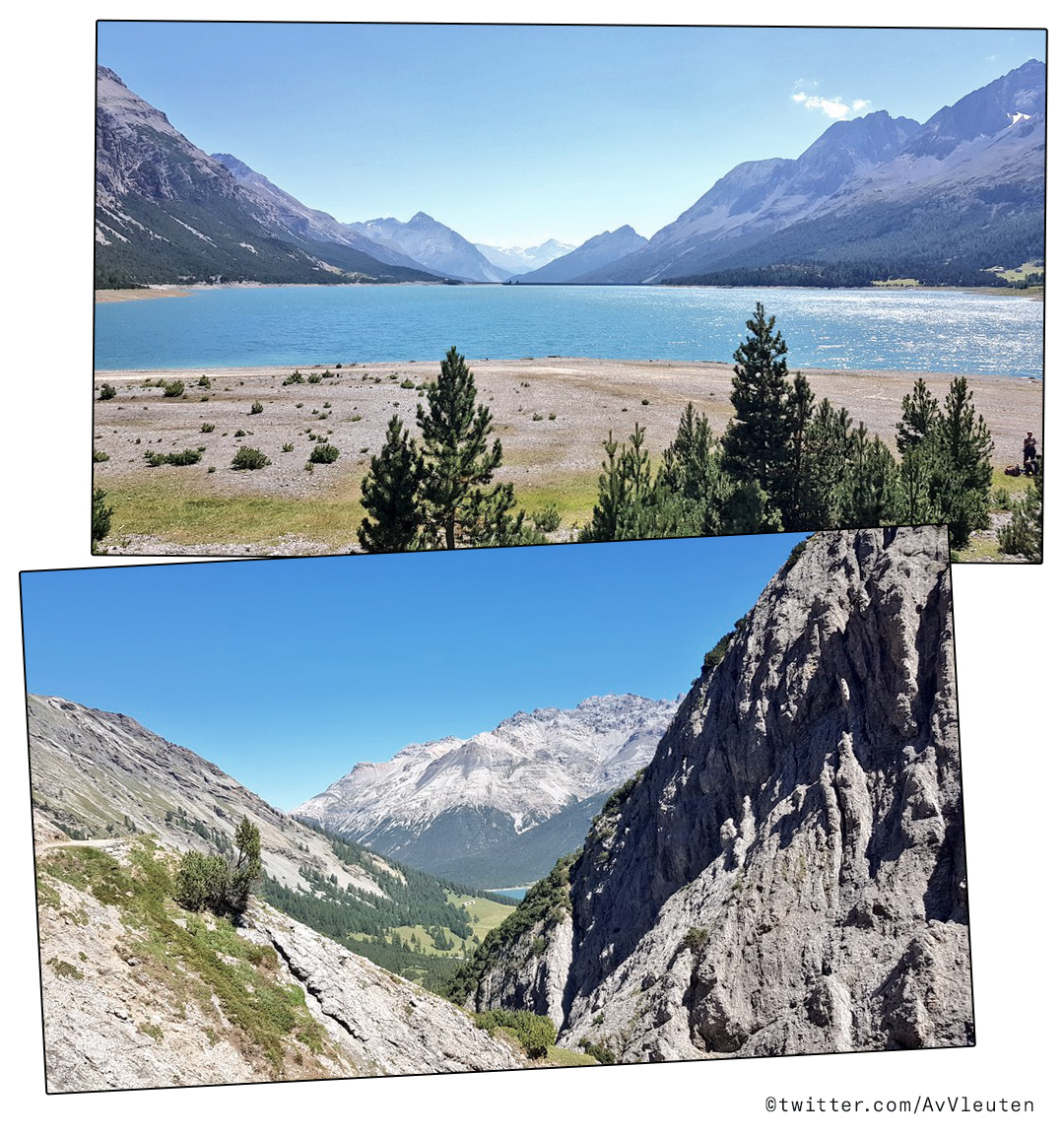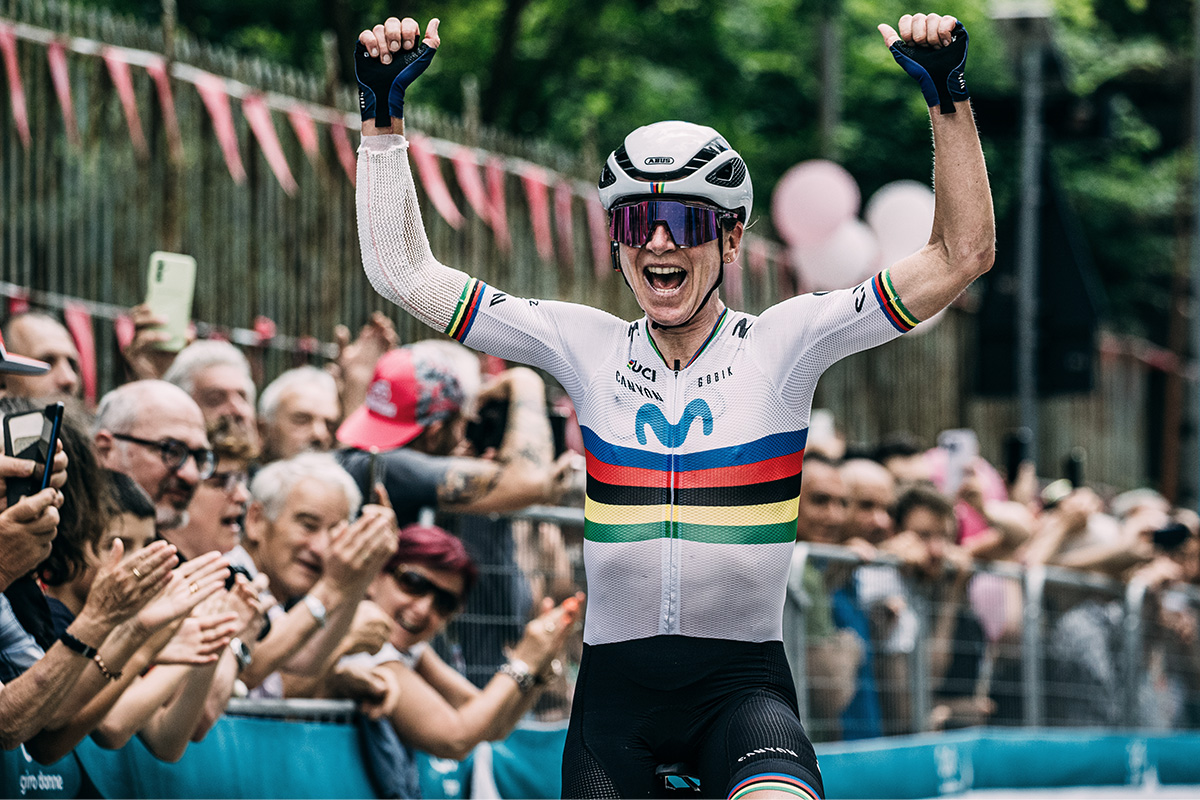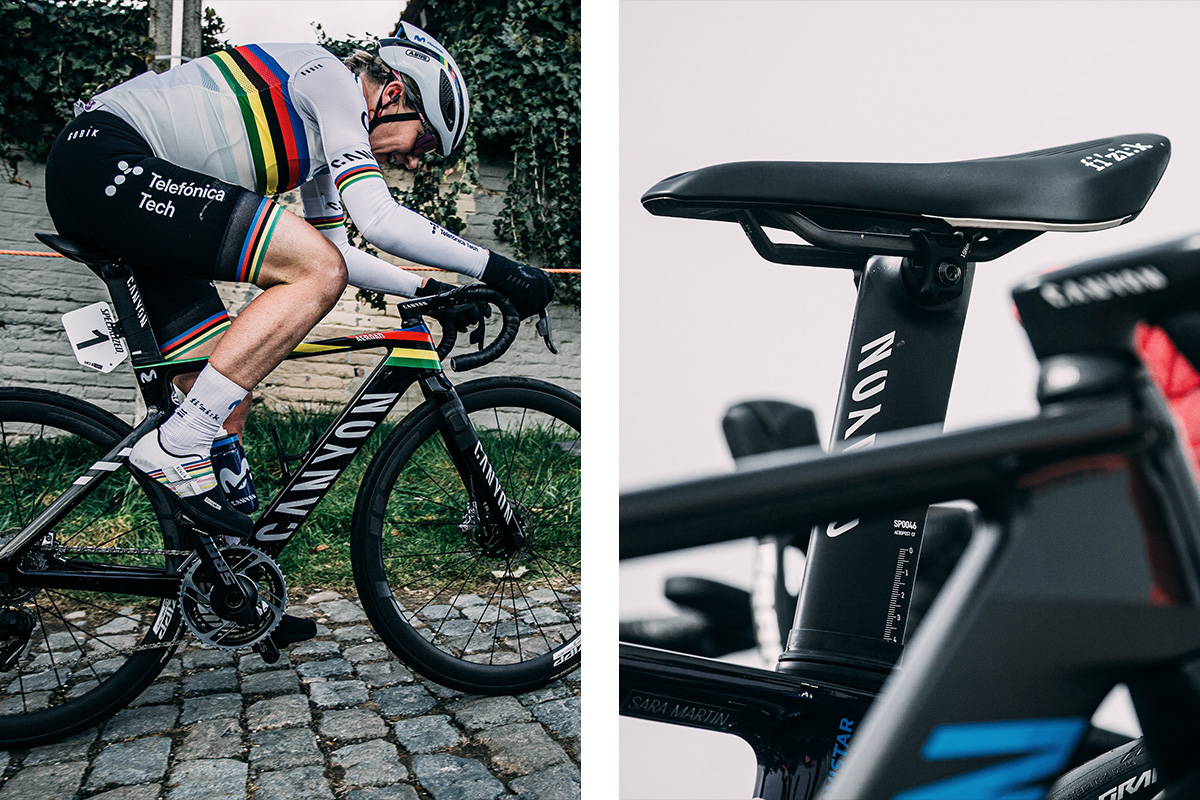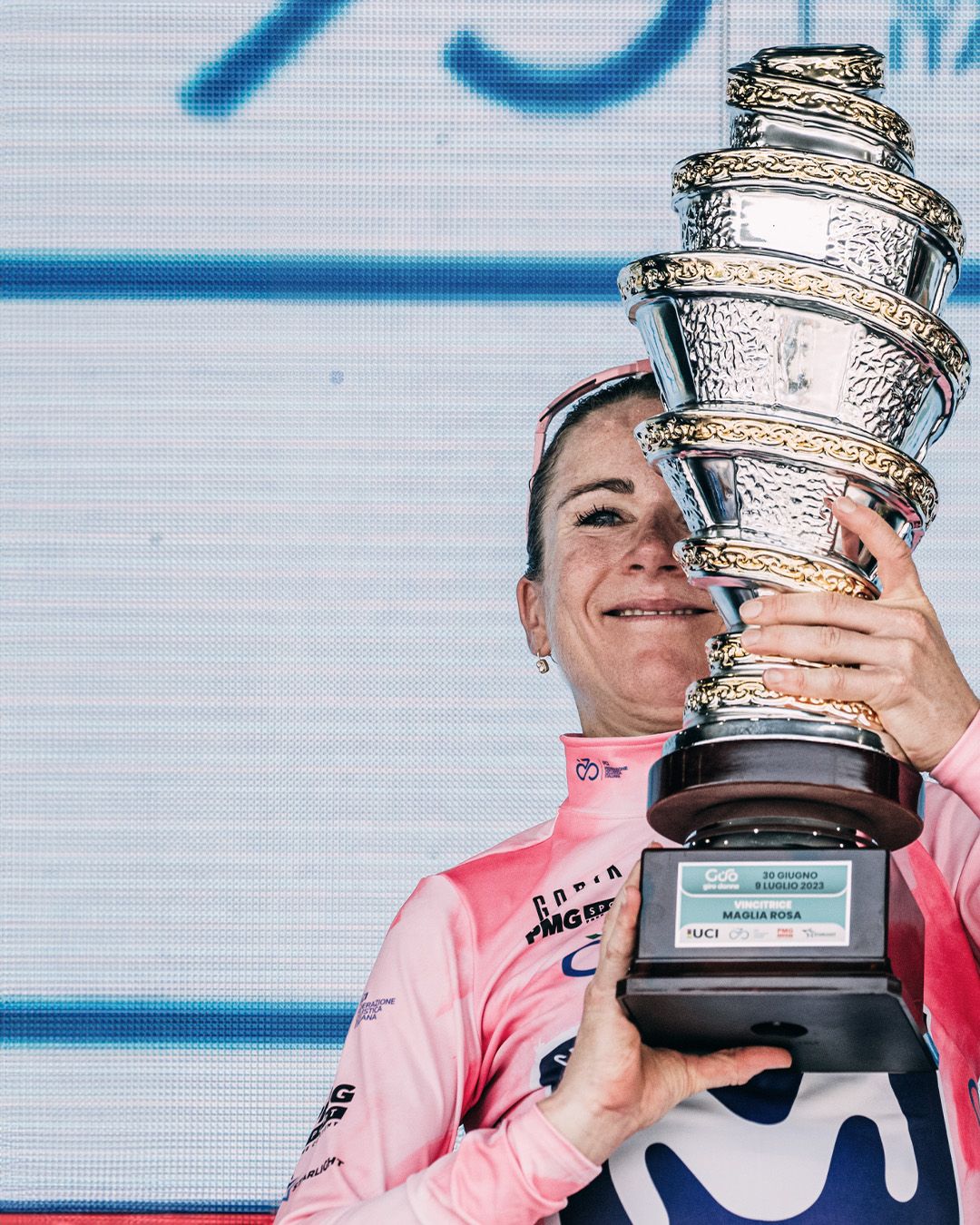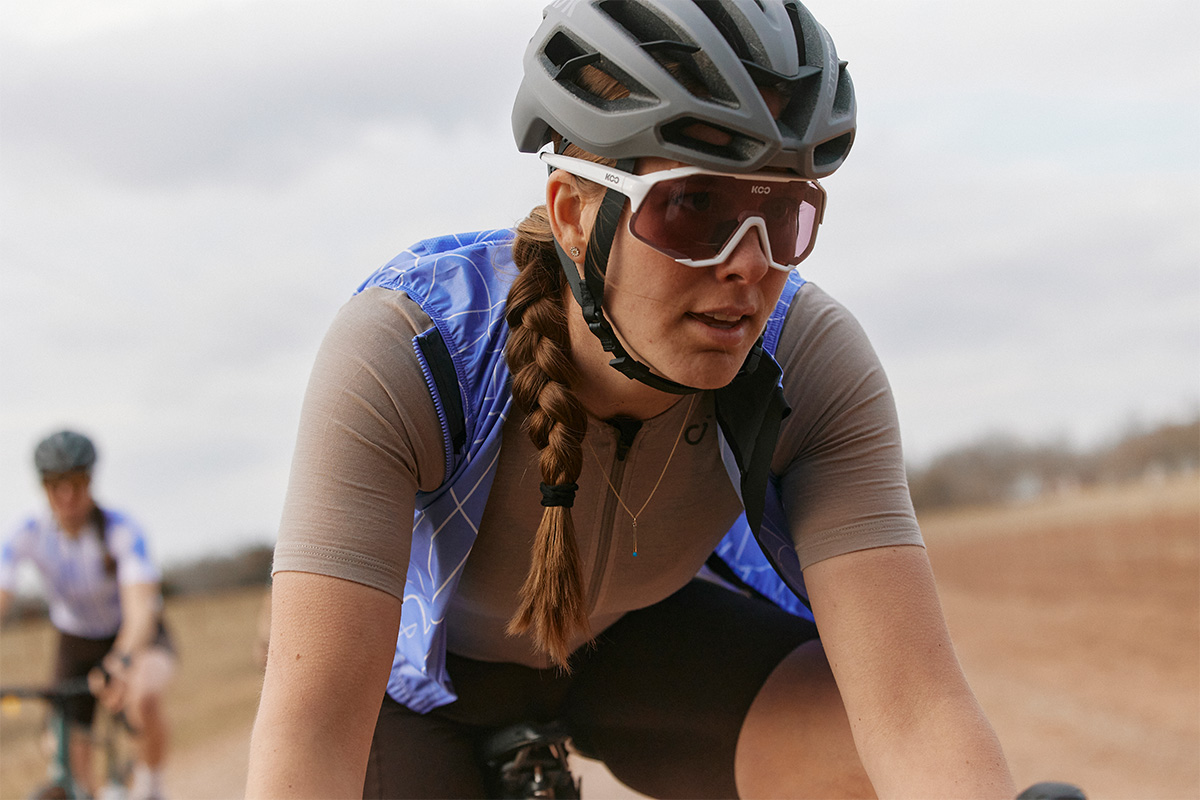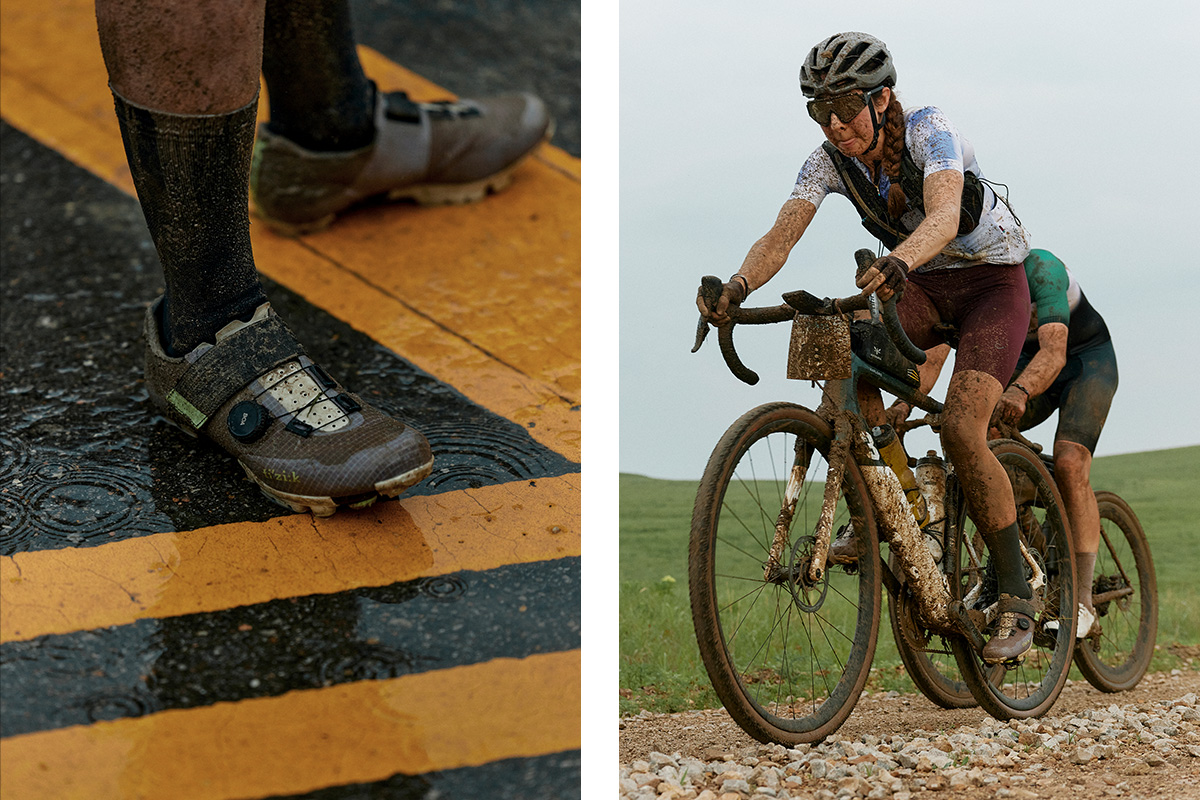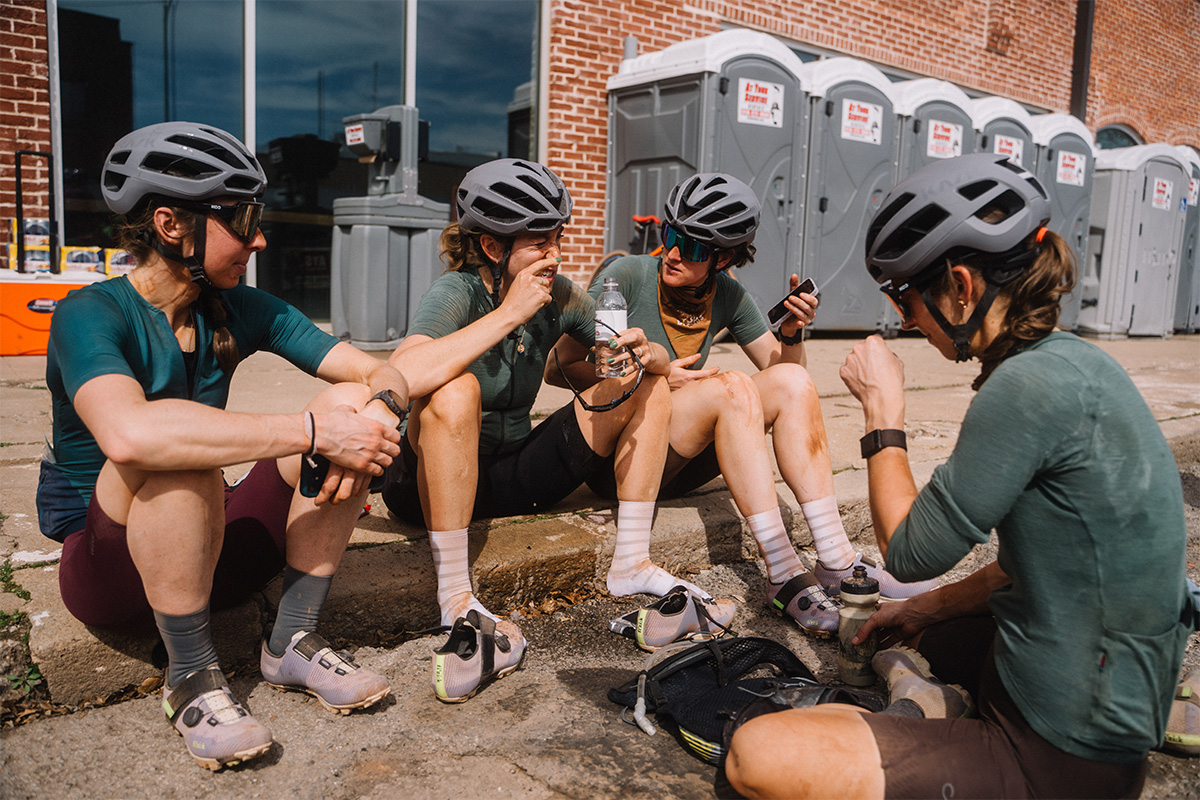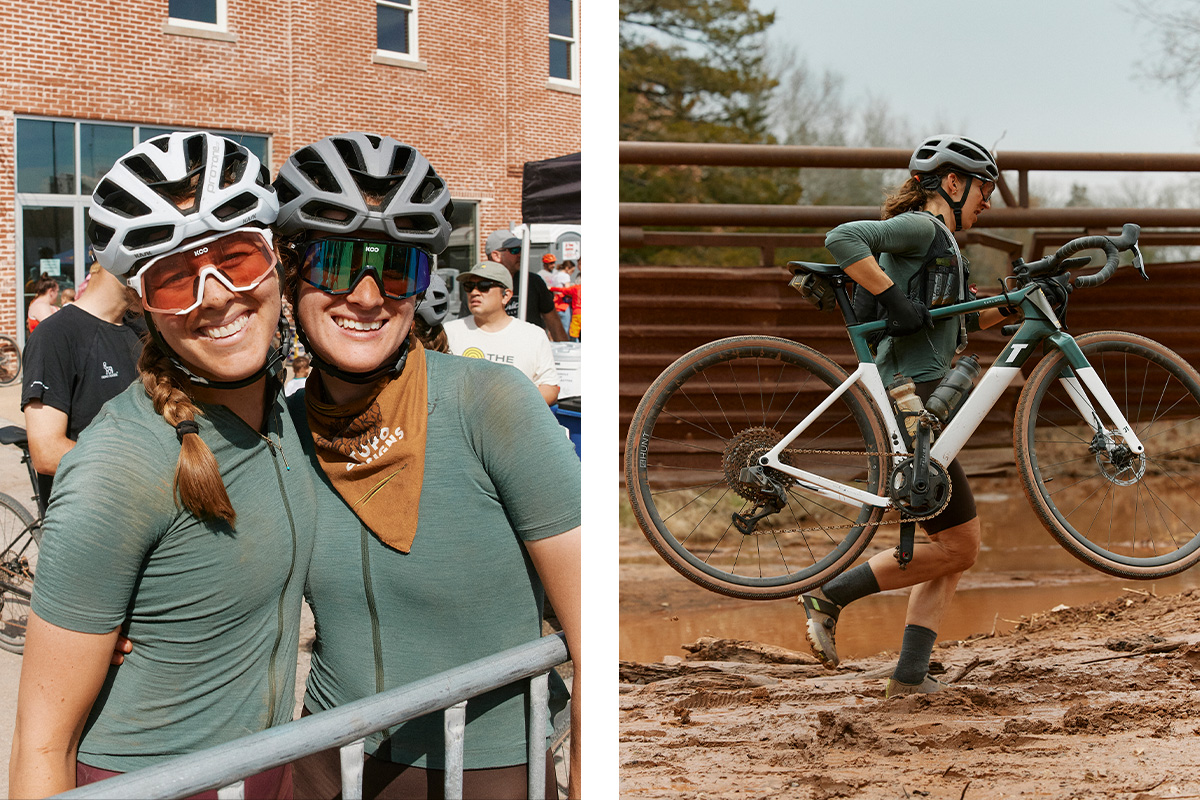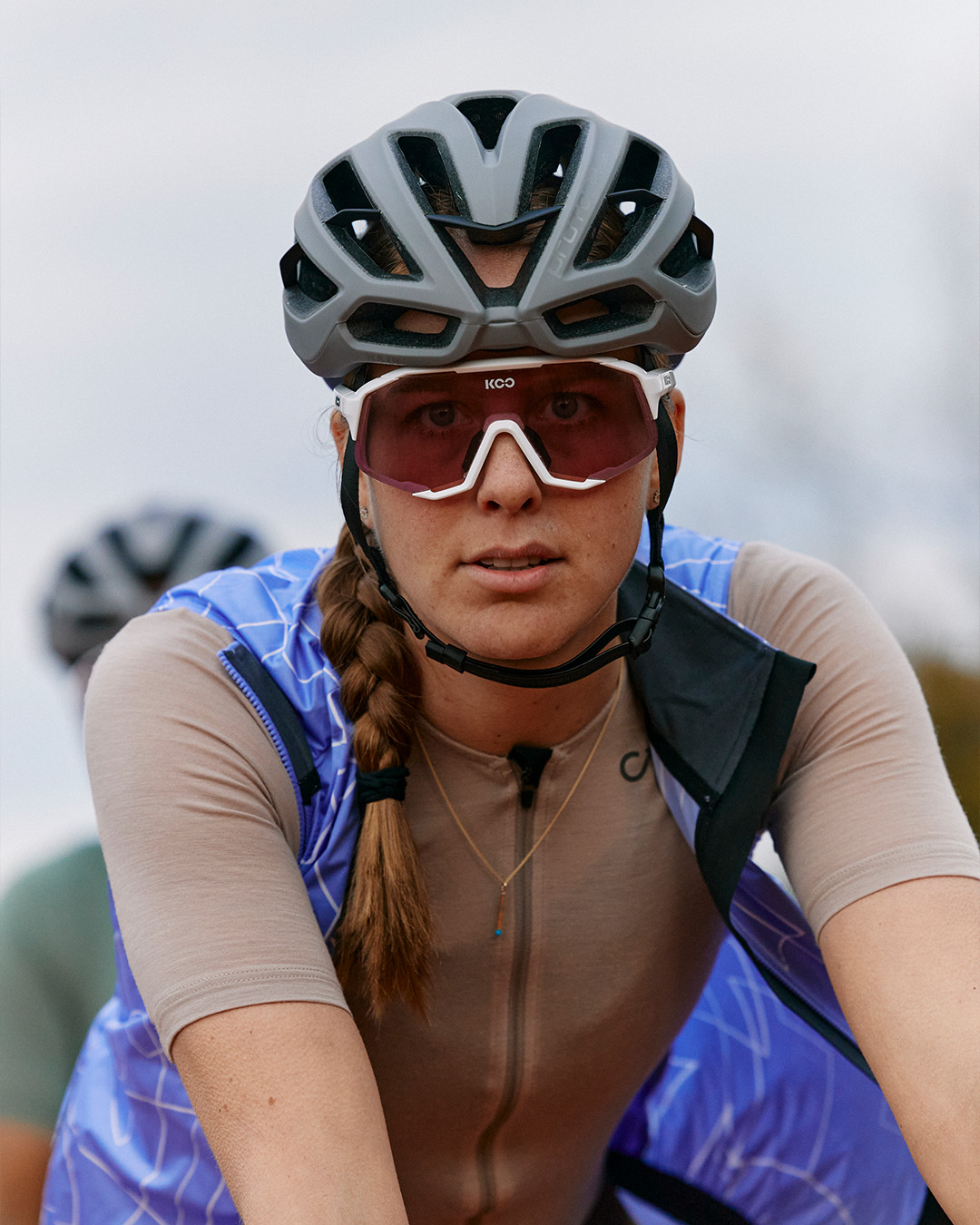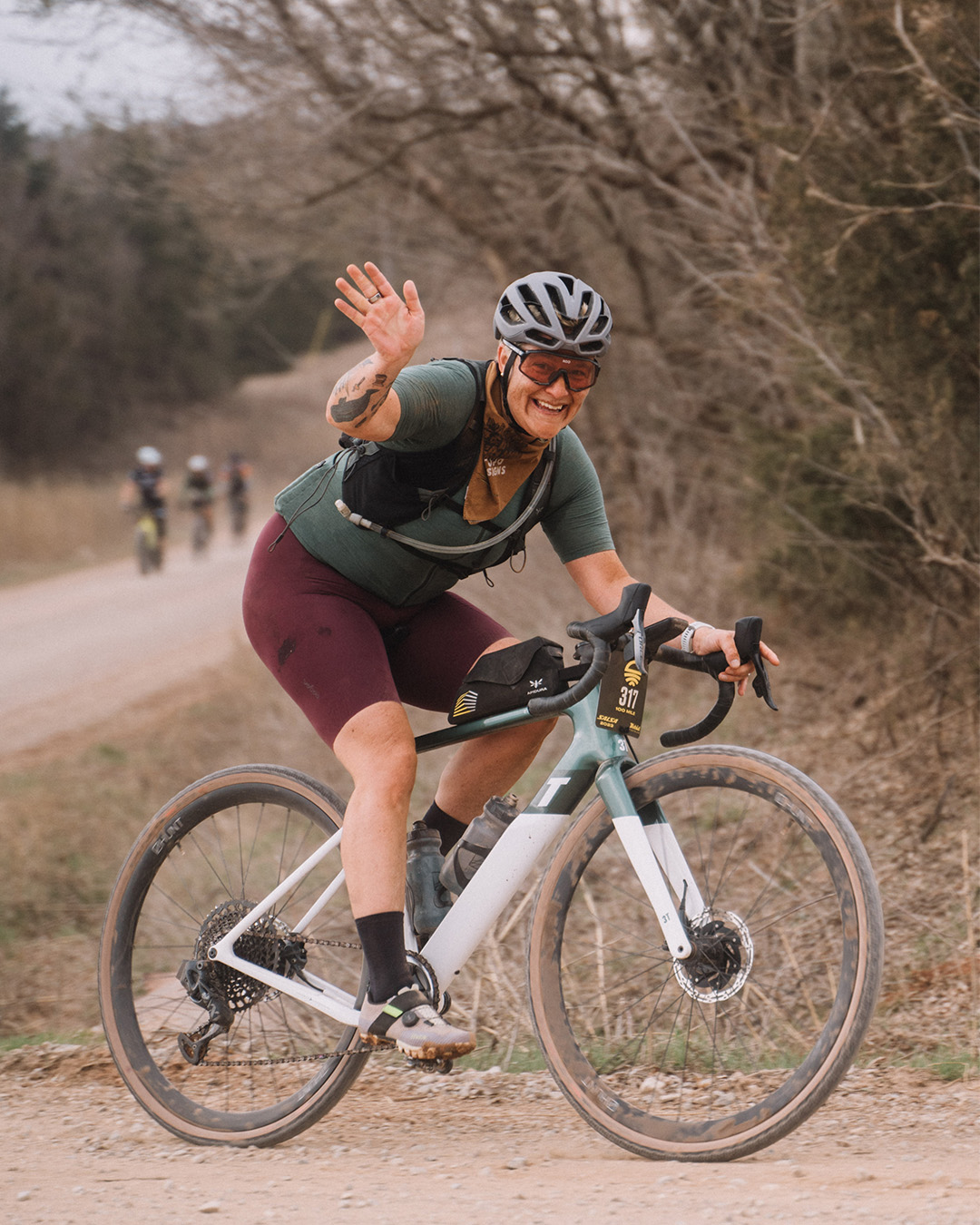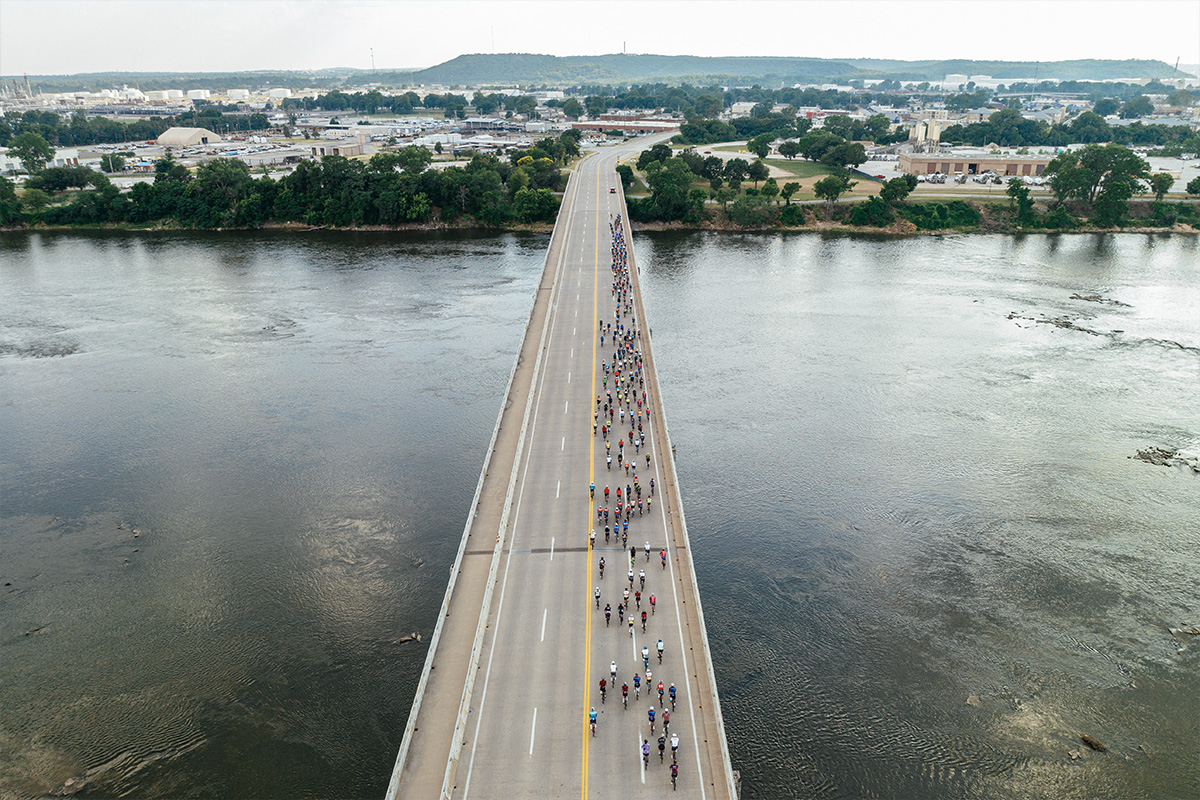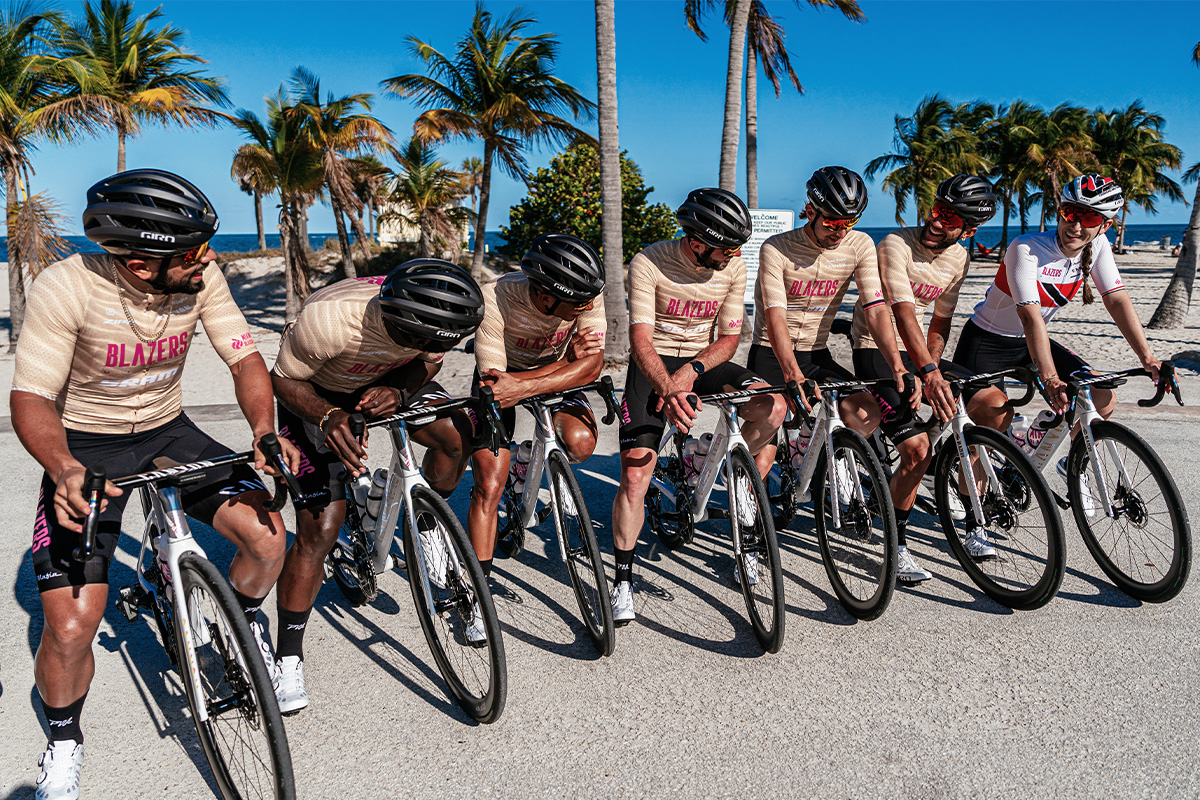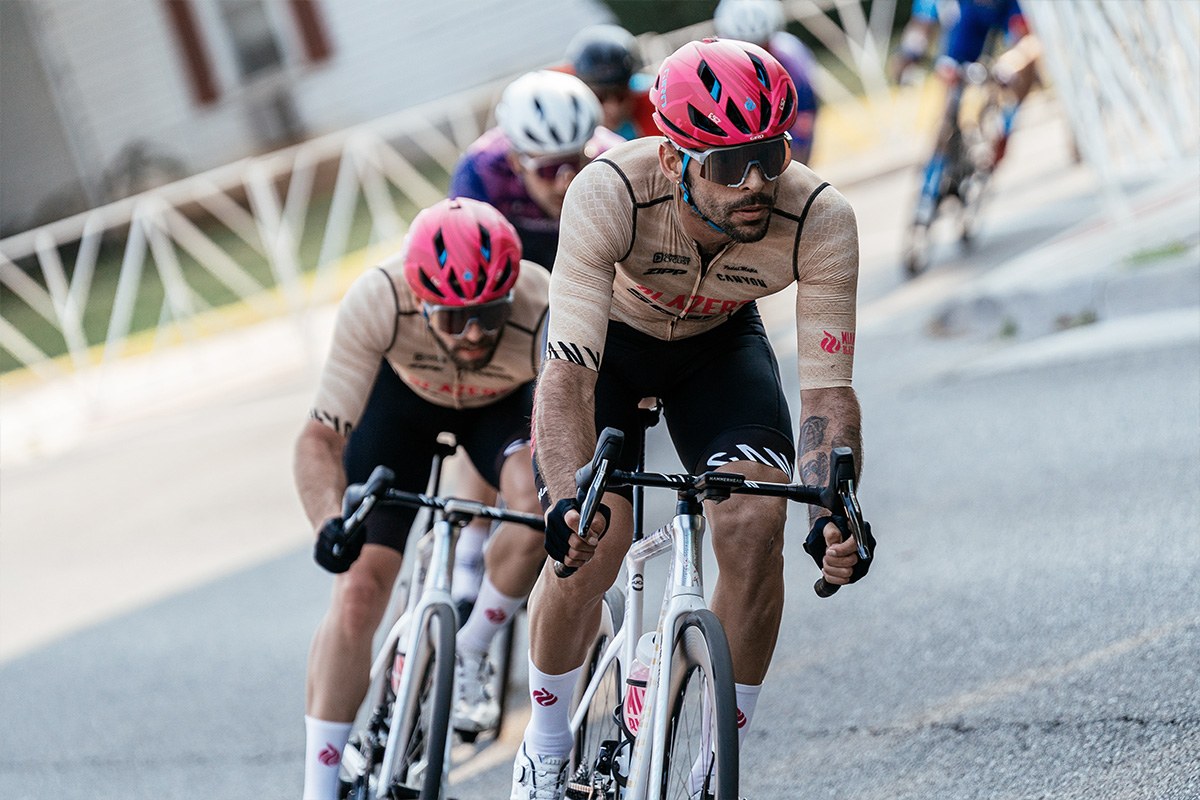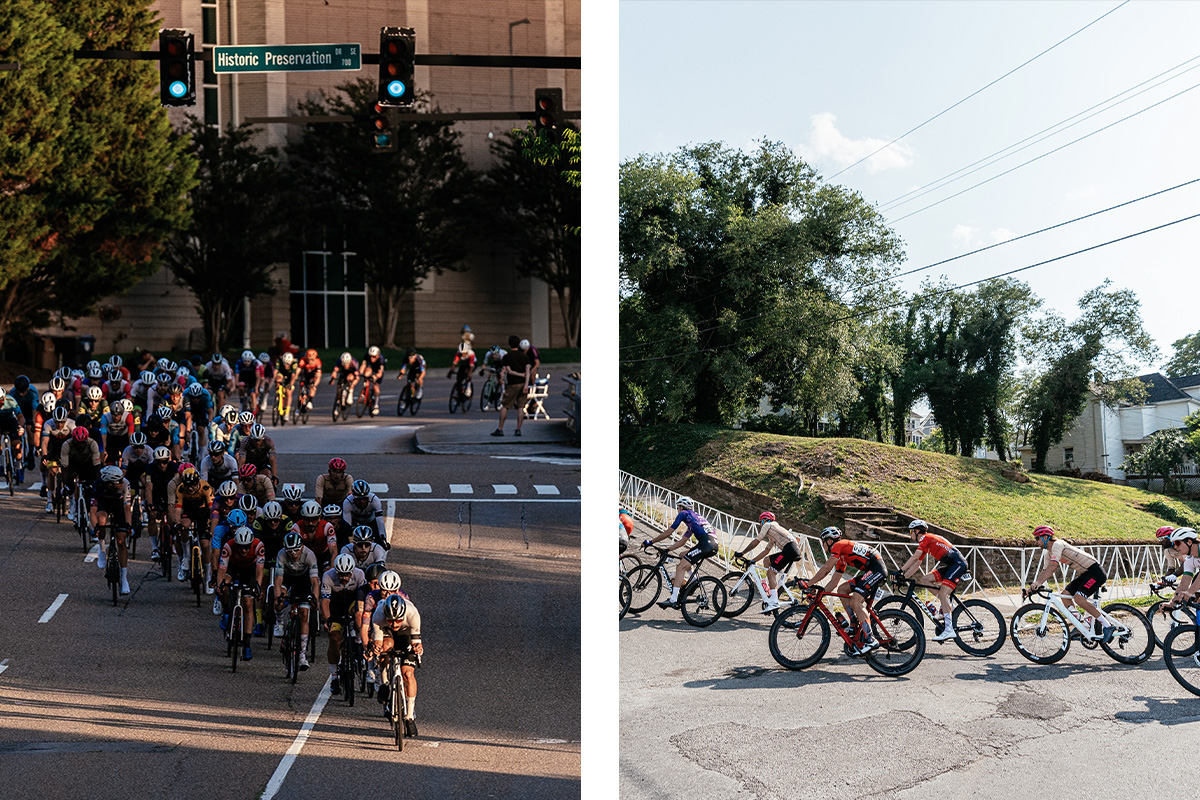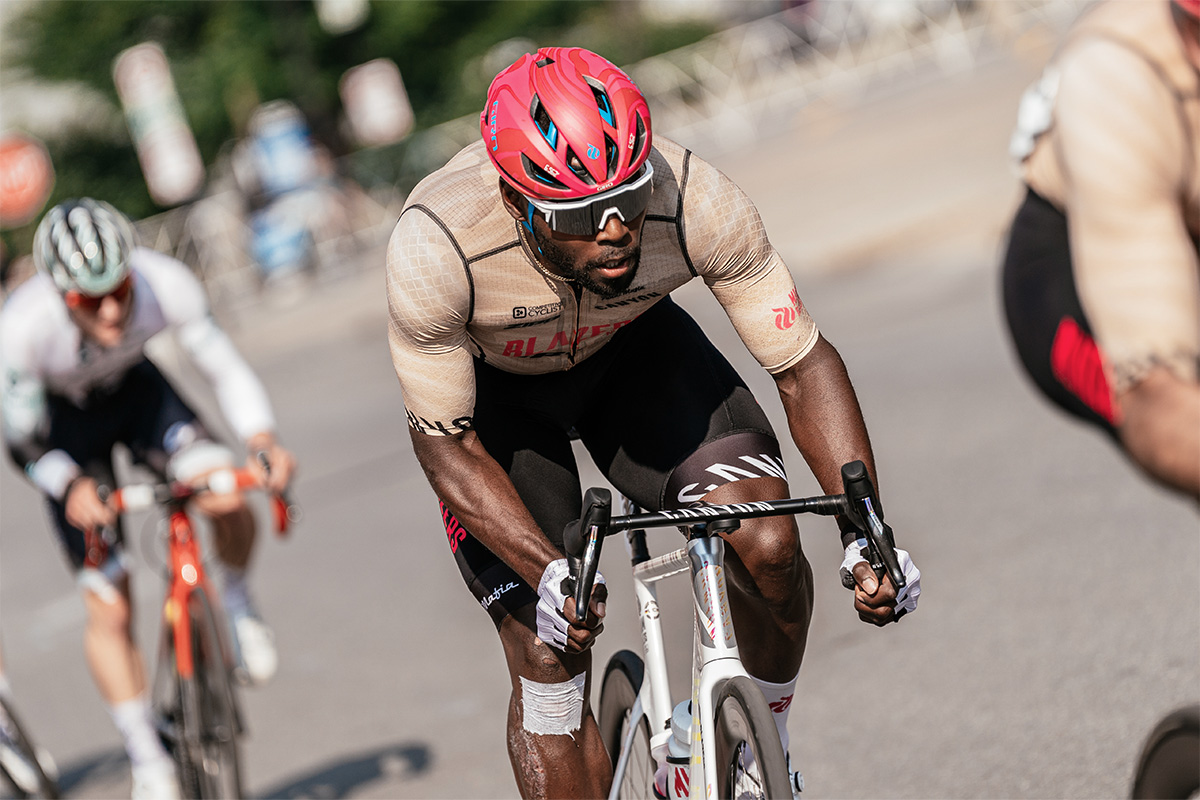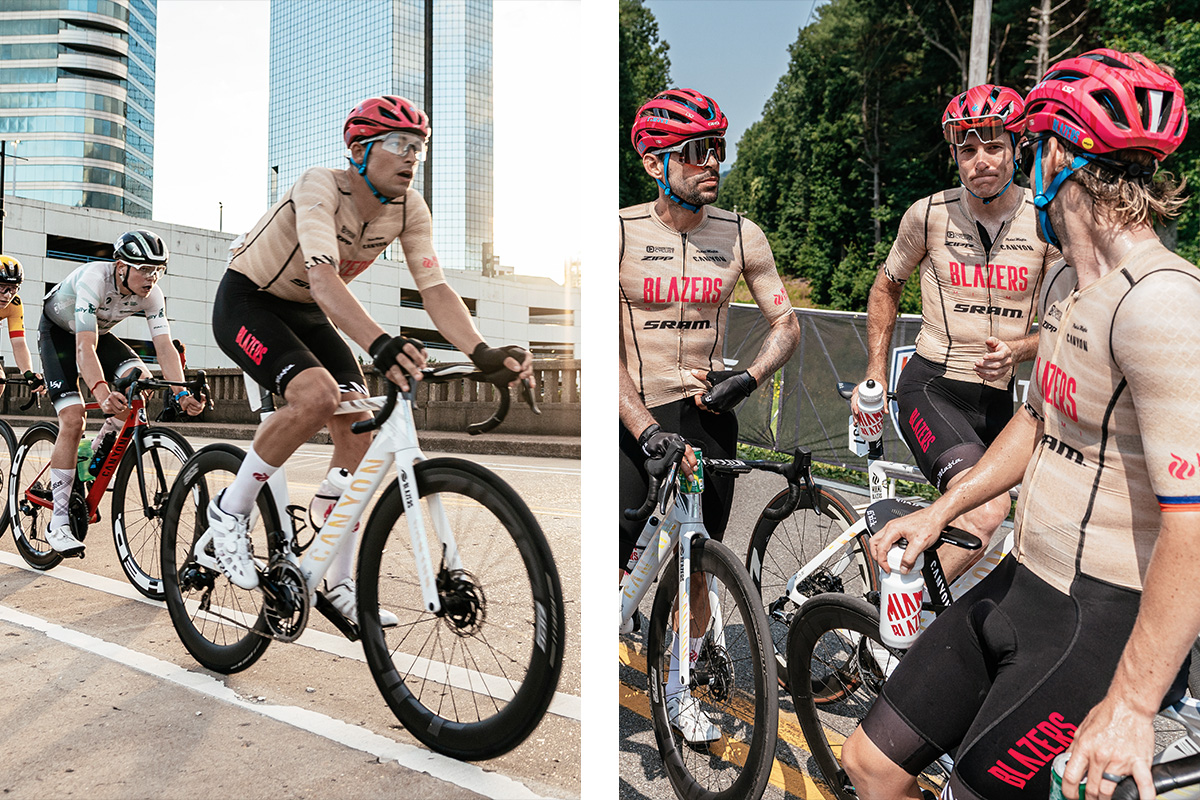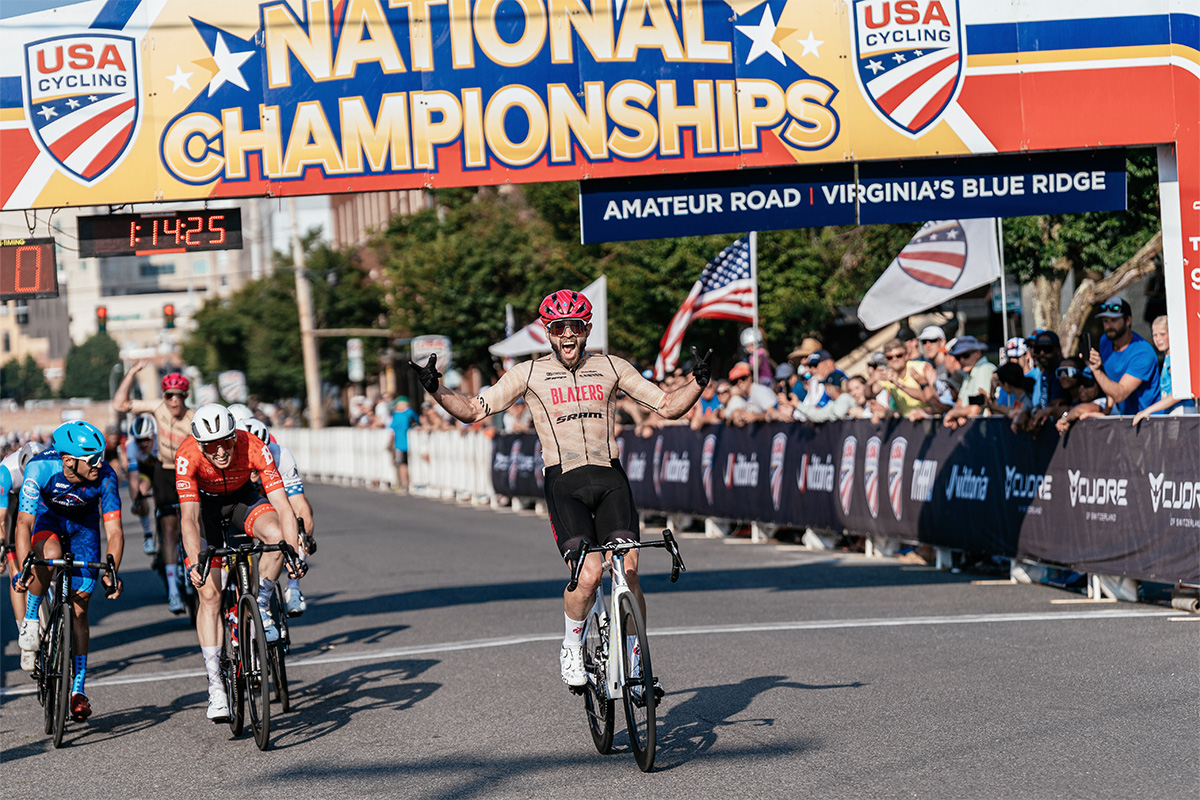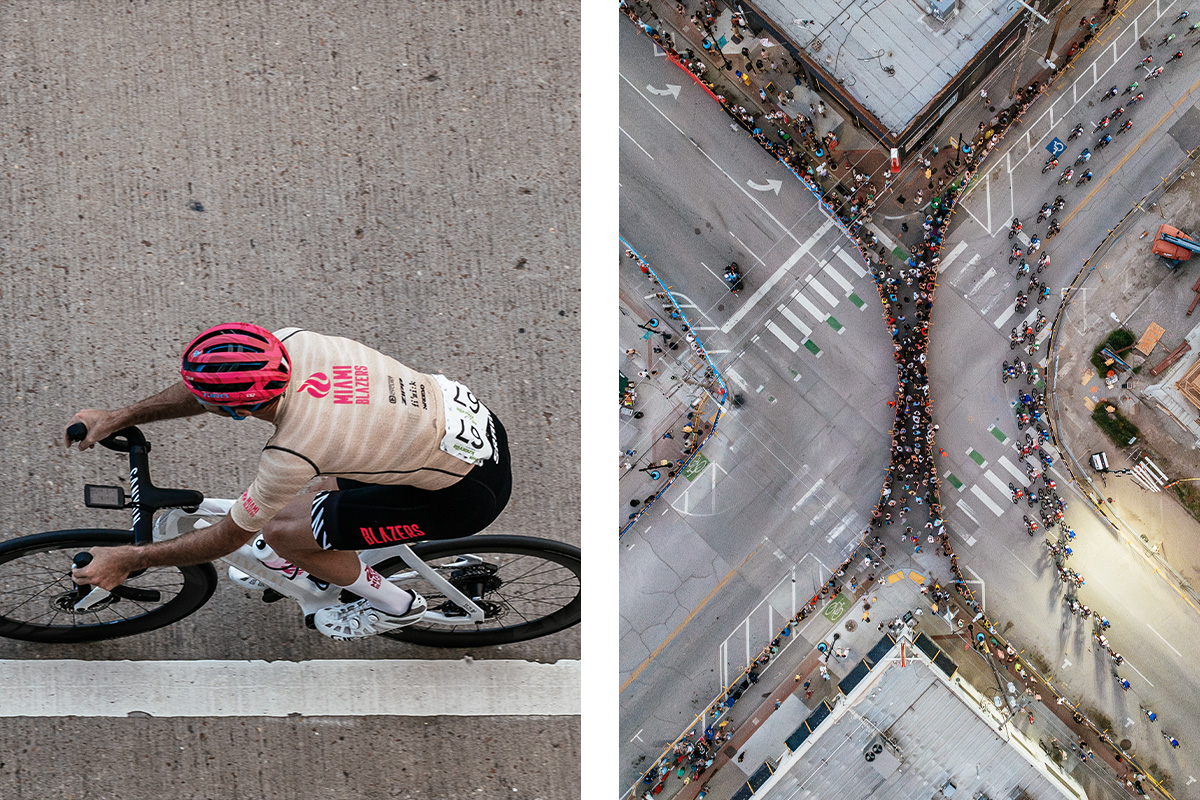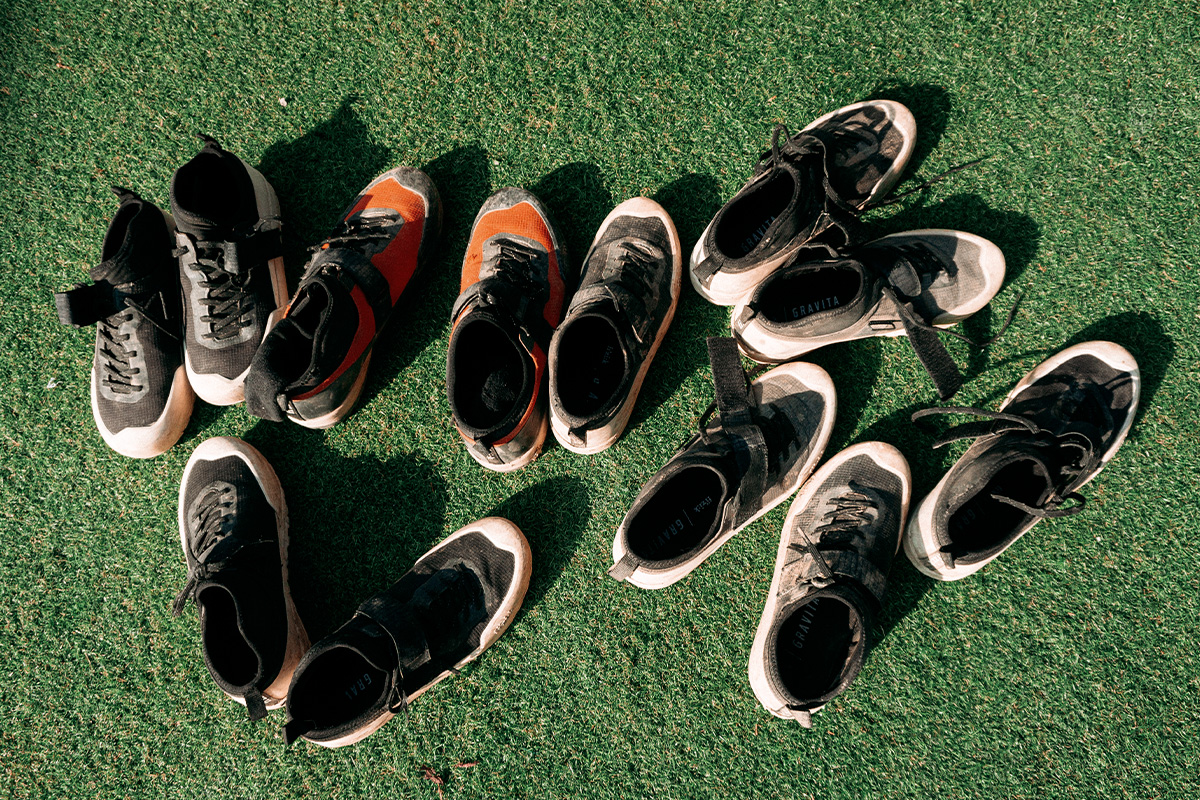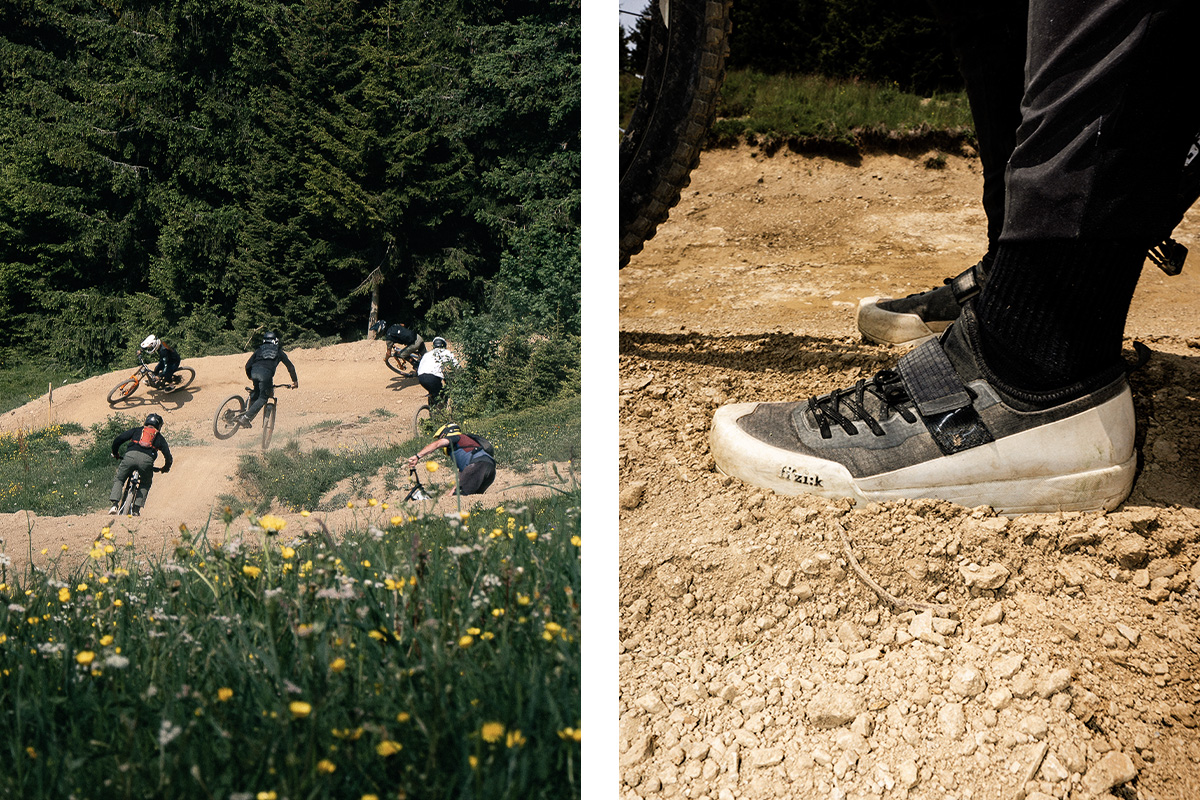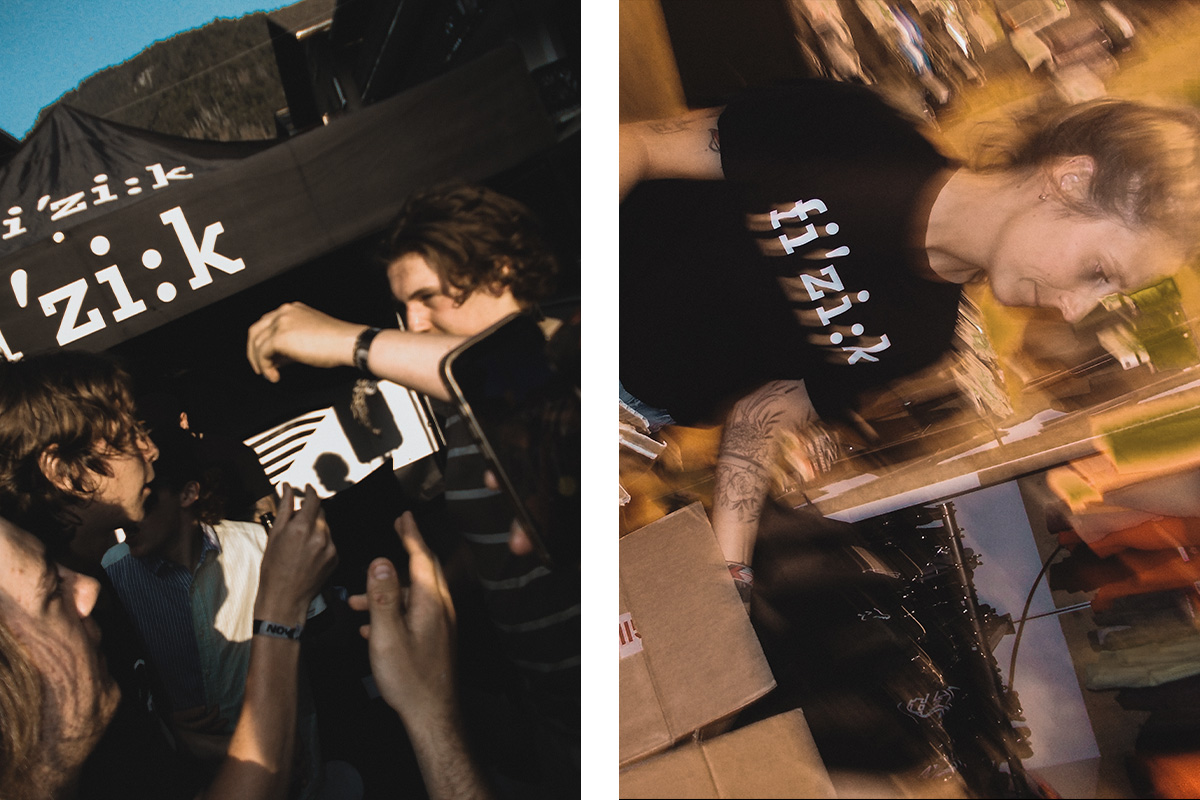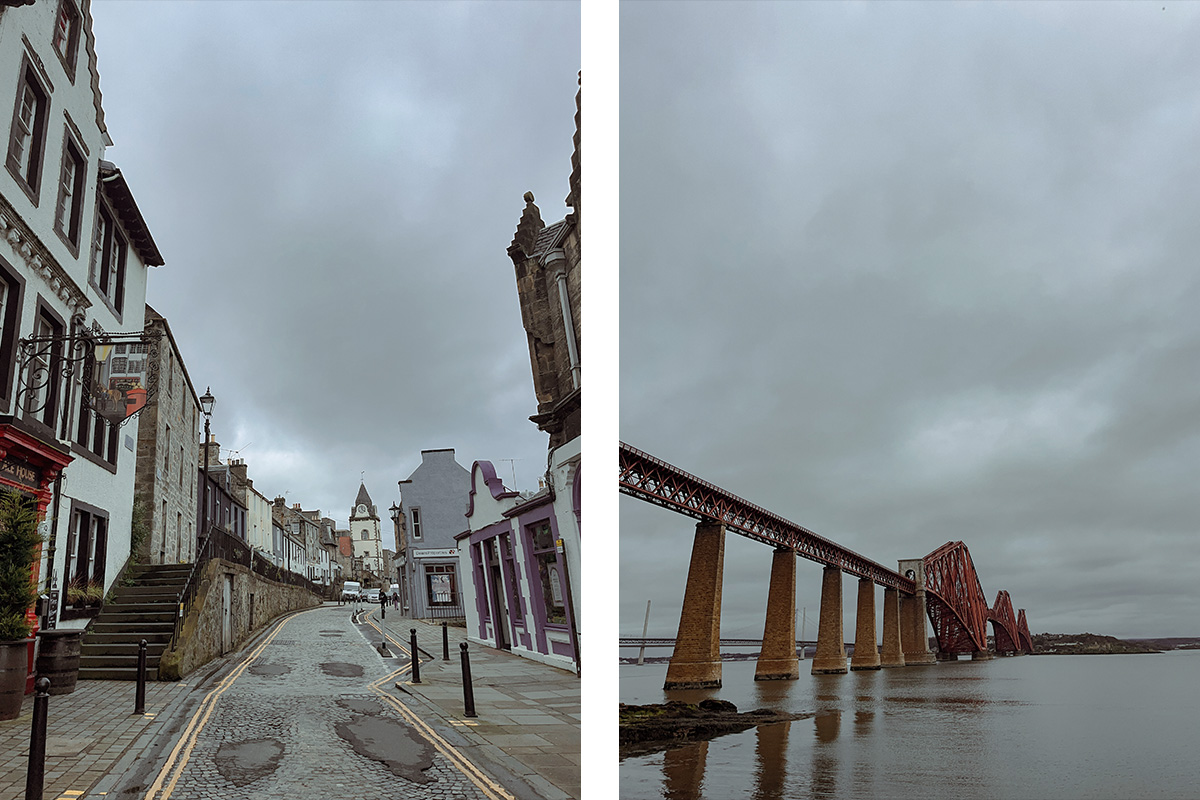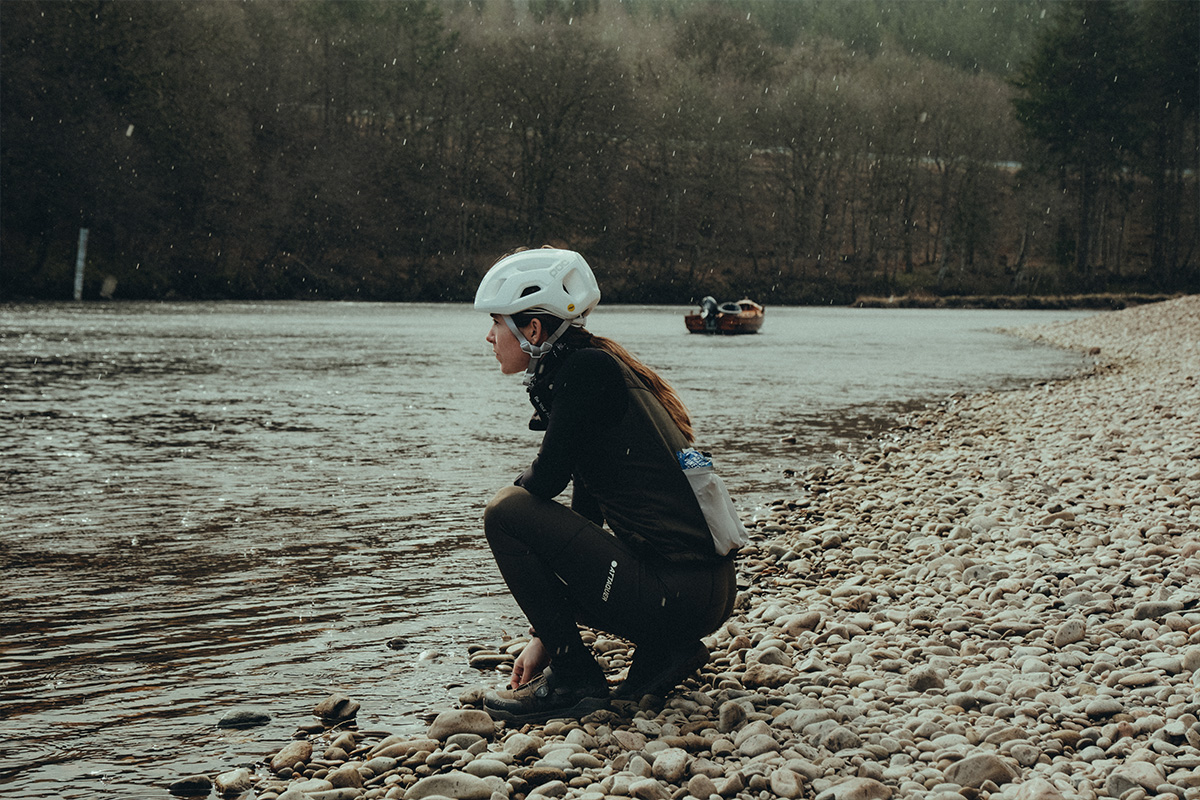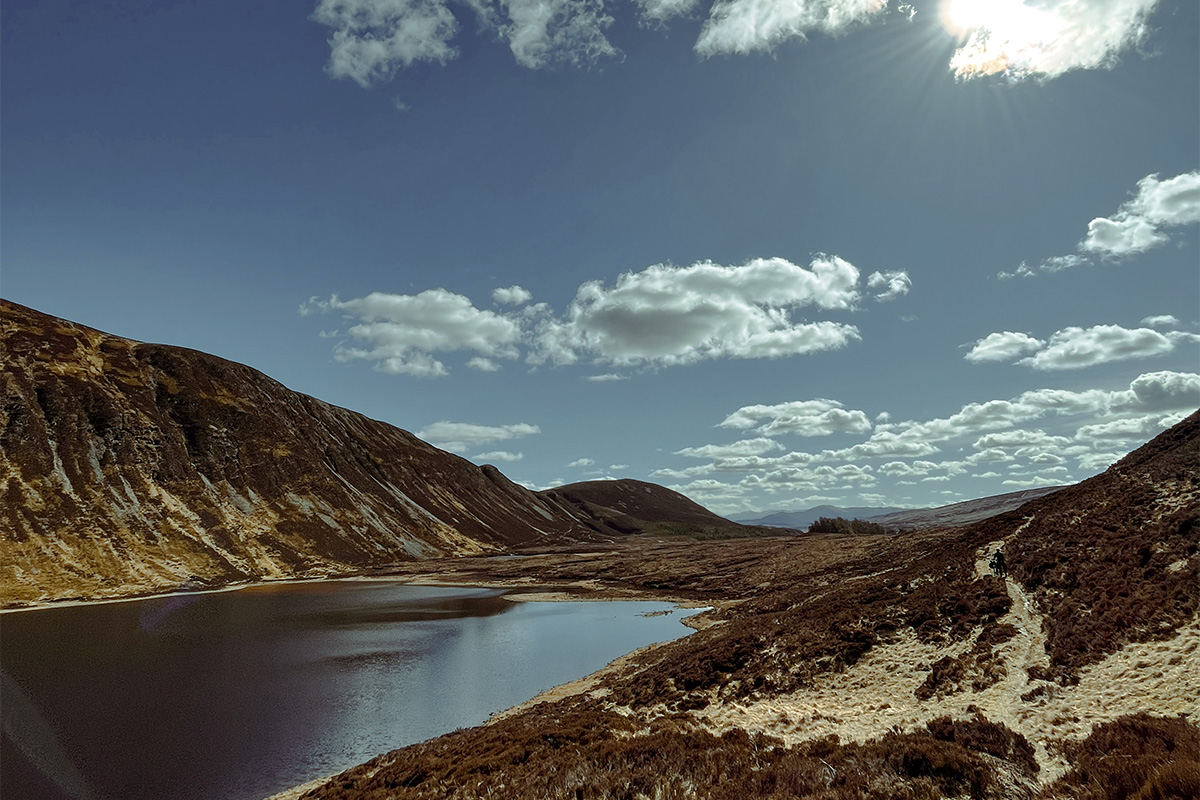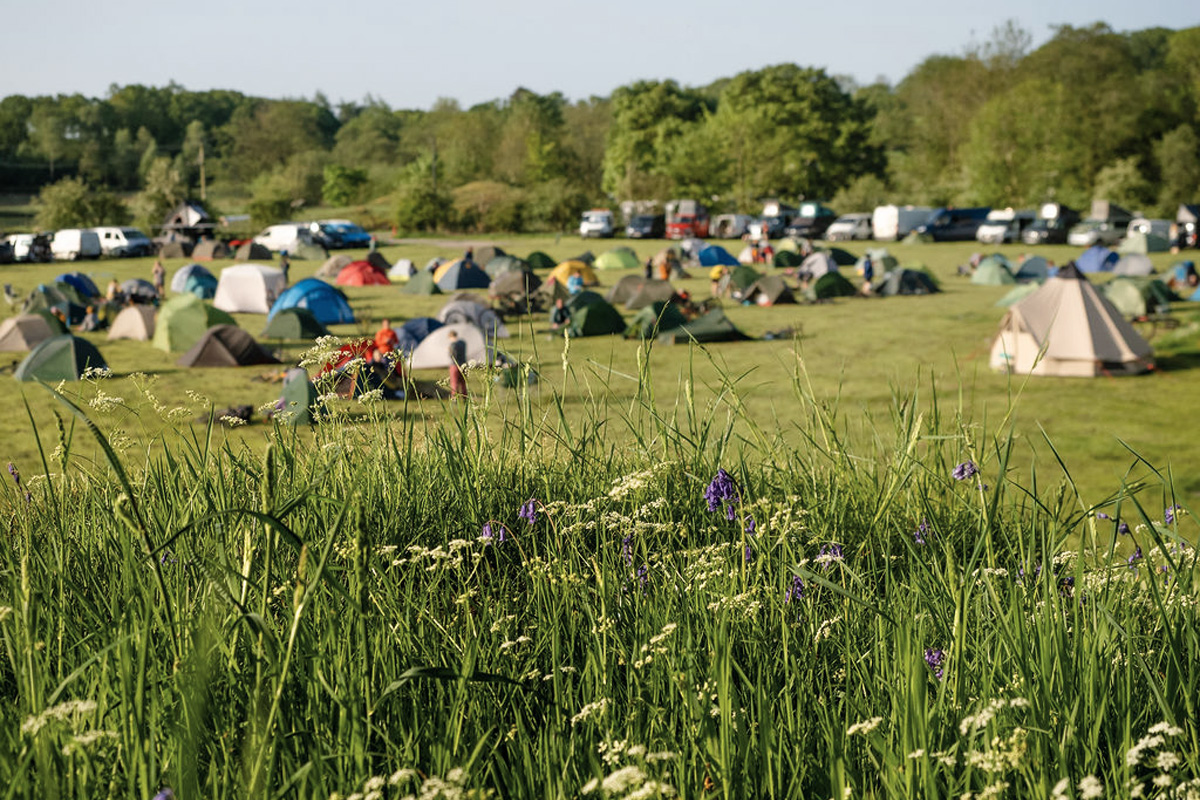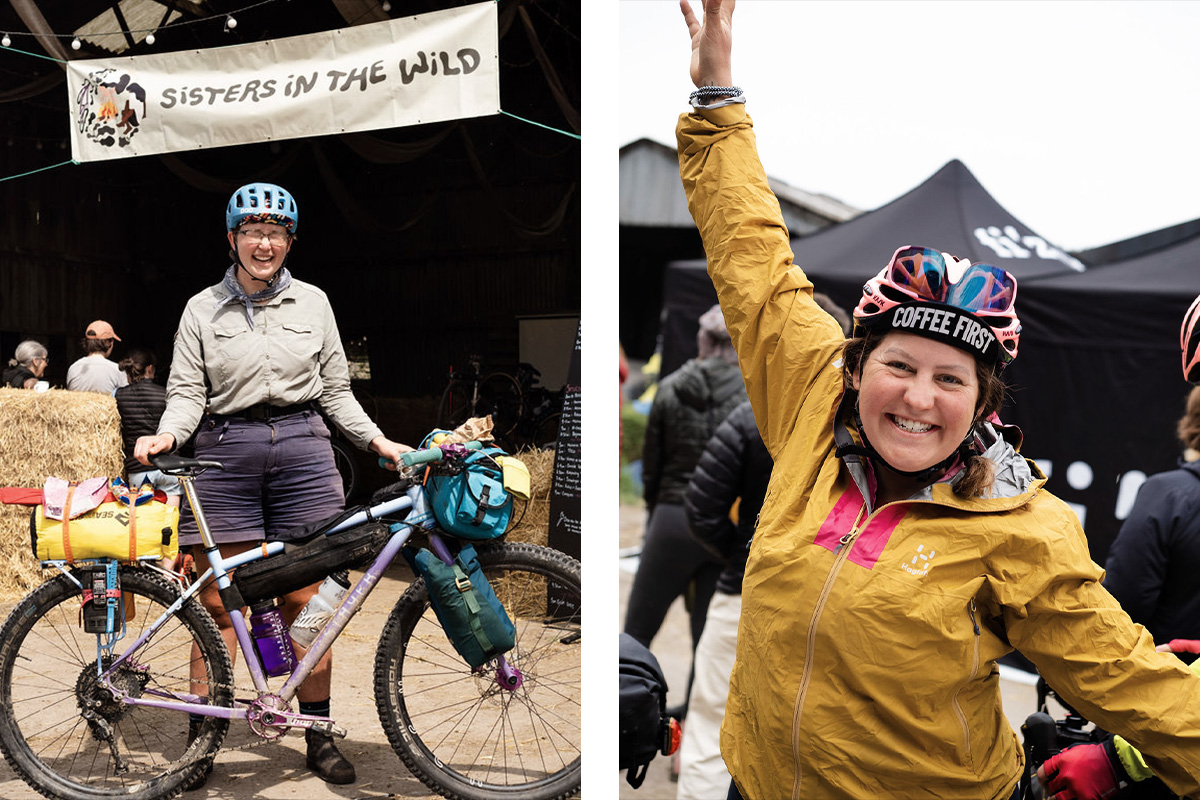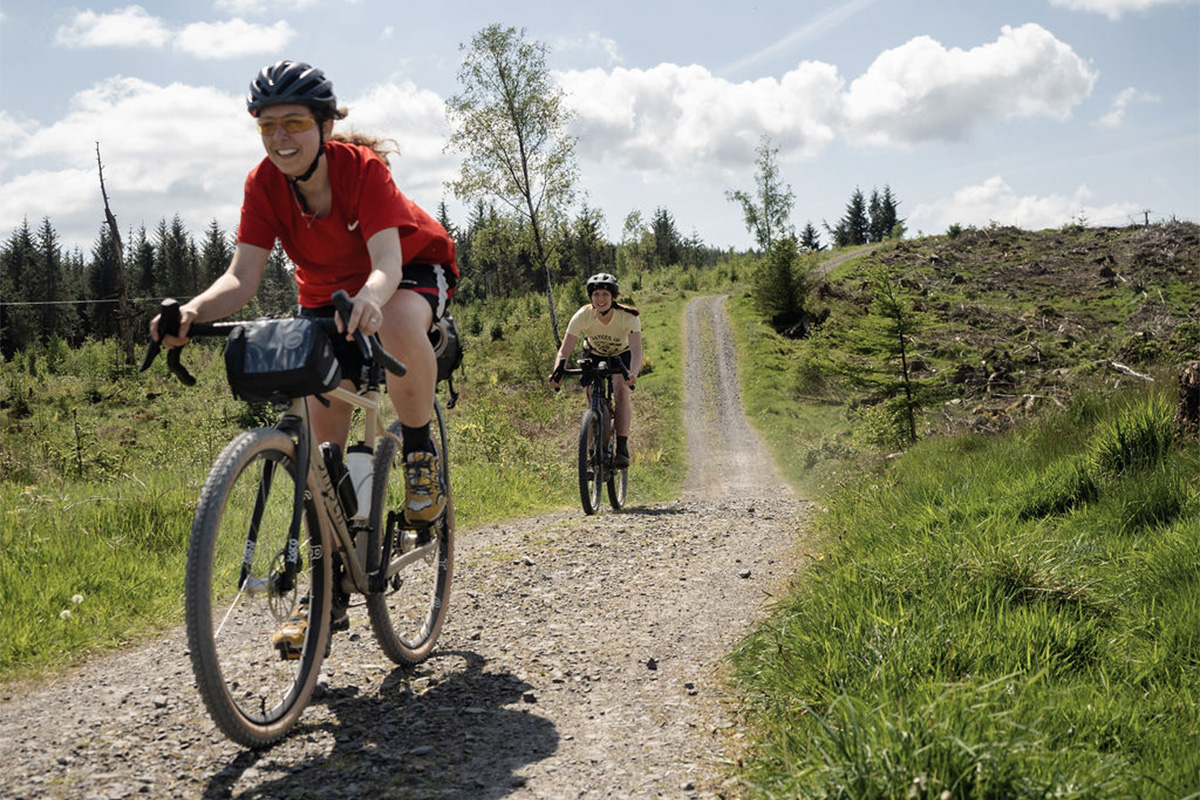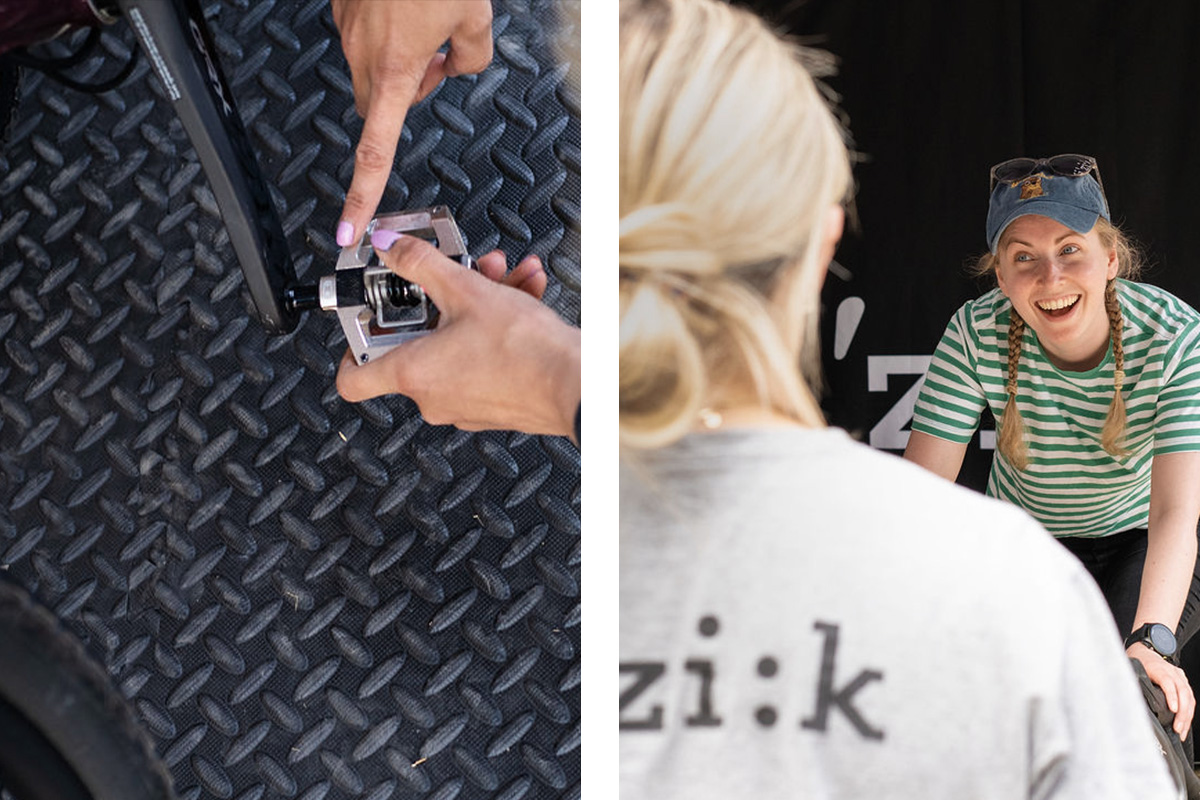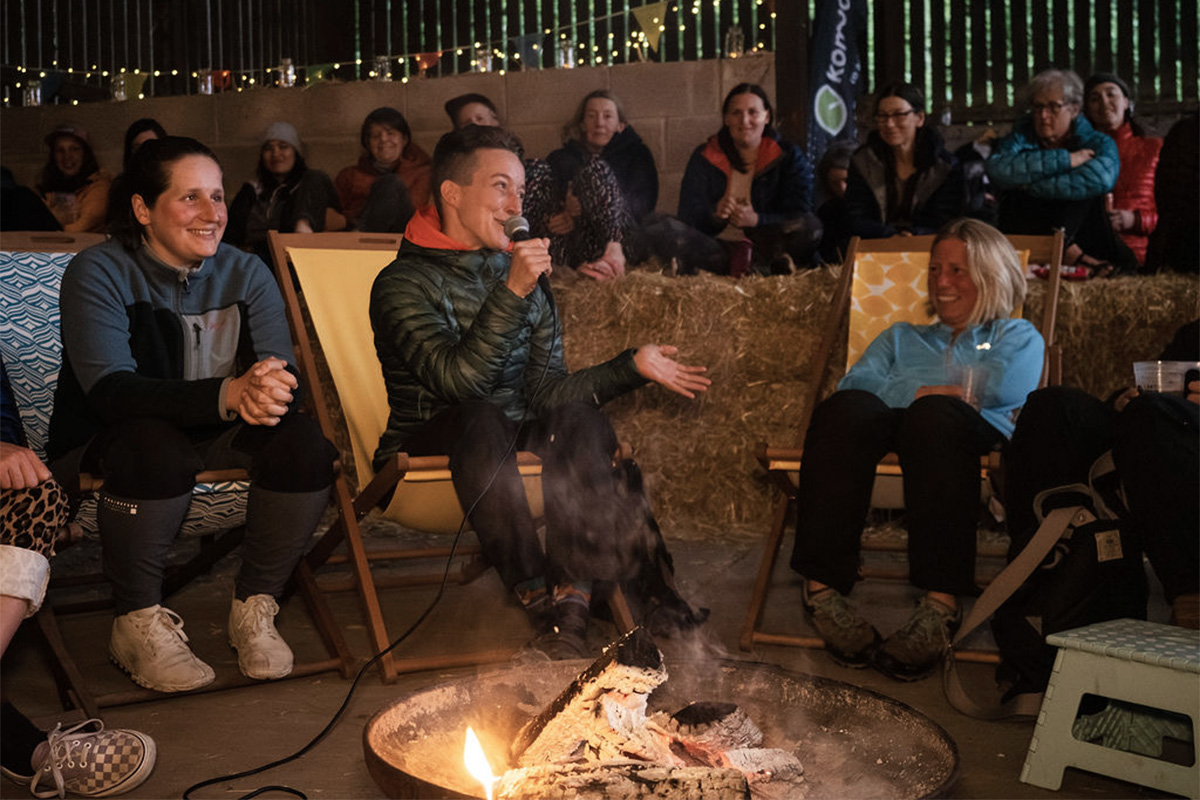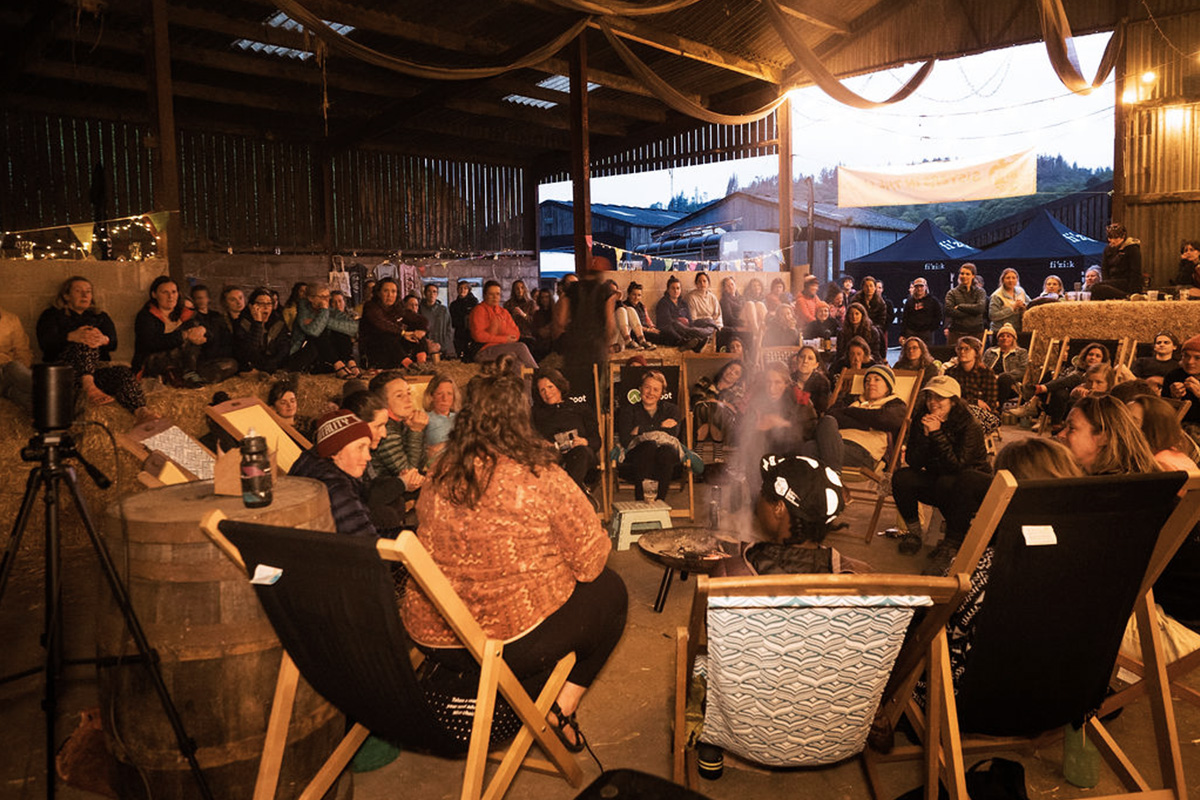Over the course of three weeks and 3,400 kilometers, history will be written again as Grand Tour racing soon returns to the streets of Italy. With the 107th edition of the Giro d’Italia promising shorter, faster routes alongside the typical tension of knowing that any one moment could mean the difference between victory and defeat, the countdown to Stage One in Turin is officially underway. But before the first wheels start spinning, we wanted to take a brief glance back at last year’s “Corsa Rosa” while looking ahead at the excitement the upcoming competition holds.
A FIRST WIN, A LOCAL AUDIENCE
While the Giro’s overall winner is bound to grab headlines, (we’re looking at you, Primož Roglič) there are numerous sub-plots on each stage that go into forming the greater narrative of Italy’s annual Grand Tour. One-such chapter unfolded last year on Stage 18, where a surprisingly fast start followed by a series of categorized climbs split the field and resulted in an early and determined seven-rider breakaway.
Amongst that bunch was Italian National Champion and fizik rider Filippo Zana. Heading into the 2023 Giro—his first with a World Tour team—Zana had resolved to do his champion status justice by earning at least one stage win. And on this mountainous 160km course, his time had finally arrived. Managing to keep the tempo as the breakaway quickly decreased from seven to two, Zana’s hard work and patience paid off in a final sprint to a summit finish in Val di Zoldo, claiming Giro glory while wearing his tricolor jersey in front of a local audience in his own backyard.
A BATTLE FOR THE HISTORY BOOKS
Of course, the 2023 Giro d’Italia had plenty of compelling threads to explore, with some—such as illness-related rider exits, crashes, course design, and extreme weather—playing a large role in shaping the race’s early stages. Then there was the main storyline: a fight between two legends, Geraint Thomas and Primož Roglič, which remained painfully, almost scientifically, close for much of the race.
The fact that Thomas managed to sport the coveted leader’s jersey for an impressive eight days of competition made it all the more of an upset when, on the penultimate stage, Roglič earned back just enough time to secure the Maglia Rosa when it mattered most. With a final lead of 14 seconds, Primož Roglič became the 2023 Giro d’Italia champion by the closest margin in nearly 50 years.
A STAGE TO WATCH
While it remains to be seen what shape the 2024 Giro will take over the upcoming three weeks of competition, eager fans are already eyeing this year’s second-to-last stage as another potential race changer. A far cry from the fast-paced time trial that determined the outcome in 2023, this year, Stage 20 is one for the climbers. With the 175km route making a double ascent up Monte Grappa, the finish sits at the end of what promises to be a fast, all-out descent for anyone trying to make up time—or make a name for themselves.
THE TEAMS TO BEAT
As the 2024 Giro approaches, marking the start of what’s sure to be another thrilling Grand Tour season, we’re thrilled to be lining up behind some of the best teams in the sport. Maybe we’re biased, but we believe these are teams to watch in this year’s race. Don’t believe us? Just check the records.
TEAM VISMA | LEASE A BIKE: Will history repeat itself for the individuals on Team Visma? Following Roglič’s GC win, the riders will have the wind in their sails—but also plenty to prove—in the 2024 Giro.
DECATHLON AG2R LA MONDIALE: The team may have only earned one stage win during the 2023 Giro, but AG2R riders did plenty to excite the competition, and we look forward to them bringing the same energy to this year’s race, too.
MOVISTAR TEAM: Following many notable moments and a remarkable stage win in last year’s competition, the riders of Movistar will be looking to push the pace once again en route to Rome. We’re just thrilled to be invited along for the ride.
With the stages set, riders ready, and countdown underway, it’s nearly Giro time again. Good luck to all the teams, organizers, and athletes. We’ll see you on the road.
Photo:
Tornanti.cc
There’s no way around it. When bad weather interrupts your adventure, the only way to get past it is to keep pedaling. But of course, proper preparation can play a large role in the impact rain has on your ride. Just ask MTB athlete Miranda Miller, who we recently caught up with to chat about her approach to making the most of soggy days on the saddle—and how her relationship with wet weather has evolved as she’s transitioned from weekend warrior to full-time pro.
What’s your relationship with bad weather?
I’m a believer in bad weather. People are like, “there’s no such thing as bad weather, just bad gear.” I grew up in 100 inches of annual rainfall. Yeah, there’s bad weather.
My relationship with bad weather has morphed and changed as my status as an athlete and a rider has morphed and changed. When I was a weekend warrior, there wasn’t the luxury of a weather window. Then as a full-time athlete, there’s almost too much luxury. Now I’m kind of floating in between. I remember that the best rides were those as a weekend warrior, bad weather and all.
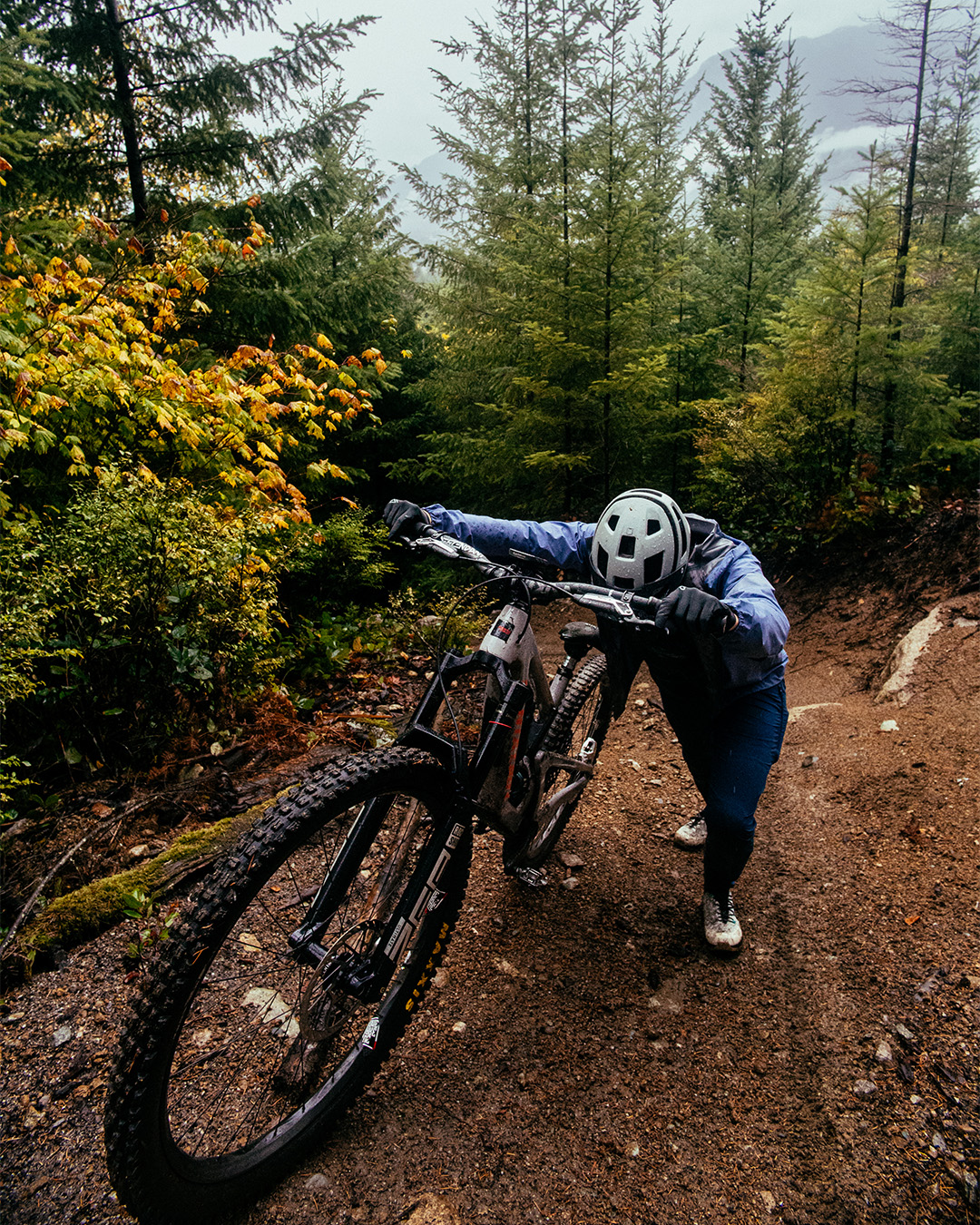
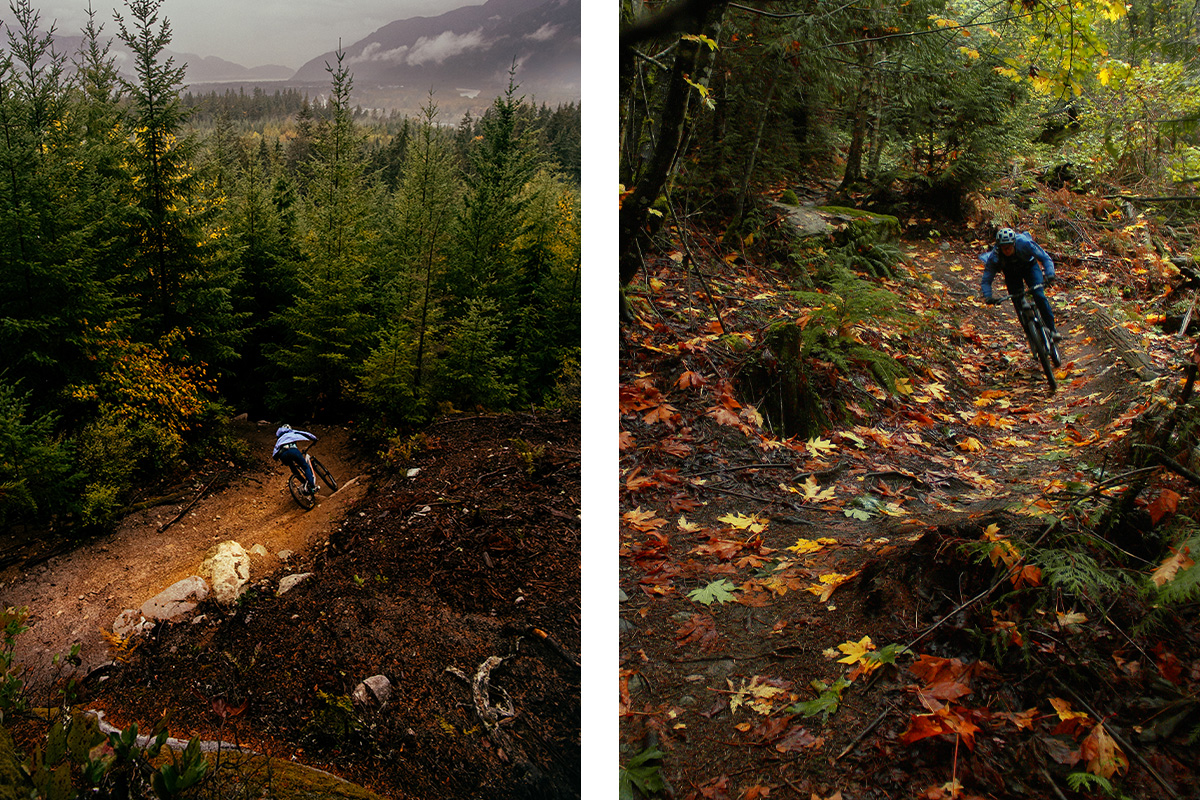
How do you prepare for a rainy ride?
If I can keep my hands and feet warm and dry, riding in the rain, or just after, is pretty good and sometimes I forget that. I try to layer correctly – more on my core than arms, merino socks, waterproof shoes and warm gloves. I like to have either a bag or bottle of just water, no drink mix, so I can clean my glasses throughout the ride. Keep the snacks handy, it’s less tempting to eat when it’s cold but just as important.
How do you deal with wet riding lines?
I’m lucky that in Squamish the conditions are best in the wet – the dirt is perfect and although the roots are slippery, there is always traction to be found in the dirt. Our rock is granite and while it should be respected, unlike east coast rock, there’s no need to fear it. It teaches you when and how to brake, and how to gain traction from your bike and body. Squamish is a temperate rainforest that looks and feels the best after a good rainfall.
Words — Miranda Miller
Photo — @graeme.meiklejohn
Like it or love it, gravel racing is officially here to stay. As formal a cycling discipline as road, track, or MTB, gravel has grown tremendously over the past decade with new events springing up seemingly each week across nearly every continent on Earth. (Antarctic gravel, anyone?)
From the Flint Hills of Kansas to the picturesque mountains of Girona, the volcanic tracks of Iceland to the dusty, red roads of Kenya, wherever unpaved routes roll, riders will quickly follow. And that includes many of our most dedicated athletes and ambassadors, who regularly line up to put themselves—and their fizik shoes, saddles, and more—to the test, mile after bumpy mile.
With many of this year’s big events behind us, we wanted to share a short recap of the 2023 racing calendar, so clip in and ride along as we look back at another exciting season spent far off the tarmac.
THE TRAKA
One of the earliest international events of the summer gravel season—and the first stop of the collective Gravel Earth Series, The Traka is set in what’s fast becoming Europe’s most vaunted cycling capitol: Girona, Spain. Held this year at the end of April, The Traka offered riders four courses of differing lengths on which to push their pedals: 50, 100, 200 or the full 360KM.
Riders turned out in droves, including some familiar faces from the fizik roster, both for the thrill of competition and to experience the laid-back Catalonian lifestyle. Sami Sauri, Paul Voss, Mattia de Marchi and his fellow Enough Cycling teammates, the women of Velocio // Exploro, Nathan Haas, and Nils Correvon were all amongst the riders who showed up to take on this year’s Traka.
As corks were popped and champagne sprayed, however, it was three-time Traka champion Mattia de Marchi who once again found himself the winner of the weekend’s biggest challenge, finishing the 360KM course in a record-breaking 12 hours, 55 minutes, and 42 seconds. Fellow fizik rider Nils Correvon reached the line not too far behind in an admirable fourth place.
The men’s 200KM category proved equally exciting, as fizik athlete Paul Voss earned the top spot in unusual form, running rather than riding across the line after a flat tire in the final meters nearly cost him the win. Standing on the podium beside him was Nathan Haas, whose efforts in a three-way sprint paid off with a second-place finish.
UNBOUND
The big one, the “World’s Premier Gravel Grinder”, the OG—UNBOUND is perhaps the most celebrated gravel race in all of cycling. With a history that spans nearly 20 years, UNBOUND invites riders from around the world to middle America to test their mettle against the harsh, unforgiving—and frequently muddy—Flint Hills of Kansas, transforming the usually sleepy town of Emporia into an international cycling hub for one weekend a year.
Like The Traka, UNBOUND offers riders varying lengths, ranging from a short 40KM race all the way up to the XL 560KM event. Also like The Traka, the 2023 UNBOUND welcomed many regular characters from the fizik crew—including not only our athletes, but also members of our brand team who made the trip to support those racing the first weekend in June.
The riders of Team Amani, professional record-setter Lachlan Morton, the men and women of Enough Cycling as well as US-based Velocio // Exploro all traveled to take on the legendary Kansas gravel. And all were greeted with the type of riding that has made UNBOUND as exciting as it is notorious: mile after mile of sticky “peanut butter” mud that ensured this year’s event was truly one to be remembered.
Given that 900 riders were unable to even complete their chosen races due to the challenging course conditions, it’s all the more of an achievement for those who managed to keep pedaling (and pushing) their way to the finish, including Lachlan Morton who claimed third in the men’s 320KM race.
THE MIGRATION GRAVEL RACE
With an ethos that extends far beyond competition, the Migration Gravel Race was founded as part of the broader Amani Project, an initiative aimed at creating more equitable competitive opportunities for East African cyclists. Unique in format compared to many races on the gravel calendar, the Migration Race is a four-stage, 650KM, semi-supported competition for local and international cyclists alike held each summer on the rolling roads of Kenya’s Maasai Mara National Preserve.
Surrounded by lush, green vegetation, and sharing the scenery with the occasional giraffe, zebra, or elephant, many of cycling’s top off-road pros make the pilgrimage each June to experience “The Wildest Gravel Race in the World.” Joining the local heroes of Team Amani for the 2023 MGR were fizik athletes Lachlan Morton, Nathan Haas, Sami Sauri, and the riders of Enough.
Beyond the stunning setting, perhaps the most exciting feature of the Migration Gravel Race is its format, with each stage offering a new experience and each new day providing the potential for victory, which is exactly what Lachlan Morton proved on day two, edging out eventual overall winner Lukas Baum in a sprint finish to claim the Queen’s Stage. Stage three marked another big win for fizik riders, with Amani member Kenneth Karaya breaking away early and holding his lead to take the day for the home team.
With preparations underway—and registration open—for the 2024 Migration Gravel Race, we can’t wait to see what unfolds in the next chapter, as well as how off-road racing continues to expand throughout East Africa.
SBT GRVL
As bold of an event as it is beautiful, SBT GRVL (shorthand for Steamboat Gravel) is touted by organizers as taking place on “the greatest gravel roads on Earth.” Held each August in and around the resort town of Steamboat Springs, Colorado, SBT GRVL was founded in 2019 on the idea of bringing more inclusivity into the off-road racing scene. In doing so, they became one of the early races to provide ride lengths for all skill levels as well as adopting an intentional focus on entertainment for friends and family of racers in town for the event.
With champagne gravel, sunny skies, and miles of mountainous Colorado roads, the stage was set for some serious competition in this year’s main event, the 142-mile (228-kilometer) Black Course. Fizik riders Lachlan Morton, Payson McElveen, and the women of Velocio // Exploro were all in attendance, ready to make tracks as the race got underway with a lightning-fast start.
An early breakaway split the men’s lead group and set the tone for much for the day, which would see attacks launched, defended against, then launched again all the way to the finish line. The same held true in the women’s category, with escapes made and chases ensued. And while no fizik riders would claim SBT GRVL’s top spot—an honor that would go to gravel powerhouses Keegan Swenson and Sofía Gómez Villafañe—four of our riders earned top-ten spots: Lachlan Morton in fifth, Payson McElveen in seventh, Katie Kantzes in eighth, and Sarah Lange in ninth.
THE RIFT / OCTOPUS GRAVEL
Two more adventurous summer events—and two more members of the Gravel Earth Series—The Rift in Iceland and Octopus Gravel in the Swiss Alps filled this past July with plenty of challenge and excitement. The month opened with Octopus, which held its second edition on July 1st. Presenting a truly unique format, if you want to understand how Octopus operates, the key is in the name—and on the map.
Centered in the Alpine town of Andermatt, the course wriggles out in seven directions like legs on the eponymous marine mollusk. Each direction leads up a different dead-end climb, which riders follow out and back before returning to Andermatt and selecting their next limb. Three legs are timed, but competitors must complete a minimum of six in order to complete the event. The winner is selected based on the sum of those three sections. Got it? Good.
Rounding out the month in another mountainous locale, The Rift takes place on the volcanic gravel roads that traverse the continental rift in Iceland. Rough terrain, unpredictable weather, and strong winds all conspire to push riders to the absolute limit. Of course, those who do line up in Hvolsvöllur are rewarded with an experience unlike anyplace else on Earth.
While Nils Correvon kicked off July with a fourth-place finish at Octopus, fizik riders Paul Voss (3rd), Mattia de Marchi (5th), and Nathan Haas (6th) all made the top ten in Iceland.
GRAVEL WORLD CHAMPIONSHIPS
Last year, the UCI held their first officially sanctioned Gravel Championships which saw qualified riders competing in the Veneto Region of Italy in a quest to claim one of cycling’s most-coveted kits, the Rainbow Jersey. Being that it’s held in our own backyard, we were excited to see the GWC return earlier this month on updated, separate courses for men and women, each with significantly more climbing than in 2022.
Our team was on the ground at this year’s event, alongside a cast of fizik athletes including Mattia de Marchi, Alejandro Valverde, Payson McElveen, and Francesco Bettini. Unlike many other races on the international gravel calendar, the UCI World Championships is not open to the general public. Instead, riders qualify throughout the season as part of the international Gravel World Series. This system leads to some interesting rivalries, with many World-Tour-seasoned pros going up against the top names in international adventure and gravel racing.
The women’s 141KM and men’s 169KM courses made for some exciting races with typically road racers maintaining speeds not frequently seen in the off-road world—but with all the crashes and calamity you might expect when riding the rough stuff. In the end, it was the European pros who rounded out the top podium spots. Valverde, ever enjoying his retirement, put in some serious work to take fourth, while fellow fizik riders Mattia de Marchi and Paul Voss finished 12th and 17th, respectively.
As we wrap up another thrilling season of gravel racing, we’re already eagerly anticipating what big moments and new events next year holds. Looking to step up your own performance? Check out our Gravel Collection for shoes, saddles, and accessories made to move fast off roads.
Photo: Nils Laengner – Peloton Brief – Dominique Powers – Nadia Moro – Dane Cronin
Gravel Earth Series – Tornanti – Chiara Redaschi
There’s Japan. And then there’s Japan by bike. Crossing this island nation on two wheels, one kilometre at a time is, for some, the only way to really experience its winding roads, rural villages, and alluring, ancient culture. Just ask Pol Tarres, who recently joined his fellow fizik ambassador Eleonora Milesi on a ten-day trip across the country organized by PA-Cycling. Dive in for a day-by-day account of their epic bikepacking adventure below.
STAGE 0: Kyoto City Tour
I am not tired of telling everyone that visiting and enjoying a city with a bike is one of the best options possible. Its fast enough to do some KMs within the city but slow enough to stop anywhere when you want to eat or visit something.
So, after assembling the bikes, we went for a city and chill ride to Kyoto, the ancient capital of Japan, a city that has more UNESCO sites than Rome and more three Michelin Star restaurants than London.
We were headed to the Kinkaku-Ji, and we rode through the Kyoto Gyoen National Garden where you can see the Emperor’s residence: the Imperial Palace. The park is the biggest green area of Kyoto, and it’s bike friendly—perfect to start familiarising oneself with Japanese culture.
After that, we walked through Kinkaku-Ji, without bikes, since they are not allowed and there is a 300 Yen entrance fee. If it’s not too crowded, it’s worth the walk. You get to see the Golden Pavilion, an impressive three-story building covered with pure gold leaf, hence the name.
We then rode next to the Kanogawa River to reach, after a small climb, Kiyomizu-dera, a Buddhist temple. It is very cool to go there since, after the climb, you get to see Kyoto City from above, and you can appreciate the contrasts of the buildings.
STAGE 1: Kyoto to Nagahama
The night before, we had packed and got everything ready on the bikes for an early start this morning. We were leaving at 7:30.
Just a few pedal strokes and a couple of turns after leaving the hotel, and you could already feel we were outside of Kyoto. From there, we did an easy 20km climb to reach the highest point of the day. On the downhill, we had an amazing view of Biwa Lake until we reach the “blue line”, a bike lane that goes all around the lake. We followed it for 60km, always riding with the lake on the right, all flat.
We made a mandatory stop at the Shirahige Jinja, a structure that houses the deities of the Shinto religion, and a couple more stops to buy something to eat at convenience stores. We rode past Takashima City and next to Nagahama. At that point, it started to rain, and it didn’t stop until the next day. Luckily, we only had to ride 17km more to reach Takito Keiryuno Takayama Campsite, where we slept in a cabin.
STAGE 2: Nagahama to Neo
We woke up early, had some noodles for breakfast, and we could already feel our legs from the first 120KM of the whole ride. There was no time to warm up since the first big climb of the day started at the campsite, so we took it slow. It was an 11KM and +760M climb, so it was steep: a 7% slope that felt like 12% with all the bags. Even though it was cloudy and some drops fell from the sky, it was not cold, or maybe we were pushing too much and we couldn’t feel it. To be honest, I had a hard time trying to follow Eleonora. She was really strong!!
There were some parts of the road covered in fog, and it created a mystic ambience with the wet tarmac and the strong green colours of the flora. We were warned by our guide that we could have an encounter with some bears and monkeys, and we heard some sounds in the forest, but we didn’t see any.
At the top, we rested a little bit and waited for the rest of the group, then enjoyed the downhill on some rindo and some tarmac. Our guide told us they use the term rindo for the roads that are covered with moss, rocks, leaves, and branches. It is really tricky to ride since you have to be very careful with the hidden rocks and big branches, but it’s very fun when you get the hang of it.
We had lunch in the middle of the ride, next to Fujihashi Castle, built in 1989 to house an exhibition of the village and a planetarium. From there, we had only 30KM left, and we rode some of them next to the Ibi River and stoped at the Tokuyama Dam, an impressive human-made construction that creates electricity.
We kept riding through some tunnels and bridges and ended at the top of the last climb. From there, we enjoyed a very pleasant downhill in the middle of the woods with U-turns and, in some parts, the trees made natural tunnels. It is always nice to end the ride going down.
STAGE 3: Neo to Ikeda
As every day, day three started early. Even though we had almost everything ready, you could always hear our guides, Rob and Willy, shouting the minutes left till our departure. So, while packing the bags, you’d hear: 15 minutes! 10 minutes! 5 minutes! Stage 3 had a huge climb like the day before, but we could warm up with some easy KMs before the hard and steep part. We still suffered, though. It was 6KM at 7.8% with some parts at 16-17%. At the top of the mountain pass, we left the Gifu Prefecture to enter Fukui.
An easy and chill downhill, however there were some parts where the asphalt was broken, and you had to be very carefully not to crash. We reached Ono City, where we stopped for lunch and to regroup with the others. We had some rest before the second part of the stage, and as Eleonora, Antonio, and I rode together, the rest of the group took a detour to avoid one of the two climbs left. We started climbing, and after 20 minutes, we could already see Ono City from above with the typical warm colours from the afternoon light. We were alone; we didn’t see any cars in the next hour.
We went down to Ikeda on a fast and winding road to a wide-open area full of fields. Antonio, Eleonora, and I did some relays to reach Ikeda City, where we stopped at the supermarket to buy some food for dinner and breakfast. Whereas in our minds the stage was finished, we still had to do 5KM to the campsite, and it would have been okay if it weren’t for the last two walls to reach the campsite. It was the worst part of the day. Luckily, a warm onsen (a natural hot spring bathing facility, very popular in the countryside) was waiting for us.
STAGE 4: Ikeda to Ikeda
This was supposed to be the rest day, since we were sleeping in the same place. However Eleonora, Rob (one of the guides) and I decided to ride to the coast to see the Pacific. The most exciting part was that we didn’t carry any of the bags, the bike felt like a feather, super fast and light!
Even though it was an almost 100KM ride, we took it slowly. This was only the fourth day, and we were not even in the middle of the trip. It was a fast start, with a 12KM downhill to Echizen City and another 20KM flat segment to start the climb to pass the mountain and reach the sea. The last part of the climb was short, only 4KM, but steep. From there, we could already see the sea. We did a steep, fast, and dangerous downhill to Michiguchi Town. We rode half an hour next to the coastline, and Eleonora even refreshed her legs at a small beach we stopped at.
After the quick break, we rode straight to Echizen City, and we stopped at a restaurant where we had delicious ramen and recovered enough to climb back to the campsite. That night, we had a BBQ all together, talked a little about life and got to know each other more. At that point, I realised it was a great group, everyone contributing in their own way to the whole experience.
STAGE 5: Ikeda to Hirugano
Stage 5 was more like a transition stage, we did 120KM in six hours. We did a lot of road riding and nothing special. It was nice, though, to push a little bit. The other days I was more focused on nature and the surroundings, and the cycling stayed in the background. So, it was nice for the legs to get a little bit of action. We stopped at the last convenience store to buy some food and arrived at the campsite when it was already dark. A quick and hot shower, dinner with the group and straight to sleep.
STAGE 6: Hirugano to Shirakawa-go
Day six was a bit of breath in the trip; we only rode 40KM, almost all downhill, and the ride ended with a reward: Shirakawa-go. Shirakawa-go is a Japanese mountain settlement that developed unique cultural practices and lifestyles due to geographic and weather conditions, being placed in a mountain region with heavy snowfall in the winter, isolated from others.
The Gassho-zukuri buildings is the first thing you see when you arrive at Shirakawa-go. These houses were built between the 17th century and the beginning of the 20th, and they all have a 60-degree roof slope, so they have the shape of a triangle, so the snow does not accumulate during winter. The structure of the Gassho houses is made only of wood, and they use straw for the rooves.
Little did we knew that we were staying in a very special ryokan (Japanese traditional guesthouse) and after cleaning ourselves, enjoying the onsen, and dressing up with the traditional kimono, we went to the communal dining room. When we opened the door, we saw all ten tables ready for us to eat. The dinner was meticulously prepared, with fish, meat, tofu, beans, mushrooms, bamboo. It was like they did copy-paste of all the meals. It was impressive and also one of the best meals we had. Even Rob, the guide that has been living in Japan for more than 22 years, said it was one of the best meals he had ever eaten in Japan. It was a wonderful night. We slept on the tatami with the futon; it was like we were in a Japanese-themed movie.
STAGE 7: Shirakawago to Takayama City
We woke up and, like the dinner, breakfast was a carefully prepared, Japanese-style breakfast.
We took advantage of the morning light to shoot some pictures with the kimono next to the rice fields and the Gassho-zukuri houses. We finished packing and started our seventh journey.
Again, we had a long 11KM and +750M climb. Even though it was sunny, it was colder than the other days. You could feel the air, and you could tell it was a cold, cold place during winter. At the top, we ate some snacks and put our jackets on. It was cold.
We regrouped with Eleonora, Antonio, and Waldemar and enjoyed the fast downhill. The tarmac was great, and I think we saw just a couple of cars on the whole downhill, so it was not dangerous at all. We made it to the Shimokotori Dam, and riding next to Odori River, we did the last climb of the day. After that point, it was mostly downhill.
Our plan was to have lunch at Hida, just 12KM from Takayama, where we were sleeping, but we were a bit late and almost everything was closed, so, hungrier than ever, we kept pedalling for another half an hour until we found a sushi place in Takayama. It was a very rewarding meal, and actually, it was the first time we ate sushi since we’d arrived in Japan. After that, we went to the hostel where we would be sleeping, then walked around a little bit to see Takayama City.
Even though it was already dark, we could see the narrow streets of the Sanmachi Suji District and a bit of the Sannomachi, the historical centre of the city that is perfectly preserved from the Edo Period (1603-1868). Went back to the hostel and rested for the next day’s early start, again.
STAGE 8: Takayama City to Ina
By this point, every morning, and every time you stood up, you could feel your legs. However, after more than 750KM and +11.500M on a 26KG bike, it was something normal. We started riding at 7:30 am, and we had a meeting point in the middle of the ride—one of the best soba noodle restaurants in the area—which was very cool, because we had 50-something KMs to the restaurant, and it was kind of our motivation because there were no big climbs, but the road was slowly uphill, and you could feel your legs with every pedal stroke. Eleonora and I ended up riding alone, and when we found an abandoned gas station, we stopped to take some pictures, but I think it was more an excuse to rest a little bit. Anyway, we had some fun.
We made it to the restaurant and waited for the others to eat. Rob was right, the best soba noodles we had on the whole trip. After that, we kept going. There was still a big climb at the end of the day, and we wanted to make it before it was dark.
Some ups and downs and beautiful, warm weather, and we made it to the last climb. While the others went through the tunnels, Eleonora, Waldemar, Rob, and I took the fun line, an extra 6KM and +450M to reach a closed road. Rob knew we could go through since he had ridden it the week before. I think we couldn’t have had a better guide, honestly. We went through and found a road covered in leaves, like 100% covered. It was a really cool place; real rindo as Rob would call it.
When the downhill started, you could see some tarmac, but it was tricky with lots of hidden rocks, lots of slippery turns, even some wet parts full of moss. Eventually, Waldemar had a flat tyre, and we stopped to fix it. New tube and kept going, nothing difficult. Turn after turn, the road kept going down until we made it to Ina. Before arriving to the campsite, we did a quick stop at the convenience store to buy dinner and breakfast. It was a long day. I think by 8pm, we were already sleeping.
STAGE 9: Ina to Akaike
It was raining all night. It was raining when we had breakfast. However, it stopped when we started riding. We were lucky. The stage was mainly flat the first 50KM, then a 55KM downhill— yes, 55KM — and you could split the last part in two. The first one was a gentle climb of 15KM, easy-going, and the second one was the one we had to push more with our head than with our legs: 7KM with a 6% slope. It doesn’t seem like much, but after eight straight days of riding 120KM on a 26KG bike, it was something.
It started raining ten minutes before we arrived at the place we had planned to regroup for lunch, so it was nice timing. We ate, and by the end of the meal, the rain had already stopped. We put our jackets on, because it was all wet, there was no sun, and we had more than two hours of downhill, and we went for it.
I think I have never ridden a 50KM downhill; it was a strange feeling to be honest. There were some fast parts, some slow ones, and we ended up in Ghuo, a big city where we bought some food and started the climb. It was nice at first, then the tiredness came to say hi, and things got harder than expected. It started to rain, and Eleonora and I started pushing. We were a bit cold, and we really wanted a hot shower. We pushed for one hour nonstop and made it to the top. There was a tunnel, and when we rode out of the tunnel, it was pouring. It was like the ice bucket challenge. We rode around Lake Shoji and made it to the camping spot, took a shower, had dinner, and went to sleep.
STAGE 10: Akaike to Kawasaki
The last day was supposed to be chill, but I think it was the worst day of my life on a bike. It was “only” a 145KM ride with only +722M, so mainly flat, yes, but the thing is that it was raining ALL DAY. So, we started with our waterproof jackets, waterproof pants, and gloves, and it was all good—for 30 minutes. After that, we were all soaking wet, and it was not that cold. It was something between 14 and 19 degrees all day, however, we were mostly going downhill, and our hands and feet were freezing.
I rode together with Antonio and Eleonora, and we stopped now and then to drink coffee or tea, to eat something and to buy new and dry socks—yes, socks. There was nothing we could do to prevent the water from entering our shoes and socks, so at a certain point, we knew it was going to be like that all day, we embraced it, and kept going. We tried to find different solutions, and all of them failed but one. For our feet, the solution that worked was to put a new plastic bag over our shoes and tighten it to our legs with duct tape, then to put our long pant over that.
For our hands, we bought cleaning rubber gloves, they don’t breathe, but the water can’t get in either, so it worked for us. Even though we looked like we were escaping a laboratory with the bikes, it was the only way we could pedal for six hours in the rain.
Production: ApperStudio
Photo and words: Pol Tarrés Martrat
Annemiek van Vleuten’s career speaks for itself. She is a multi-time, multi-discipline National and World Champion. She boasts a bevy of Grand Tour jerseys, titles, records, and even a pair of Olympic medals. The only rider to have won all three major women’s races, the Giro Donne, Tour de France Femmes, and La Vuelta Femenina, she has pushed the sport forward continually over the course of her career—a career that has ended with Annemiek’s retirement following her final race of the 2023 season. As she looks ahead to what the next chapter holds, we asked Annemiek to share a few memories from her time at the top.
What’s the coolest place you’ve ridden your bike, and what makes it so cool?
The coolest place I’ve ridden my bike — I can say, it’s almost a magical place for me — is Livigno, actually on the top of Passo Foscagno in Hotel Interalpen where I prepared for all my big goals. I could always really recharge my batteries in the mountains.
There, I found my love for the mountains; I love riding there. Training there was not an effort. On the contrary, it gave me energy. And then, on top of that, after being there always came so many nice results. So, yeah, it’s a perfect place for me.
Outside of any race, when did you feel the happiest riding your bike?
The happiest I feel is always in Italy, on the Passo Foscagno, on Mortirolo, Stelvio, Gavia — in the mountains with my bike, simple life. Recharge the batteries and prepare for my big goals. But I think the love is still there even without needing to prepare for any big goals.
Your mindset and resilience, both in training and in racing, have always been some of the most distinctive features of your sporting career. Is there any advice you would give to the younger generation of cyclists in these areas?
The advice I would like to give to the youngest generation is to start working with a mental coach or a psychologist quite early in your career. Don’t wait to have a problem or anxiety or whatever. I think it’s just part of getting better, to also work on the mental side of the sport. I started working on it in 2012, and it gave me a lot of support. I’m sure that my results have also come from working with a mental coach.
You have been an iconic protagonist of the evolution of women’s cycling. How do you see the sport continuing to evolve into the future?
I hope that my sport will evolve even further. We have made big steps, but it’s really important that we keep it interesting, and that means that, I hope, the level will rise in general — that more riders will compete with each other. We came from a really small top, and already it’s bigger. It needs to have even more competitors fighting for the win. And I hope they’re coming from more countries. It’s nice that the Dutchies are so strong, and the Italians also, I have to say. But we need more women competing from different countries — and also from those countries outside of Europe.
Balancing a professional cycling career with personal life can be demanding. How did you manage to find that balance and maintain your passion for the sport?
I think one of the secrets behind my successful career is that I always tried to have that balance in my life: training hard, but also keeping time for friends and family. It was limited, but it was also nice that I always invited them to come visit me at Passo Foscagno in Livigno. That helped a lot. But I think that one of the important things for keeping that balance is to not strive for perfection in your career. I found that being a perfect athlete 95% of the time and maybe 5% of the time allowing a little bit of cheating — not going to bed on time, not always eating the perfect things, keeping more balance in your cycling life — you become a happier athlete if you don’t always strive to be a perfect athlete.
What’s your favorite memory with fizik?
Last year, after becoming World Champion, within 24 hours I received a message from fizik with a design of the new shoes they’d made for me. That made me smile, that the sponsor was so fast in making a design for a custom shoe. It had rainbow bands as well as red for the Vuelta, yellow for the Tour de France win, and pink for the Giro win. It was a very colorful shoe, and I wore them with honor this year.
Thank you, Annemiek.
Words – Annemiek Van Vleuten
Photo – Tornanti
Currently in their fifth season as an elite women’s gravel cycling team, the members of Velocio // Exploro are on a mission: to act as positive role models both in and out of competition—and to win as many races as possible, of course. With a talented roster of eight riders based all across the United States, the challenges ahead of them might be great, but as the team’s motto goes, they’ve got plenty of #matchestoburn. To learn more, we spoke with team manager, BrittLee Bowman, who shared how Velocio // Exploro first formed and where they’re journey has taken them so far.
“In the Fall of 2018, I was burnt out on road/criterium racing, having raced sanctioned events, road/track/cyclocross, for at least ten years and having owned and managed a women’s road team for about six years already. I wasn’t sick of riding my bike, but I was ready to just enjoy it more… That’s when my teammate Cynthia Frazier suggested we just turn the road team into a gravel racing team, and my natural response was ‘oh hell yeah.”
“Riding on dirt/gravel roads with friends has always pleased me the most out of any riding, and racing on dirt (cyclocross or the occasional dirt sector in a road race) had always been my favorite out of all the racing I’d done. So, I reached out to all the team’s sponsors and announced we would be a gravel team going forward. The support was there, and in our second year on gravel, we picked up new title sponsors: apparel brand Velocio and 3T, the Exploro bike manufacturer. So, since 2020, we have raced as Velocio // Exploro and have had the honor of working with over a dozen other high-end brands whose products we love, including Fizik.”
Our vision and mission are pretty simple: As a team we seek to achieve the best results possible while carrying out a unifying goal of embodying positive and powerful role models, on and off the racecourse. We are committed to teamwork, pushing athletic limits, building confidence, developing as individuals, expanding horizons, setting and achieving goals, and building a strong team atmosphere.
“The riders all have different careers, family commitments and cycling backgrounds but have a few key things in common; they are all kind, strong, passionate, intelligent, and inspiring women who enjoy being part of a group of like-minded women who want to take on gravel adventures in beautiful places.”
A HARD-RIDING ROSTER
Of course, BritLee isn’t the only rider stoked to roll with Velocio // Exploro. The current team roster consists of:
BrittLee Bowman – New York, NY (13th year on team) Team Owner, General Manager
Cynthia Frazier – Arlington, VA (8th year on team) Team Co-Manager
Rachel Wills – Naples, IT (5th year on team)
Meghan Owens – Winooski, VT (4th year on team)
Taneika Duhaney – Burke, VA (2nd year on team)
Katie Kantzes – Austin, TX (2nd year on team)
Caro Poole – Bentonville, AR (2nd year on team)
Sarah Lange – Lyme, NH (1st year on team)
Whether it’s their first season or fifth, all members agree that the team spirit of Velocio // Exploro is something truly special:
“Velocio // Exploro has given me some of the best experiences on and off the bike. Being surrounded by powerful and unique women is something that brings me joy daily in our interactions and celebrations with each other.”
– Cynthia Frazier
“The energy on this team is electric! There is something so special about a strong group of women coming together to manage all the elements of competing in a cycling event from start to finish. I love learning from my teammates about how to fix mechanicals, corner faster, and race more tactically. The combined knowledge of the women on this team and the willingness to share and support each other is so energizing!”
– Sarah Lange
“This team is like none other. The balance of fun, fast, and ferocious is refreshing. I love that we encourage each other on and off the bike, while connecting with communities at home and on the road. As a military spouse, nothing is ever stable as we’ve uprooted ourselves three times in the last five years. Yet this team, and the friendships forged, have been the consistency I crave. Riding is what brings us together, and I’m thankful to our sponsors who keep us rolling.”
– Rachel Wills
You can follow the team as they continue to push limits and exude positivity on and off the gravel tracks over on Instagram @velocio_exploro.
Photos by: @dominiquepowers @_joshuawstrong @danny.awang
Words: @BrittLeeBowman
[/su_column]
The Miami Blazers are racing for a reason greater than victory—although they certainly keep their sights set on the top podium spots in every competition they attend. Made up of an international group of riders from across the US, Caribbean, and Central America, the Blazers are on a mission to challenge the status quo in professional road racing. We caught up with the talented team to learn more about what motivates the individuals behind the handlebars to keep pushing the tempo—and expectations—each season.
First rolling onto the scene in 2021, the Miami Blazers are still a fresh presence in the world of American road racing. Yet don’t let their relative newcomer status undersell the experience of the members that feature on the team’s impressive roster, a list stacked with multiple national and international champions. United by talent and a passion for the pursuit of victory, the team’s strongest bonds are perhaps formed by that which sets each member apart: the diverse backgrounds of every individual—a guiding aspect of the Blazers’ core purpose.
Or as team member Alexi Costa-Ramirez describes it, “What makes the Blazers special is that we have such a different mix of nationalities and cultures, and the team gives us the opportunity to experience these different cultures. I’m from Trinidad and get the chance to live and race with people from all around Mexico, the USA, Belize, and Barbados.”
Jonny Brown, team member and titleholder as the youngest US professional road racing champion, sums up the Blazers’ mission succinctly:
It’s a clear-eyed vision each rider shares.
“Our mission is to expand the idea and new concept of what it means to be a professional in cycling in the United States,” explains Dante Young, “while at the same time showing how diverse and enriching the culture of cycling can be.”
Belize-born teammate Oscar Quiroz agrees, adding, “We aim to bring awareness, diversity, and to empower minorities and give them a sense of hope to know they have a chance to do whatever they want.”
But it’s Ruben Companioni from Cuba who perhaps sums up the Blazers’ mission best:
It’s this mission that helps the team stand out from much of the historically homogenous American road racing establishment, while it’s hard work and talent that perpetually keeps the riders ahead of much of the competition. As to what else helps differentiate the Blazers, Jonny Brown once again weighs in:
“We’re accepting of others. We accept who you are and where you come from, and no matter what type of person you are, we’re helping and encouraging our teammates to be the best versions of themselves.”
When asked what he thinks makes the Miami Blazers unique, 2021 USA Elite Road Race and Criterium National Champion Daniel Estevez shares a similar sentiment:
Another distinguishing feature is the supportive relationships between each team member, a reality rider Spencer Moavenzadeh illustrates, stating, “We care about each other as people. We care about what [our teammates] have been through, the experiences they’ve had. I’m excited to learn about them and see what they can teach me and bring to each race.”
And the more they get to know one another, the closer the team’s bond grows.
“Everyone is so different in culture but easy to get along with, despite our different backgrounds and origins,” explains Dante Young. “It’s a very unique thing about us, which you can see naturally behind the scenes and at races.”
Teammate Tanner Ward agrees, adding that what happens on the bike is just as important as “…the friendships off the bike, we all get along with one another, and it’s just a good environment which is special and good for the race also.”
As such a tight-knit group, it’s no surprise that membership means a lot to each rider.
“The team for me is like a big family,” says Mexican national and multi-time Pan-American Champion Antoineta Gaxiola. “I like representing the team, and I also feel a great sense of responsibility in putting on this jersey.”
Josh Kelly, who rides with the Blazers far away from his native Barbados, finds similar familial support, adding, “The team means to me a second home and family. It’s the place in which I pursue the sport I’m so passionate about.”
Of course, being part of such a groundbreaking movement comes with a certain weight of significance, and each member takes their role seriously.
Daniel Estevez shares Alexi’s excitement, saying, “The team means a lot to me because, by being part of it, I can bring a message to the next generations coming up in the sport and be able to be the little bit of light that they need to continue.”
When asked what his goals are this season with the Blazers, Oscar Quiroz replies enthusiastically, “To be a better me, a more professional me—resulting in the betterment of the people around me. And especially to help the team. One for all, all for one!”
The Miami Blazers’ season is heating up with big wins already under their collective bib straps, such as Brandon Feehery’s recent victory to earn the title of Elite US Criterium National Champion.
As for what the riders are looking to get out of the experience the next few months hold, Spencer Moavenzadeh shares his goals: “I’m most excited about who I’ll be at the end of the year. I’m really looking forward to that. It will be fricking tough. If we lose, if some of us go down, just how we’ll come out of it together will be something to remember.”
You can ride along with the Miami Blazers throughout the twists and turns of the ongoing season over on Instagram @miamib1azers.
Photo:
Kit Karzen
Where do you go to find unbelievable riding and a great MTB community when you already live in a place that has both? That was the question facing the team at Backcountry Finale, the leading bike tour operators in trail-riding destination Finale Ligure, IT, as they planned their next company retreat. The answer? Morzine, France. Read on to discover the ups, downs, and aperitivos enjoyed on an unforgettable weekend spent riding in the heart of the French Alps.
THE JOURNEY BEGINS
Morzine is a mountain biking paradise known for its expansive network of downhill trails. With its rugged landscapes and jaw-dropping descents, this alpine resort town has become a must-visit destination for downhill enthusiasts from around the globe. For the riders from BackcountryFinale, it presented an exciting opportunity to test their skills on a new playground and immerse themselves in the vibrant mountain biking culture that Morzine is known for.
The group eagerly set off on their journey from Finale Ligure to Morzine. Packing their trusty mountain bikes, protective gear, and a sense of adventure, they were ready to embrace the challenges that lay ahead. The packing itself was part of the thrill… fitting so many bikes in only a few shuttles is definitely not easy!
EXPLORING NEW TRAILS
Upon reaching Morzine, after a long trip and a short night, the riders wasted no time in hitting the trails. With an extensive network of downhill tracks catering to all skill levels, Morzine offered an abundance of riding options for the group. From fast and flowy trails to technical descents, they relished the opportunity to conquer new terrain and push their limits. The scenic backdrop of the French Alps, with its towering peaks and lush valleys, added to the sheer exhilaration of each descent.
ENCOUNTERING AND OVERCOMING INJURIES
During their daring descents in Super Morzine, two members of the group suffered injuries, breaking their collarbones. It was a stark reminder that accidents can happen, even to experienced riders. However, within the mountain biking community, injuries are acknowledged as a part of the game, a testament to the inherent risks that riders willingly embrace.
GATHERING THE COMMUNITY
In addition to offering thrilling downhill adventures, the weekend trip to Morzine also marked a special occasion for the Backcountry Finale Crew. They had successfully organized an “aperi-party” with The Woods Shop, a local ski, snowboard, and MTB store. The event was designed to bring together riders, industry professionals, and mountain biking enthusiasts in a relaxed and social setting.
As the sun dipped behind the mountains, the atmosphere buzzed with excitement and anticipation. The get-together served as a memorable highlight for the weekend, further strengthening the bond between riders and reminding them that the mountain biking community is not just about the trails but also about the connections forged along the way.
A FOND FAREWELL
As they bid adieu to one mountain biking paradise to drive back to another, they left with memories that would last a lifetime, eagerly anticipating their return next year to embark on this thrilling adventure once again. The Morzine annual pilgrimage is a tradition that needs to be carried on! Start planning your own escape to MTB paradise with Backcountry Finale at www.backcountryfinale.com.
Photo: @izzurak – @backcountryfinale
Words: @backcountryfinale
Some journeys are about the paths you follow; others are about the destination. And then there are those that are about something deeper: a sense of connection to one’s surroundings—an individual sense of belonging in pursuit of the true meaning of the word ‘home’. Join Fizik ambassador Emily MacKenzie on her recent four-day bikepacking trip across the Scottish Highlands as she explores her unique connection with her father’s homeland while navigating the emotional experience of taking on such a personal excursion.
DAY 1: SETTING OUT ON THE RIGHT PATH
How do you tell the difference between being nervous and excited? One last breakfast at the hotel, then we packed our bags and took with us only the essentials for what we needed on the next five days. Edinburgh saying farewell with grey skies and some headwind. It felt easy, natural, riding along the beach towards the Forth Bridge. Sea gulls following along, I couldn’t stop but smile and feel light even though the bike was moving heavily and steady underneath me.
I have never done anything like this before. There were so many things I feared, so many things that could go wrong, but most of all I was scared of coming back to Germany. Of an ending, of arriving. I had so many questions, but all I could do is wait. And ride. And trust. The simultaneity of emotions was overwhelming.
Our first destination was Perth. 80 km, enough time to give myself a minute to realise what we’re doing. We went over the bridge, up north, through mud and through mist, through rain and some place that felt like nowhere. As the miles passed, I was able to breathe more deeply and look around, properly, and when we arrived at this lovely old house, I knew I was on the right path.
DAY 2: FINDING FAMILIARITY ON NEW ROADS
We woke up to blue skies and coffee. The seagulls once again wishing us a good morning. 50km to Pitlochry. Passed some lovely old stone walls and a castle in the middle of nowhere, we entered Dunkeld on a trail that was supposed to be for a mountain bike. After we enjoyed some great coffee at Aran’s bakery, the weather got magical. We stopped at the river as it started raining just when the sun came out at the same time. It was as if my emotions were mirrored by the sky.
It really is the little things for me that makes me feel so much at home. It’s the language, the air, the nature, the snacks, my nervous system immediately calming down. But the closer we got to our final destination, the more I felt the tension in my whole body. And by that, I not only mean the signals every inch of my body gave me, telling me, I probably should’ve been stretching more in the past months. It’s more the tension of some elastic material just before it rips apart.
After finishing the last kilometres on tarmac, we arrived in Pitlochry. It all came out that evening, tears streaming down my face, emotions that built up throughout the day. The quietness I felt when I lay in bed — without the distraction of a tv show or a busy mind telling what task of my to-do-list there is unfinished — let the realisation of where I am be as clear as ice. I’m approaching my own sense of belonging mile by mile. And alongside of being excited about views, snacks and dogs, I can sense that feeling of ‘belonging’ expanding in my chest.
DAY 3: OFF THE BEATEN TRACKS
That morning, I felt more anxious than usual. After some bad sleep, I checked the route repeatedly, already knowing it would be our hardest day. Luckily, the B&B’s owner recommended some rerouting—spoiler: we still got lost. Today would take us 70 km from Pitlochry to Kincraig, straight through the cairngorms. If you have ever had an imagination of how Scotland looks like, it’s exactly that. After a couple of miles on tarmac, we entered the national park.
In front of us lay Britain’s highest mountains and hours and hours of no reception and pure wilderness. At the foot of the mountain An Dùn, we realised we messed up. There was no track, the path literally just stopped. I was worried, scared, very close to panicking. As soon as I stepped one foot on the ground, I sunk in, but there was also no chance of riding. After we carried our bikes through some sort of swamp, we couldn’t believe our eyes.
Right in front of us was Loch an Duin, and I could immediately feel my eyes tearing up. I felt so small, almost irrelevant. Pushing the bike over stones, alongside this massive Loch, with water so dark, I could lose myself in it. We continued to ride for another two hours through rivers and more wilderness until we eventually arrived at the hostel.
DAY 4: HOME AT LAST
It was our last day on the road—only 40 km until our final destination, Tomatin. I felt emotionally sick. My stomach was turning upside down, I felt frisky and far from ready to deal with all the emotions coming up. I recognised the surroundings; I had seen these roads so many times. During a wee cry at the coffee stop outside, sitting all by myself, it finally all sunk in. Why I’m here, what I’ve done, what this means. It all came crashing down all at once. Once we’d passed the village sign, I finally felt so much at ease, so much at peace. It wasn’t only about managing the distance and the challenge of bikepacking through Scotland itself, but about the feeling called ‘home’, it filled every single vein of my body with warm gold. I was right where I was supposed to be.
Sisters in the Wild is a UK-based, community-focused organization that helps provide bikepacking and gravel riding experiences for women, non-binary, and trans cyclists. They recently hosted their yearly summer gathering with an amazing turnout in an incredible setting: England’s Lake District. Read on to learn more about this great event and organization.
SHARING ROADS, ROUTES, AND RIDING INFORMATION
Sisters in the Wild held their third annual summer gathering last weekend, bigger and bolder than ever.
Over 200 women and non-binary and trans folks came together in the UK’s Lake District to share a weekend of gravel riding, community building, and skill sharing. With off-road routes to suit all kinds of riders, it was an incredible variety of riders that joined us—all the way from first-time gravel riders to ultra-distance racers who would go on to race the infamous Highland 550 the following weekend.
We kicked off the weekend with a full-day mechanics school, led by an all-female team of mechanics, which gave 32 women a chance to get hands-on with their bikes in a super fun learning environment. Hammerhead helped us bring this incredibly talented team together to share their skills and experience by supporting our mechanics sessions across the weekend.
Day times were for riding. The Lake District is England’s wildest National Park, with its highest peaks and deepest lakes. Whatever route the riders chose, there were party vibes, incredible landscapes and mid-ride surprises waiting in the form of ice creams and espressos. Wild swims were never far away, nor was a classic British pub stop to break up the ride.
THE FUN CONTINUES AT CAMP
But SITW events are as much about what happens off the bikes as on. Back at basecamp, we came together to share dinners around the campfire and listen to badass women share tales of bikepacking races and adventures. 28 female-led cycling communities from across the UK were represented, many seeds of inspiration were planted, and new ideas of what might be possible were sparked amongst the attendees.
We talked about how to get started with ultra-distance riding, what to pack for your first bikepacking trip, how to plan a great gravel ride, and had “no questions of the table” chats about being a woman on a bike.
Giving newer riders a chance to try out kit before investing is a big part of what we try to do at our events. Our kit library was open to attendees, and our friends at Fizik were on site with their saddle library and a clip-in clinic to give folks a chance to build their confidence in moving into clipped-in riding. Hannah and Meg welcomed all our riders back to base with a pair of fresh Fizik socks to change into as well!
The energy of 200+ women and non-binary and trans folks together in one place riding bikes was something you have to experience to believe. It was a truly magical weekend.
You can follow Sisters in the Wild on Instagram @sistersinthewilduk to stay in the loop on future events and initiatives.
Photo:
@sistersinthewilduk


